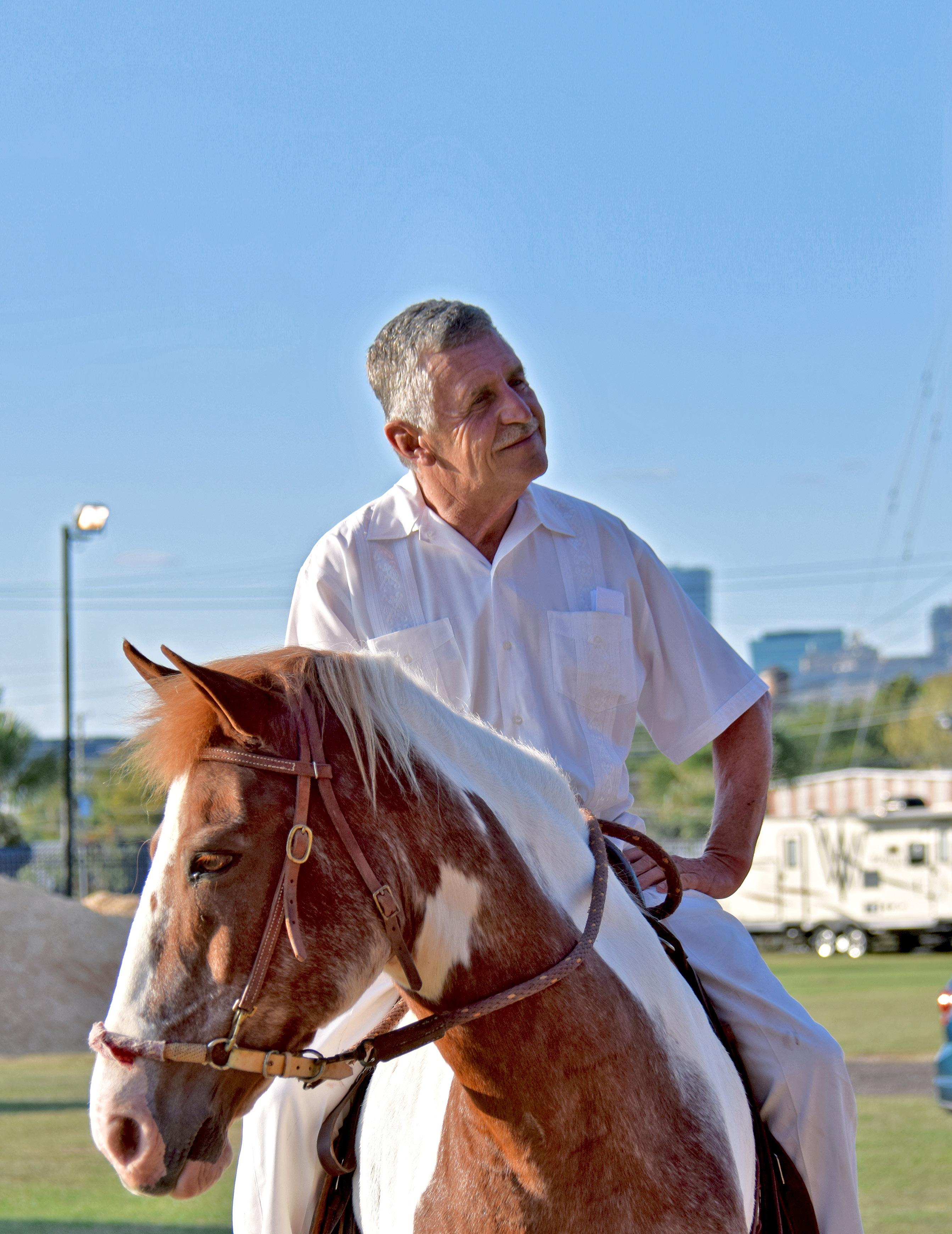

FALL 2023 THE VERSATILITY ISSUE
Paso Fino, which means “fine step or delicate walk” in Spanish, perfectly describes the Pure Puerto Rican Paso Fino’s natural gait. The Paso Fino is a lateral four-beat gait performed with a short and low action, executed with elegance, poise, and swiftness, resulting in a shock absorbing action which makes it very smooth. The distinctive sound of the Paso Fino is ta-ca-ta-ca-ta-ca-ta-ca. The gait is performed in a gliding, forward movement, without rocking or bumping the saddle. People who cannot ride other horse breeds because of back or other physical problems find that they are often able to ride again due to the extremely smooth ride of the Pure Puerto Rican Paso Fino.
The Pure Puerto Rican Paso Fino’s gait is performed at three speeds. Classic fino is a show gait and is performed fully collected with a fast footfall. The paso corto is executed when the horse is moving forward with medium extension and collection, at a speed similar to that of a trot. The paso corto is an excellent trail gait that if the horse is in good physical condition, can be executed with ease all day long. The paso largo is a ground covering gait with bold, animated, and long strides. Some horses can largo at a speed of up to 25 miles per hour.
The most important characteristics of the Pure Puerto Rican Paso Fino horses are its natural gait and smoothness. These are the qualities that the owners and breeders prize most in their animals. Natural gait and smoothness are what set them apart from other horse breeds. In addition, the Puerto Rican Paso Fino horses have excellent dispositions, great strength, intelligence, stamina, and courage. They are people-oriented horses that are beautiful and proud.
Puerto Rican horses come in a variety of colors with and without markings, and range in size from 13 to 15 hands. Most have long flowing manes and tails. They are remarkably versatile. Contrary to popular stereotypes, they are not just wonderful show and parade horses. They can learn to jump, excel on competitive trail rides, barrel racing, and gymkhana. On the ranch they have a natural born instinct for working cattle. Pure Puerto Rican Paso Fino horses can do anything any other horse can do, do it well, and do it with extreme comfort for the rider.
PUBLISHER
Romualdo Olazábal
EDITORIAL TEAM
Cover Farm
William Arias
History Denisse Cancel
Pedro Burgos
Genetics
Paola Matos
Reflections at 4-beats
Xiomara Arias
Contributing Writers

Stefanie Schermerhorn
Regional News
Xiomara Arias - Kentucky
Ramón Bodón - Texas
Pedro Burgos - Florida
Josey Machado - Oregon
Jennifer Watkins - South Carolina
editor.borntogait@gmail.com
facebook.com/BornToGait

issuu.com/borntogait

To subscribe to Born to Gait, fill the subscription form at mailchi.mp/801e14b3d828/borntogait-subscribe, or send an email with your information to editor.borntogait@gmail.com.

CONTACT & CONNECT
The Versatility Issue • Volume 2 Issue 1 • October 1, 2023
An excerpt of the Paso Fino description from the Pure Puerto Rican Paso Fino Federation website.
Time really flies! It’s been a year since we published the first issue of Born to Gait! A lot has happened during these 12 months... Three issues were published in which we learned about the history of the breed and its genetics. The Equus Survival Trust granted the Puerto Rican Paso Fino full status as a Critical breed in their Equine Conservation List. Our awareness about conservation grew and we are now more committed and motivated. We got together at the Celebration Show last October (look for the photos inside). Sadly, we said goodbye to a dear friend and extraordinary supporter of the Pure Puerto Rican Paso Fino.
The future looks bright for the breed! New babies were born and the breeders got their mares pregnant again. The PPR Paso Fino Federation has a fresh logo and a new website. An online searchable database of their registry will soon be launched. And cooperative ties are strengthening between the organizations in Puerto Rico and the Federation.
Changes are also happening on a personal level. Last month we closed our business in Puerto Rico and we are about to put our house for sale. If everything goes as planned, we should be moving to Ocala, Florida, later this year to continue promoting the breed from “the horse capital of the world” (I apologize to my friends in Kentucky, who also claim this title).
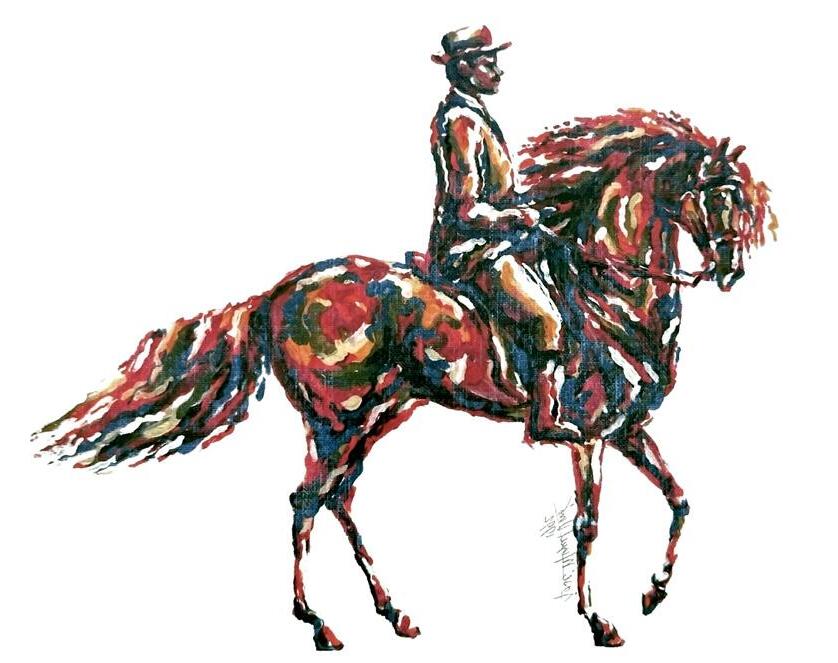
In reviewing this past year, I would have to say that life—and the Pure Puerto Rican Paso Fino breed is an essential part of our lives—is dynamic. Everything moves, changes, evolves. Despite the good or difficult times we endure, our journey must continue... We must keep promoting, protecting, and conserving our breed. But above all, we must continue loving our horses and cultivating the friendships we have made along the way.
Thanks for being part of our lives and welcome to Born to Gait’s second year!
A few months have passed since I wrote this note. I am very sorry that we did not publish this issue sooner. Enjoy it and I promise the next one won’t take as long!

1 BORN TO GAIT • FALL 2023 PUBLISHER’S NOTE
Illustration by Arq. José Vivó.
Publisher’s Note
In Memory of Gail Brown
Smoothness and Versatility, the Heart and Soul of the Puerto Rican Paso Fino
Margarita’s Paso Fino Farm: Versatile Horses Achieving Their Full Potential

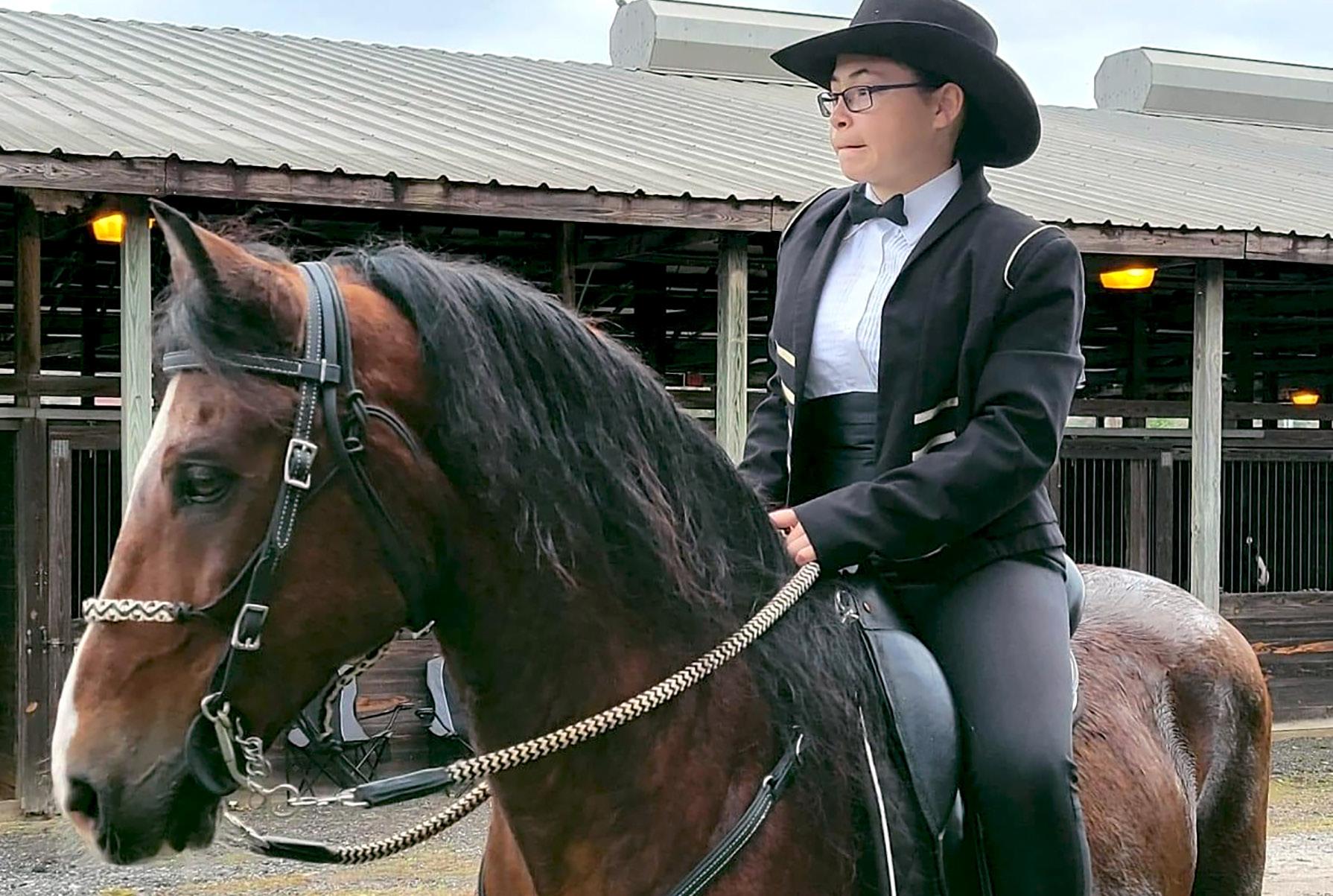
About the Pinto Patterns in the Puerto Rican Paso Fino
Paso Fino (Puerto Rico)

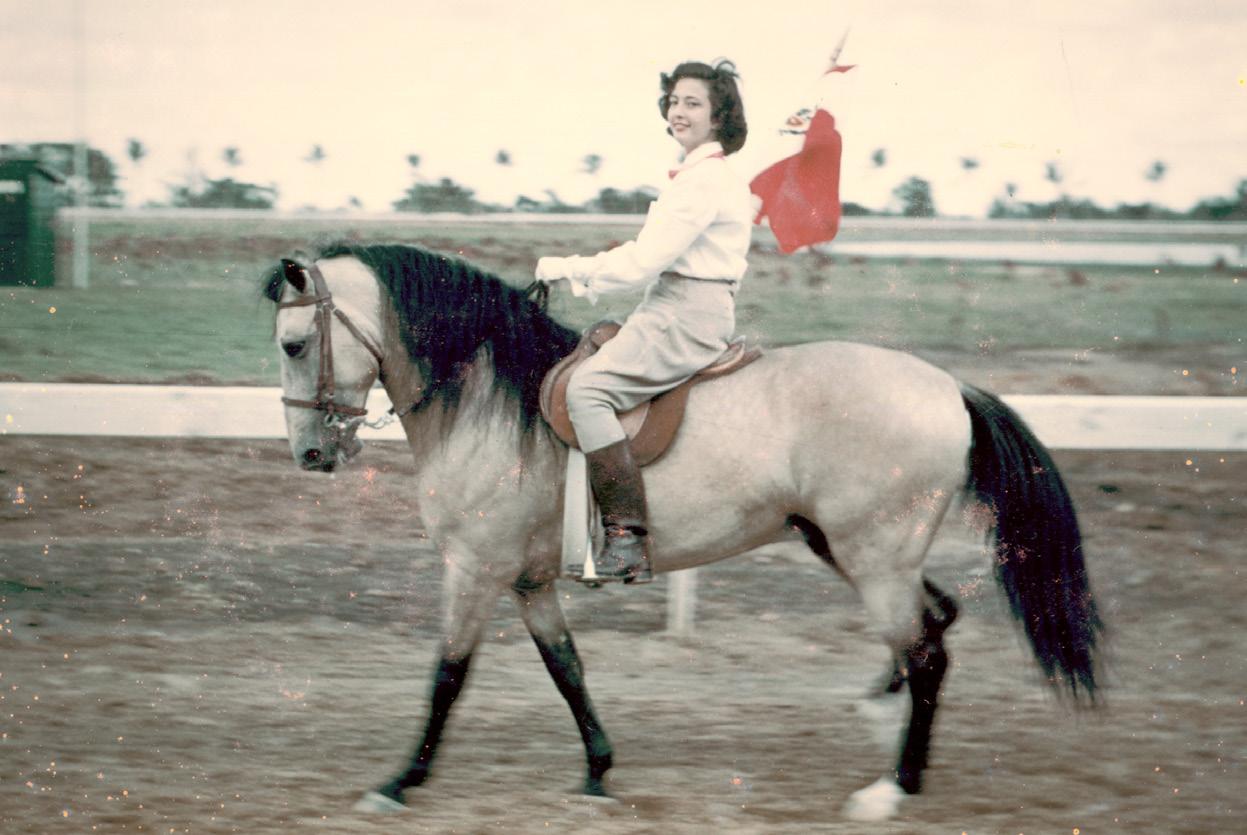
The Genetics of the Color Spectrum in Our Puerto Rican Paso Finos
Versatility and Diversity: Rationale for Breed Preservation
Regional News
Annual Celebration Show 2022
2 BORN TO GAIT • FALL 2023
IN THIS ISSUE
3
12 18 21 1 30 34 40 22 4 34 12 22
Photos On the
cover Clifford Fisher and Brillador de Pisgah at the 2019 Celebration Show in Columbia, South Carolina.
4
It is with lamenting hearts that we share with you the passing of one of our beloved breed’s most ardent supporters, Gail Padgett Brown (December 7, 1950 - November 12, 2022). In addition to being the CEO of Palmetto Pride Paso Fino Farm (founded 1988), Gail has been an active member of the Pure Puerto Rican Paso Fino Federation of America (PPRPFFA) since its inception in 1987 as well as its president since 1995. Gail was preceded in death by her lifelong friend and husband James Odell Brown (1948-2020). Today, they are reunited, watching us pursue the Puerto Rican Paso Fino passion!

Born to Gait had the delight of showcasing Palmetto Pride Paso Fino Farm and Gail Brown in its inaugural issue in the Spring of 2022. Shortly after its release, Gail quipped that she never thought she would be a “cover girl.” Reflecting on that featured farm article we are so grateful to have had that opportunity where she shared with you not only some of the salient points of her life but also her views about the breed and its potential future. Recalling the question,
In Memory of Gail Brown
By William Arias Jr.
“What has been the greatest challenge faced by the Puerto Rico Paso Fino?” She shared, “making people aware of this versatile breed.” As the smoothest riding horse in the world, it can do almost anything other horses have done while also executing it comfortably. It is an intelligent horse eager to learn. Some of the misconceptions about the breed stem from the show horse emphasis on the Fino gait. Whereas only a small percentage of horses exhibit the Classic Fino gait, all horses have the Corto and Largo to varying speeds. This larger percentage of horses will appeal to the majority of riders for their versatility and comfort. Perceptions must be challenged that not all Paso Fino horses must be Classic Fino.
Gail’s indelible legacy on the Puerto Rican Paso Fino on the mainland United States is a matter of record and fact! A multitude of horses had there beginnings at Palmetto Pride Paso Fino Farm: Pleasure, Performance, and Fino. As we move forward let’s remember and keep alive Gail’s hope, that our breed continues to be promoted, protected and, preserved for the enjoyment of future generations.
3 BORN TO GAIT • FALL 2023
Smoothness and Versatility, the Heart and Soul of the Puerto Rican Paso Fino
Romualdo Olazábal come from a family of horse owners and breeders: Paso Finos on his mother’s side and Thoroughbreds on his father’s. Now in his 60’s, he has spent his entire life associated with the Paso Fino horse breed. His breeding program at Hacienda Pisaflores seeks to conserve the characteristics that make the Puerto Rican Paso Fino the smoothest saddle horse in the world.
The history of the horse in America began on November 27, 1493, when Christopher Columbus, on his second voyage, landed 25 horses and mares belonging to the Hermandad de Granada on the island of Hispaniola (now the Dominican Republic). By decree of the monarchs Ferdinand II and Isabella I, Columbus was required to have twenty lancers embarked with their horses, and five of them were to bring mares as a second mount. The monarchs intended for these horses to be of superior quality. Also, it is reasonable to presume that those men, warriors by profession, would not risk their lives bringing inferior horses.
The first horses that landed in the Dominican Republic were of Iberian-Berber descent. Those were the predominant horses in Spain by the 15th century and were the precursors of the modern Andalusian (PRE) and Lusitano breeds. In the Middle Ages, horses were rarely differentiated by breed, and they were rather classified by type. The Conqueror’s horses were from a type known as Jennet. Those horses were of small stature, rustic, strong, agile, and hardy with the courage to excel in battle, and were often amblers. In his treatise from 1562 Il Cavallarizzo, Claudio Corte wrote that the Jennet was the most commonly used horse by the Spanish light cavalry.

In May 1509, less than two decades after their arrival in the Dominican Republic, a group of these horses was taken to Puerto Rico. Juan Ponce de León brought them on Alonso de San Martín’s ship. By the end of that same year, Juan Ponce de León had almost all his mares at his Hacienda Ziguayagua, located in Higüey (Dominican Republic), transferred to the island of Puerto Rico. In the following months, more mares were brought to the island. Pedro Moreno, Jerónimo de Bruselas, Cristóbal de Sotomayor, and Luis Fernández de Alfaro, all brought broodmares from the Dominican Republic. We know that as early as 1511, Juan Cerón had a cavalry force established on Caparra, the first capital of Puerto Rico. We also know that between 1512 and 1513, a total of 215 more horses were introduced through the ports of San Juan and San Germán. Breeding on the island increased in such a way that imports of horses from the Dominican Republic were considerably reduced. Between the years 1516 and 1517, there are only indications of 12 horses imported from the Dominican Republic.
Although it is logical to think that there were stallions among the horses imported to Puerto Rico, the first specific reference to the introduction of a stallion to the island is from 1528, when permission was granted to Antonio de la Gama to bring a stallion “of good breed.” Then, in 1535, a
4 BORN TO GAIT • FALL 2023 EDITORIAL
Romualdo Olazábal
second reference appeared when Asencio Villanueva was authorized to bring stallions from Andalusia for his hacienda in Jayuya.
Horse breeding continued to grow over the next few years and a horse export business was established on the island. In 1521, Juan Ponce de León took fifty horses from Puerto Rico to Florida (there is no evidence that these horses survived). Charles Ehinger and William Sayller in 1528 and Nicolas Federman in 1530, both agents of the German Welser bankers, acquired horses in Puerto Rico for the conquest of Venezuela. Also, in 1530, Antonio Cedeño took horses from Puerto Rico to the island of Trinidad. And between the years 1533 and 1534, at the request of Francisco Pizarro, his brother Hernando Pizarro and Francisco Mejías came to buy horses for the conquest of Peru.
I wanted to make this brief historical journey so we could understand two things. First, the horses that arrived on the island were horses destined for war; and second, the breeding that was established sought to produce horses with those same characteristics that could be exported for the conquest of the new lands in Central and South America.

While the large farms established a breeding-exportation business, the settlers needed horses for everyday use.
Horses to transport themselves and their agricultural products, horses to work the land, and horses to work with the cattle. It was there, in the need of the humble Puerto Rican “jíbaro,”1 where the characteristics that would later give birth to the Paso Fino horse began to be refined.
With time, the demand for conqueror horses declined, and the smooth versatile type of horse became the new commodity. There are two important dates that we must keep in mind. Since we have explained these in detail in previous issues, I will only mention them briefly. In 1797, the French naturalist André-Pierre Ledrú wrote about the “indigenous horses” with a different kind of gait. He said these horses “have neither trot nor the ordinary gallop, but rather a kind of amble, a gait so hasty that the most attentive eye cannot follow the movement of their legs.” He was describing the Paso Largo gait at Las Carreras de San Juan.
The second date comes from Adolfo de Hostos’ book San Juan, Ciudad Murada. He mentioned that by 1860, a group of breeders in Puerto Rico “came to produce, thanks to selection, a breed known by the name of Paso Fino Horse, much admired in the Antilles.”
The original export wave of the earliest years of the Conquest was over, but, by 1797, there was a native type of horse on the island that, by 1860, was widely known as Paso Fino. The haciendas took the smooth gait the jibaros appreciated so much and perfected it. Selectively bred for a comfortable ride, they produced the finest saddle horse in the Caribbean (and the world). The second export wave was not because of the ability of these horses to perform at war, but because of their smooth and versatile gait.
Rolls-Royce is the finest brand of cars. Diamonds are the finest piece of jewelry. Silk is the finest of all textiles. Finest denotes the highest quality, the best among the best, la crème de la crème. This is what the “fino” in Paso Fino stands for: the finest of all the gaiting horses because this is the breed with the finest gait. Thus, Puerto Rican Paso Finos became the admiration of neighboring countries, who sought to improve their native breeding.
There are records of several exports of Puerto Rican Paso Fino horses to the Antilles and Dominican Republic during the first half of the 19th century. In the second half, Puerto Rican Paso Finos were taken to Cuba in 1883 and 1899. Puerto Rican horses were again exported to the Do-
5 BORN TO GAIT • FALL 2023
The classic Iberian Jennet, from a contemporaneous altar retablo, depicts the surrender of Granada in 1492. Source: Wikipedia.
minican Republic in the years 1915 (Teodoro Vilella), 1920 (Agustín Pichardó), 1930 (Gregorio Kuinlan), in the 1940s and 1950s (Rafael Leonidas Trujillo), and the early 1970s (Pompilio Brouwer and Bienvenido Leonardo). We also know of Puerto Rican horses taken to Venezuela and Costa Rica. And we cannot forget the horses that were imported to the mainland during the 1960s and the following years, which became the foundation bloodstock of the American Paso Fino. Of all these exports, only a small population of Pure Puerto Rican Paso Finos remains in the United States under the protection of the Pure Puerto Rican Paso Fino Federation of America.
Let’s go back for a moment to explore another angle in the history of the Puerto Rican Paso Fino. Deb Bennett, in her book Conquerors, The Roots of New World Horsemanship, explained the influence of the Spanish Jennet in the Americas. She wrote: “A very interesting biological law dictates that the earliest ancestors are likely to have the greatest impact on the physical nature of succeeding generations.”
I believe this comment from Bennett is critical, especially if we consider the slight influence of other breeds on Puerto Rican horses. Besides the imports of horses from the 16th century, we know that by the end of the 19th century,
Eugenio Vergés imported two Morgan horses to his farm in Guayama. A few years later, in the first decade of the 20th century, Dr. Mays imported a Kentucky Mountain Saddle Horse to the Mayagüez Experimental Station. In the 1920s, the sugar mills imported Arabian horses and Tennessee Walkers... But how much did these horses influence the genetics of the Puerto Rican Paso Fino breed?
I want to share a story. Arco Iris was one of the two main stallions at the Central Mercedita in Ponce; the other was Copita. Wilfredo Beltrán bought Arco Iris when he was 16 years old and, in his career as a stallion in Beltrán’s hands, he produced Kofresí, Don Toquí, Carabalí, Cosita Linda, Vicky, Perla Fina, and Bizcocho, among a handful more. In total, there are about 15 registered offspring of Arco Iris, and only two of them are from his time as a stallion in Central Mercedita. That’s not to say he wasn’t used while there, just that almost all his offspring were workhorses that were never registered. That was the standard practice at sugar cane plantations; horses were gelded and used for work.
Various scientific studies confirm the almost zero influence of exterior blood in the Puerto Rican Paso Fino. The research from 2022 made by the University of Puerto Rico (Mayagüez Campus), together with students from Oakland University, concluded that the Paso Fino horse has its roots in the creole horse that was developed on the island from the breeding stock the Spanish brought during the Conquest. This revalidates the conclusions of Dr. Gus Cothran who in 2007 wrote: “the Puerto Rico Paso Fino appears to be clearly related to Old World Iberian horses and may be one of the closest representatives left of the type of horse the Spanish brought to the Americas 500 years ago.”
The genetic traits of the breed have been conserved since the Conquest times, but the uses of the horses changed with time. Las Carreras de San Juan began in 1637, and by 1650, according to historian Adolfo de Hostos, Puerto Rico was living “in the middle of the Equestrian Era.” The horse was the center of Puerto Rican life; from the landowners to the jíbaros, everyone participated in festive and sports activities that extolled the horse. In the following centuries, we will see Puerto Ricans enjoying their horses in endless activities like Paso Largo and Andadura races; “La Carrera de las Sortijas”2 (Race of the Rings) and other equestrian games; the glass of water challenges; and many contests were

6 BORN TO GAIT • FALL 2023
Equestrian portrait of Philip IV of Spain. Painted by Diego Velázquez in 1635-36. The painting is exhibited at the Museo del Prado in Madrid, Spain.
the fastest, the strongest, the most beautiful and the best gaited were awarded.
When the “Asociación de Dueños de Caballos de Silla de Puerto Rico” (Puerto Rican Saddle Horse Owners Association) was founded in 1943, it had three objectives: to promote the riding, breeding, and improvement of Puerto Rican Paso Fino saddle horses; organize contests and exhibitions, and establish a genealogical record. Their first contest took place that same year, and it included the following categories:
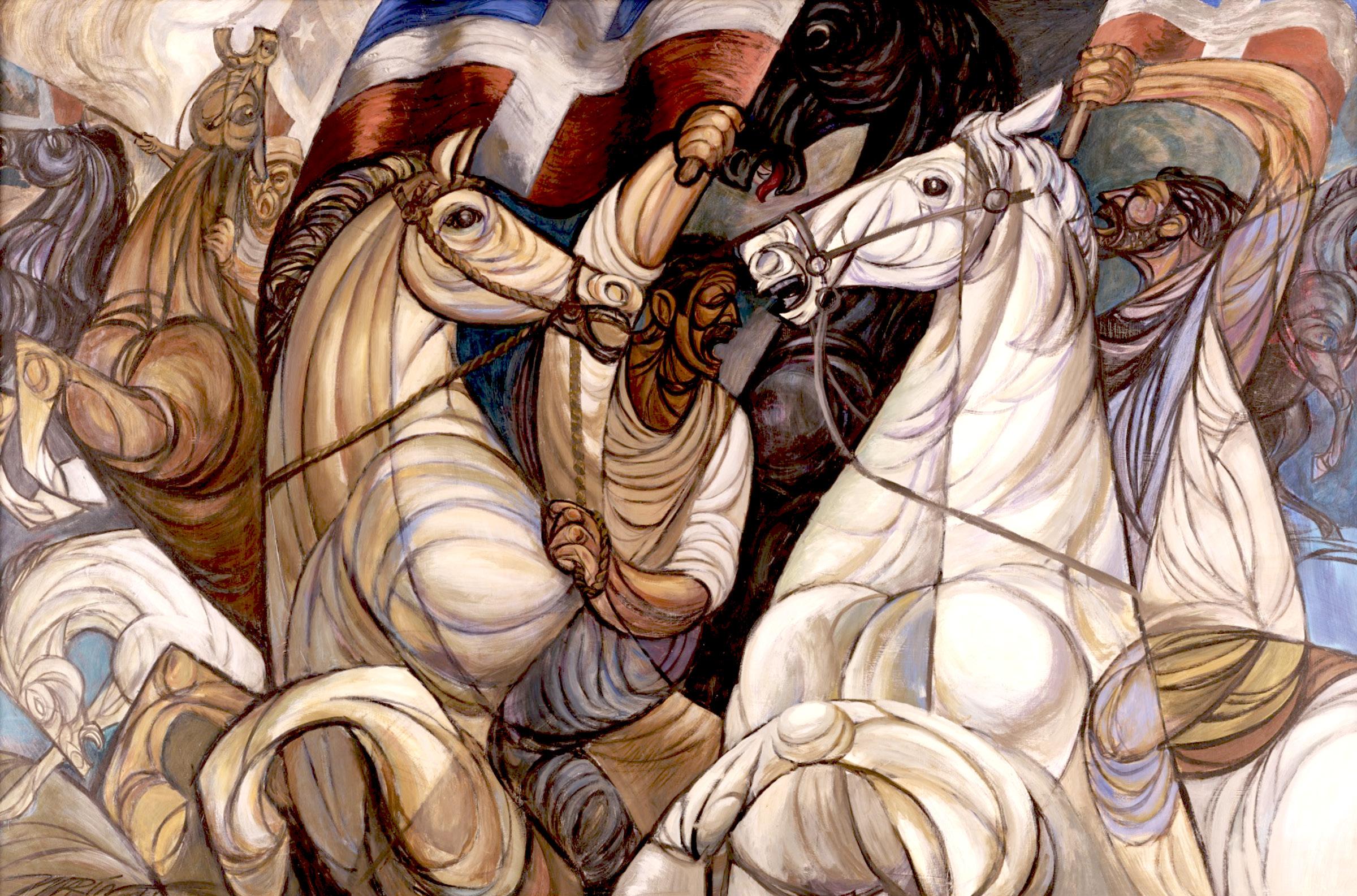
1. Potro de Paso Fino (Paso Fino Colt)
2. Caballo de Paso Fino (Paso Fino Horse)
3. Yegua de Paso Fino (Paso Fino Mare)
4. Caballo de Andadura (Andadura Horse)
5. Caballo de Volteo (Farm Work Horse)
6. Caballo de Bellas Formas (Bellas Formas Horse)
7. Yegua de Bellas Formas (Bellas Formas Mare)
8. Caballo de Condiciones Generales (Versatility Horse)
9. Mejor Semental (Best Stallion)
10. Mejor Yegua de Recría (Best Broodmare)
In 1965, this organization changed its name to “Federación del Deporte de Caballos de Paso Fino de Puerto Rico” (Puerto Rican Paso Fino Horse Sports Federation). In later years, the other two Paso Fino sports organizations on the island would emerge: “Asociación Nacional” and “Asociación Insular.”
What is important to know is that the change of name reflected the change in how the breed was seen. From a saddle horse owner association to a Paso Fino sports federation. And by Paso Fino sport, the organizations on the island meant the Paso Fino classes exclusively (equivalent to the Classic Fino on the mainland). The more importance the organization placed on the Paso Fino sport, the less important the versatility became. Andadura, Volteo (Farm Work), and Condiciones Generales (Versatility) classes were dropped, and Bellas Formas declined in interest and became
7 BORN TO GAIT • FALL 2023
El Grito de Lares, Augusto Marín, 1961, Instituto de Cultura Puertorriqueña (Google Arts and Culture). The painting depicted the events of September 23, 1868, when about 400 men took the town of Lares, Puerto Rico.
an accessory class.
While this happened in Puerto Rico, the story of the sport in the continental United States took another direction. Americans fell in love with the Puerto Rican Paso Fino because of its versatility, so, when the sport was picking up, show classes were designed to embrace and enhance the diversity of gaits in the breed. The Pleasure and Performance classes evolved from the Condiciones Generales class, which is why the horses are shown at Paso Corto and Paso Largo instead of the Fino gait. The glass of water challenge is still practiced. And there are many races, fun classes, and costume classes that evoke the time when the breed was considered a true saddle horse.
There are two noteworthy images used to describe the Paso Fino horse. For example, I love when enthusiasts say
that the Puerto Rican Paso Fino is the Cadillac of horse breeds. They really are! They are the smoothest and most comfortable ride of all horse breeds. The Paso Fino breed was developed as a saddle horse, a horse meant to be ridden for pleasure or transportation. It was supposed to be smooth and comfortable and sound and calm and easy to control. But it was also developed to do farm work, so they have strength and brío, which is the desire to work. As we see at the beginning of this article, their ancestors, the Jennet that the Conquerors brought to the New World, were war horses and that spirit is still inside them. But the Jennet was also a popular riding horse in Spain because of its comfortable amble, a characteristic that was improved when the Paso Fino gait was developed. So instead of a Cadillac, I think of the Puerto Rican Paso Fino as the ‘4WD all-terrain SUV with the luxury package included’ of horse breeds.
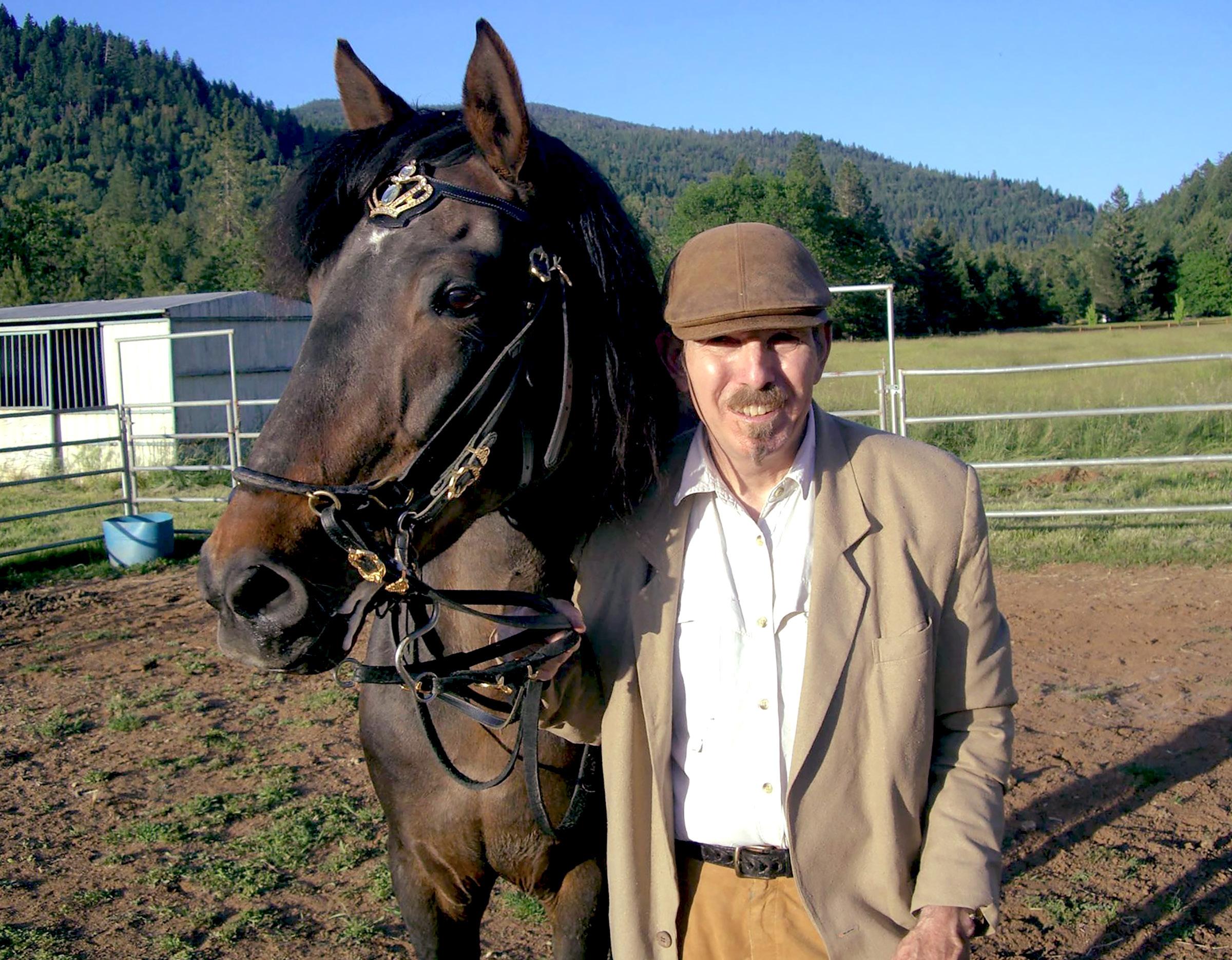
8 BORN TO GAIT • FALL 2023
Will Sanders and his Puerto Rican Paso Fino horse Legolas (Carroberto de CdC x Caricia de CdC). Will is the author of the book Baroque and Academic Training Concepts, Made Easy to Understand and Apply for You and Your Horse. Legolas is portrayed on the front and back cover of his book.
The other image is that of a prima ballerina dancing with such grace that it makes her movements look easy. Our breed has had several horses named after ballet terms (Adagio, Allegro, Allegretto, Bailarina, Ballon, Cabriola, Danza, and others). There is no doubt that Puerto Rican Paso Finos are graceful horses, but, like ballerinas, they are also great athletes. And like any good athlete, our horses can excel in any sport for which they are trained.
Both images speak about versatility. Horses that can do-it-all, do it with style, and do it with comfort. That is the essence of the Puerto Rican Paso Fino. That is the heritage they received from their ancestors, which our forefathers perfected to create the best saddle horse breed in the world.
When we speak about the versatility of the Puerto Rican Paso Fino, people automatically think of the Corto and Largo gaits, but these horses are capable of so much more. For example, do you know that some lines have “cow sense” and make excellent ranch horses? Or do you know the Cupido line is highly valued by Andadura breeders because of the speed they can achieve in their Andadura races?
Puerto Rican Paso Fino can do almost anything. There is an owner in California that does dressage with his Paso Fino. There is another that uses her horse for rescues in Oregon’s mountains. Another one in South Carolina taught her horse to jump, and she also does trick-riding on him. Puerto Rican Paso Finos are being used for cow work, running barrels and poles, and long-distance events such as endurance and pleasure long-distance riding. There is a Puerto Rican mare that was trained as a police horse in South Carolina. She not only passed all the tests but also broke the record time in the obstacle test and has done wonderfully in the field. On the island, a group of young enthusiasts is rediscovering the breed’s versatility and they are competing very successfully in dressage with their Paso Fino horses. A young woman trainer is also doing bridle-less riding in her training. You name it, Puerto Rican Paso Fino can be used for almost any equestrian discipline.
But that is not all. Their comfortable gait makes them wonderful therapy horses. People who have a hard time riding due to old age and those who have had back or knee
 Rigoletto ridden by Miss. Simonpietri in the equitation class.
Rigoletto ridden by Miss. Simonpietri in the equitation class.
injuries and have been told that they will not be able to ride again could find new hope in a Puerto Rican Paso Fino.
I had to admit that my vision of Puerto Rican Paso Fino’s versatility has been biased since childhood. When I speak or write about what these horses are capable of, I cannot help thinking about Rigoletto, my grandfather’s favorite horse.
My grandfather, Francisco Rodríguez, and his brother-in-law, Jaime Vallés, were two well-known breeders in their time. Many important horses were born at our farm. Possibly the one you would know best is Alicante. But of all the horses owned and bred by my grandfather, Rigoletto was special for him. He was a son of Guamaní out of the mare Ballon, a daughter of Niño. He had nice conformation, excellent gait, and exceptional temperament. I was just a child in the early 60s, but I remember my grandfather riding Rigoletto at the farm during the week, inspecting the pastures and checking on the livestock; then, on Sundays, it was either a horse show or a cavalcade with his friends. At shows, he was exhibited in Bellas Formas, Paso Fino, Condiciones Generales, and “Equitación” (nonprofessional riding). Rigoletto was the horse that could do it all: work, pleasure, and show. I grew up with this idea of the Puerto Rican Paso Fino: horses that are capable, functional, and versatile, and all of this is done with the most comfortable gait for its rider.


Every horseperson has a reason to own or bred a particular breed of horse. Mine is a matter of culture, pride, and love. I have known the Puerto Rican Paso Fino since birth. I grew with them, learned to ride on their back, and they have been a part of my life for over six decades. During all those years, we participated in many activities, mostly show-related. But I also went on cavalcades with my Paso Finos. I remember one time there was a Christmas parade through Old San Juan, and I took my Fino mare; people asked me what I was doing on her as if a Fino should be exclusively for the show. The same happened on a cavalcade at a big farm; we were celebrating a friend’s birthday and I went on a Fino colt. Pure Puerto Rican Paso Finos can handle everything. They are athletes and are like luxury SUVs, remember?
Those are my reasons, but what are yours? Maybe you want a comfortable saddle horse capable of giving you the smoothest ride. Perhaps you are looking for a horse you can work with on your ranch. Or one that will participate in endurance or your favorite equestrian discipline. Maybe you are interested in showing. Or, possibly, you are trying to get back on the saddle after an injury. No matter your reason to own a horse, the Puerto Rican Paso Fino is the answer.
10 BORN TO GAIT • FALL 2023
Bibliography:
Delgado Mercado, Osiris. El Caballo en el Proceso Histórico y Cultural de Puerto Rico. Publicaciones Puertorriqueñas, 2007.

Laracuente, José M. Historia Cronológica del Caballo Puertorriqueño (Revisada y Actualizada). Puerto Rico, 2011.
Bennet, Deb. Conquerors, The Roots of the New World Horsemanship. Amigo Publications, California, 1998.
Ledrú, André Pierre. Viaje a la Isla de Puerto Rico en el año 1797. Translated to Spanish by Julio L. De Vizcarrondo. Imprenta Militar de J. González, Puerto Rico, 1863.
De Hostos, Adolfo. Historia de San Juan, Ciudad Murada. Instituto de Cultura Puertorriqueña, Puerto Rico, 1966.
Alonso, Manuél A. El Gíbaro: Cuadro de Costumbres de la Isla de Puerto Rico. Barcelona, España, 1849.
Wolfsberger, W.W., Ayala, N.M., Castro-Marquez, S.O. et al. Genetic diversity and selection in Puerto Rican horses. Sci Rep 12, 515 (2022). https://doi.org/10.1038/s41598-021-04537-5.
Cothran, E. Gus. Analysis of Genetic Diversity in the Puerto Rico Paso Fino. Texas A & M University, 2007.
Endnotes:
1 “Jíbaro” is a term used for a rural inhabitant of the mountains of the island; similar to the term hillbilly used on the mainland. Today is used as a moniker of pride in Puerto Rico.
2 The unmarried young women wrote their names on pieces of paper, and these were tied with ribbons to rings and hung up so that the young men could pass at “paso largo” with their horses and a stick. Those who can grab a ring with its stick had the honor of the first dance with the girl whose name was on the paper they grabbed. La Gran Enciclopedia de Puerto Rico explains that the race of the rings is one of the most beautiful games in the town festivities.
Photos:
11 BORN TO GAIT • FALL 2023
Far left, Rigoletto ridden by his owner, Francisco Rodríguez, at a cavalcade. Bottom left, Rigoletto and his owner working at the farm. Above, Francisco Rodríguez and Rigoletto got the first prize in the Bellas Formas class.
Photos of Rigoletto from Francisco Rodríguez, Romualdo Olazábal, and David Lang collections.
Margarita’s Paso Fino Farm: Versatile Horses Achieving Their Full Potential
 William Arias Jr.
William Arias Jr.
We all want versatility: the one tool that can do it all (or at least most of what we want). Knife collectors value their Swiss Army Knives. Woodworkers impress with their Shopsmiths. Where would cooks be without the food processor that grinds, chops, whips, slices, shreds, mixes, juliennes, and more! We even show it in the vehicles we purchase. J.D. Powers, the marketing research company that analyzes market data and produces rankings, reports that over 80% of car sales are SUV and Trucks1. That’s no surprise since we value versatility in almost everything else. You can look great in a SUV or truck whether going out to dinner or a fancy event while still being able to use the same vehicle to drive up to the trailhead pulling a trailer or perhaps picking up hay and feed.
However, in the interest of maximizing production, sometimes we default to the specialized. The knife collector probably doesn’t use the Swiss Army fork at home: it’s kinda clunky. For the woodworker, it takes time to shift between tools so a large manufacturer would not use a Shopsmith. A production level kitchen uses individual commercial grade tools to process foods. And of course, we are still making cars: commuting at 15 miles per gallon gets expensive. Specialized tools and variety are still important attributes.
Regardless, we still crave versatility. The Pure Puerto Rican Paso Fino can do anything. Whether it’s roping, sorting, trail riding, eventing, jumping, barrel racing, pole bending, galloping, endurance, dressage, drill team, physical therapy, or pulling a wagon, this versatile horse can do it all but with a unique trait: you can work, play and ride all day in comfort! Other breeds excel in specific areas but none can claim to be the smoothest horse in the world.
History has demonstrated the versatility of these horses over the centuries in Puerto Rico and today several owners throughout the United States continue to successfully engage these horses in various disciplines. In this issue of Born to Gait, we travel to Lexington, SC where Margaret and Clifford Fisher share the Paso Fino passion displayed at Margarita’s Paso Fino Farm. Their horses have done so much and continue to do more.
As you travel to the farm you would not expect to find such a large parcel in this suburban area. I recall my first visit while pulling our 44 foot combination through residential streets hoping not to put myself into a difficult situation and breathing a sigh of relief as we entered the sprawling acreage. At one time this was the outskirts of the capital city of South Carolina, Columbia, and primarily an agricultural
12 BORN TO GAIT • FALL 2023 COVER FARM
William Arias Jr. is a retired U.S. Navy Commander. William is a native of Puerto Rico, and has dedicated his retirement days to conserving the Puerto Rican Paso Fino. He owns Hacienda Borikén in Kentucky along with his wife Teresa.
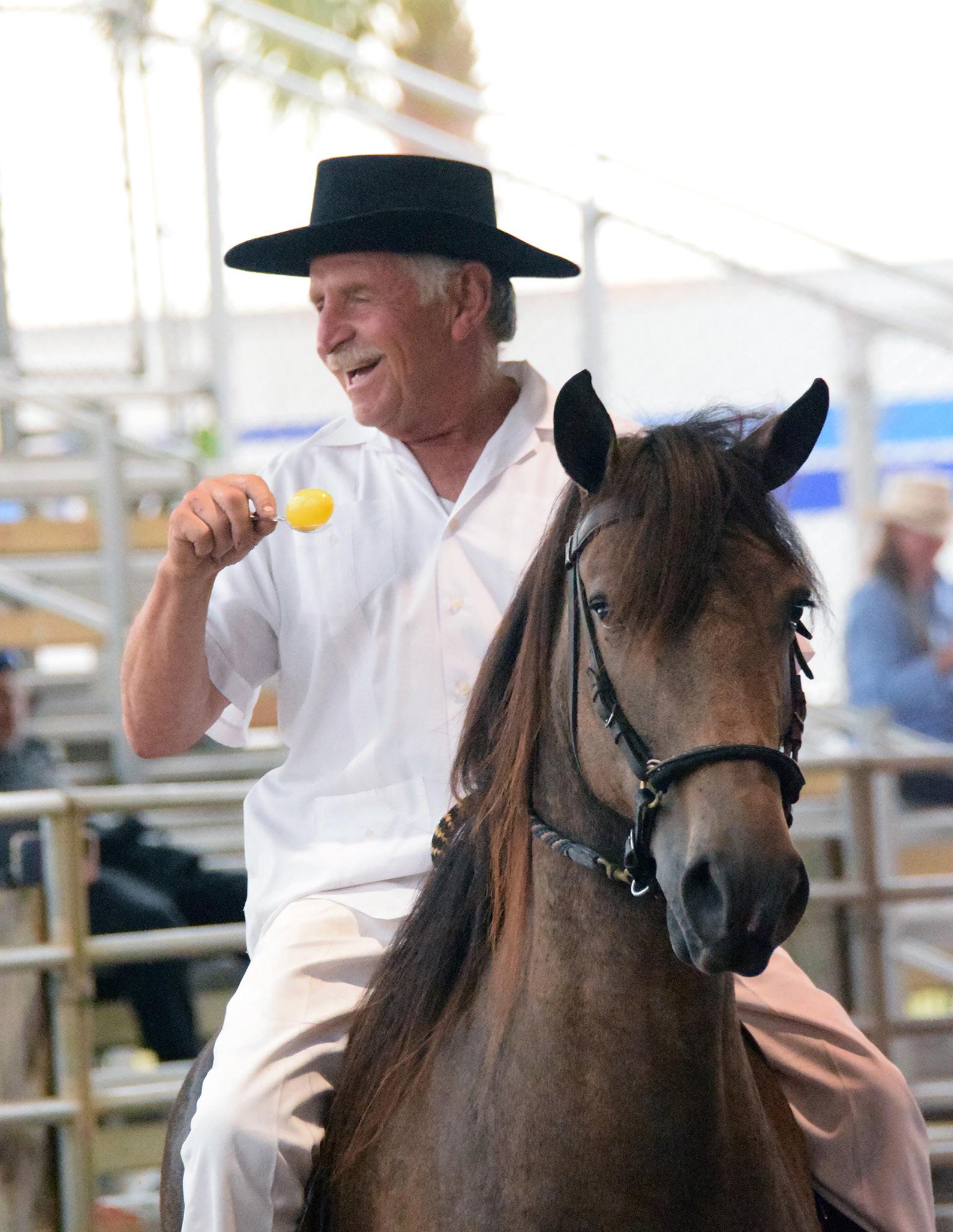
zone. But today the two cities, and others, seamlessly meld to form the greater Columbia metropolitan area. However, regardless of the encroaching subdivisions with single family homes surrounding, this family homestead stands tall. The 68 acre property shares multiple paddocks, a large 8 stall barn with many amenities, two homes and a large pond together with Owens-Fisher Construction: the endeavor that pays the bills.
Clifford has always loved horses but growing up in the city made it challenging to indulge in equine activities. Unexpectedly, his construction endeavors facilitated his entry into the Puerto Rican Paso Fino experience. At about the age of 30, his CPA recommended he find an activity in which to lose money. What a better choice than horses! As the adage goes; how do you make a million dollars with horses? Start with two million dollars. By any measure of achievement, the Fishers have been successful.
At about this time, a superintendent on one of the company’s projects had just bought two unregistered Puerto Rican Paso Finos. Clifford had no idea about the difference between a Paso Fino and a Quarter Horse. The superinten-
dent asked if he could leave them on his property for a while and in Clifford’s words, “He did, and here we are.” The Paso Fino journey began!
The first horse at Margarita’s Paso Fino Farm was purchased from Gail Brown of Palmetto Pride Paso Fino Farm. Clifford can’t remember if it was Brisa, which he still owns, or another, but at one time the herd boasted 35 Puerto Rican Paso Finos. Plenty of horses to train and enjoy! After a few dry competitive years, he had his first champion (which was also purchased from Gail for $5,000); Toro Negro, a stallion. At the first show with the three year old horse, Toro Negro swept all his classes. Shortly after the show, Clifford went to visit Gail and a man visiting the farm offered him $10,000 for the stallion. Since this was Clifford’s first champion, and he wasn’t in the sport to make money, he declined. Two weeks later while getting ready to breed him, Toro Negro kicked the stall and would not stop resulting in blowing his leg out. The injuries made him lame so he was gelded and let out to pasture. Toro Negro was put down in November 2022. He enjoyed over 20 years of eating and being petted.
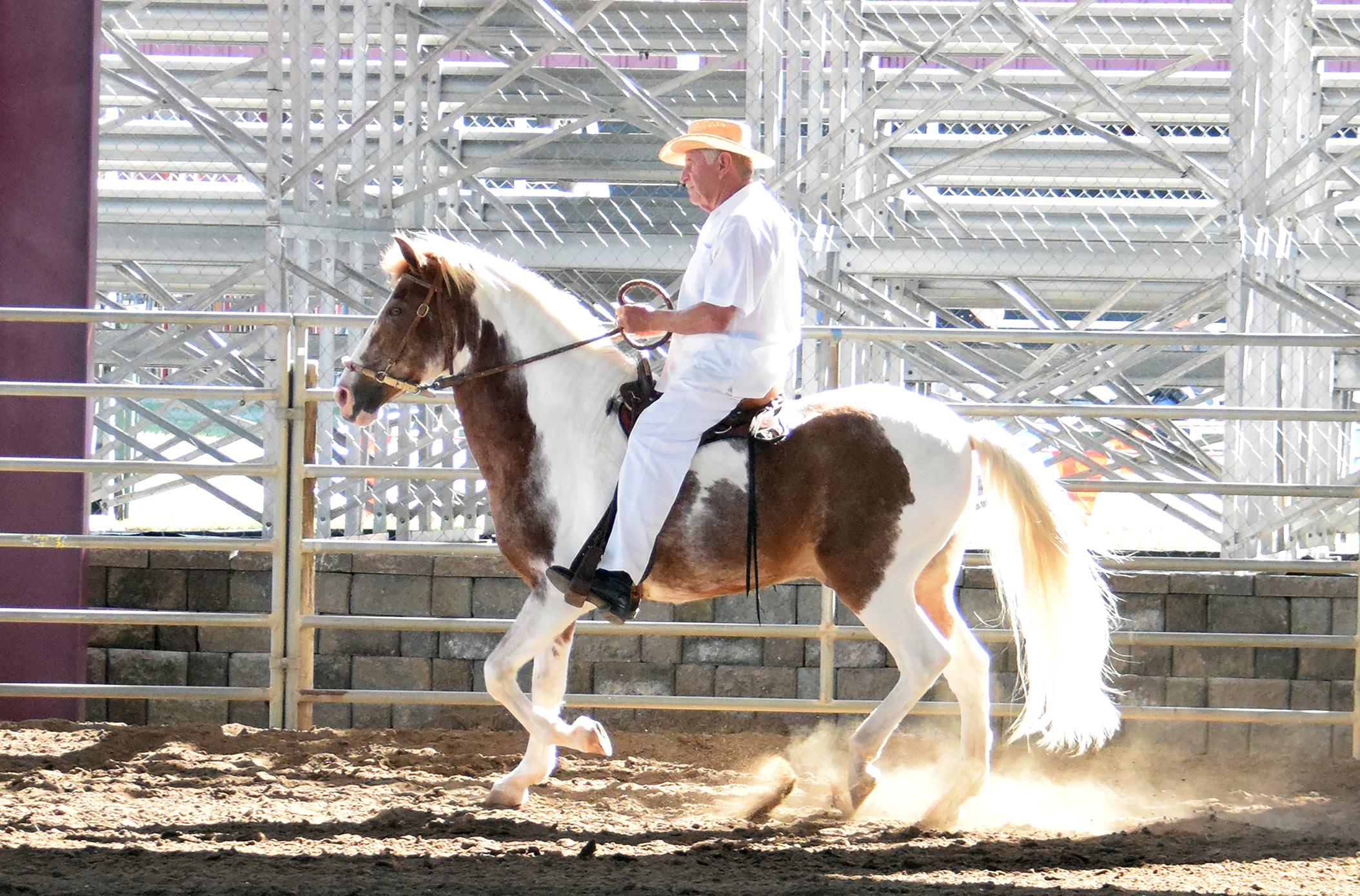
14 BORN TO GAIT • FALL 2023
In addition to the yearly Celebration Show at the South Carolina State Fair, Clifford attended a couple of shows in New Jersey (sponsored by the North Atlantic Pure Puerto Rican Paso Fino Organization), Illinois, and an August show that used to be held in South Carolina. However, Clifford did not just show his horses. He took it on as his mission to use the Paso Fino in all types of activities “Just to prove a point.” Most of his competition were Quarter Horses. Although the horses are smaller and shorter, Clifford successfully proved the point of the versatility of the Paso Fino by excelling in these activities.
Cliffords horses have participated in two real working ranch cattle drives from north of Billings, Montana to the Canadian Border. The Paso Finos excelled at herding cattle! Among the horses was Clifford’s go to steed Brisa. At one drive, an older gentlemen from the ranch who had a roomful of trophies, buckles, and awards for quarter horses had been observing Clifford’s horse for two weeks and asked if he could ride the horse. When he returned from his ride the older man proclaimed that this Paso Fino did everything the Quarter Horse does if not better. He told Clifford that if he ever wanted to sell this horse he would buy it! “The whole family nearly fell over, what in the world is granddaddy saying!” This guy had earned a new respect for the Paso Fino and had never seen one in his whole life. This was a great compliment and validates the versatility of the breed.
Several of Clifford’s horses have been trained to be in the mounted police force. This is not a simple process and includes many different types of activities. One of these events is endurance riding. The mounted police sponsor several 100 and 150 mile endurances races in the mountains of North Carolina. Riders must qualify by participating in Saturday trials of 20 miles over a three month period. Both races had to be completed in 4 days and included a 50 pound backpack; who says Pasos can’t carry a large rider! The course included going up and down hills, over creeks, and several 40 and 70 degree climbs. Riders were required to dismount every 5 miles and then walk 1 mile while holding the horses’ tail to be pulled along and up the hills. Clifford remembers the other riders bouncing up and down the whole day while he traveled smoothly. They could hardly walk when they got off but Clifford walked just fine. Of the 20 horse/rider teams that typically started only 4 or 5 would finish. Clifford’s horses always finished.
Mounted police horses must be able to keep calm in loud and dangerous situations. To prepare their steeds for service and to encourage training, several events are held each year to prepare the mounted police horses. Twice yearly an exhaustive test is conducted. Parts of the obstacle event test includes: opening and shutting a gate, standing in a 10 foot square and firing a gun 6 times while requiring that the horse stays in the square, going over a teeter totter, a bridge, and a power pole. In addition you had to swim a pond and then be exposed to harassment: rockets, firecrackers, squirt guns, bags, or whatever a crowd could do to you. The time limit to complete the course was 10 minutes and the pass rate was typically 1 in 20 with no one completing it the first time. Clifford was told a Paso Fino could never do it. Brisa passed the first time and the next year broke the state record by ten seconds by completing the course in less than 3 minutes. Ultimately, Clifford qualified 3 Paso Finos for mounted police work. War horses throughout history would be proud of Brisa and her pasture mates.
Clifford recalls one mounted patrol where he and Brisa had been assigned to crowd control for a football game at Spring Valley High School in Columbia. This event was

15 BORN TO GAIT • FALL 2023
early in the local re-establishment of the mounted patrol unit and was pivotal in demonstrating its effectiveness. Mounted police are ideal for these environments since they are up high, weapons are safe, and you could see several hundred feet around. If there was a fight you could respond quickly. At this event, as police tried to arrest a person involved in a fight, the suspect decided to run away. The suspect, thinking he could evade police, went into a nearby Walmart. Clifford and Brisa pursued the suspect into the Walmart and upon the greeter’s direction were able to capture the suspect in a stall of the restroom. All mounted police work is done without leaving the saddle so the suspect was handcuffed and led back a mile and a half to the paddy wagon at the high school. This was only one of dozens of interactions in which an adrenaline filled Clifford and his mounts have engaged over the years. Clifford credits Brisa as a small horse (13.3 hands) with a huge heart.
The ever versatile Brisa, with Clifford tagging along, has also participated in the Extreme Cowboy events of the wellknown horse trainer Craig Cameron. During one event in North Carolina, Clifford was able to participate as a mounted police officer competing against professional participants
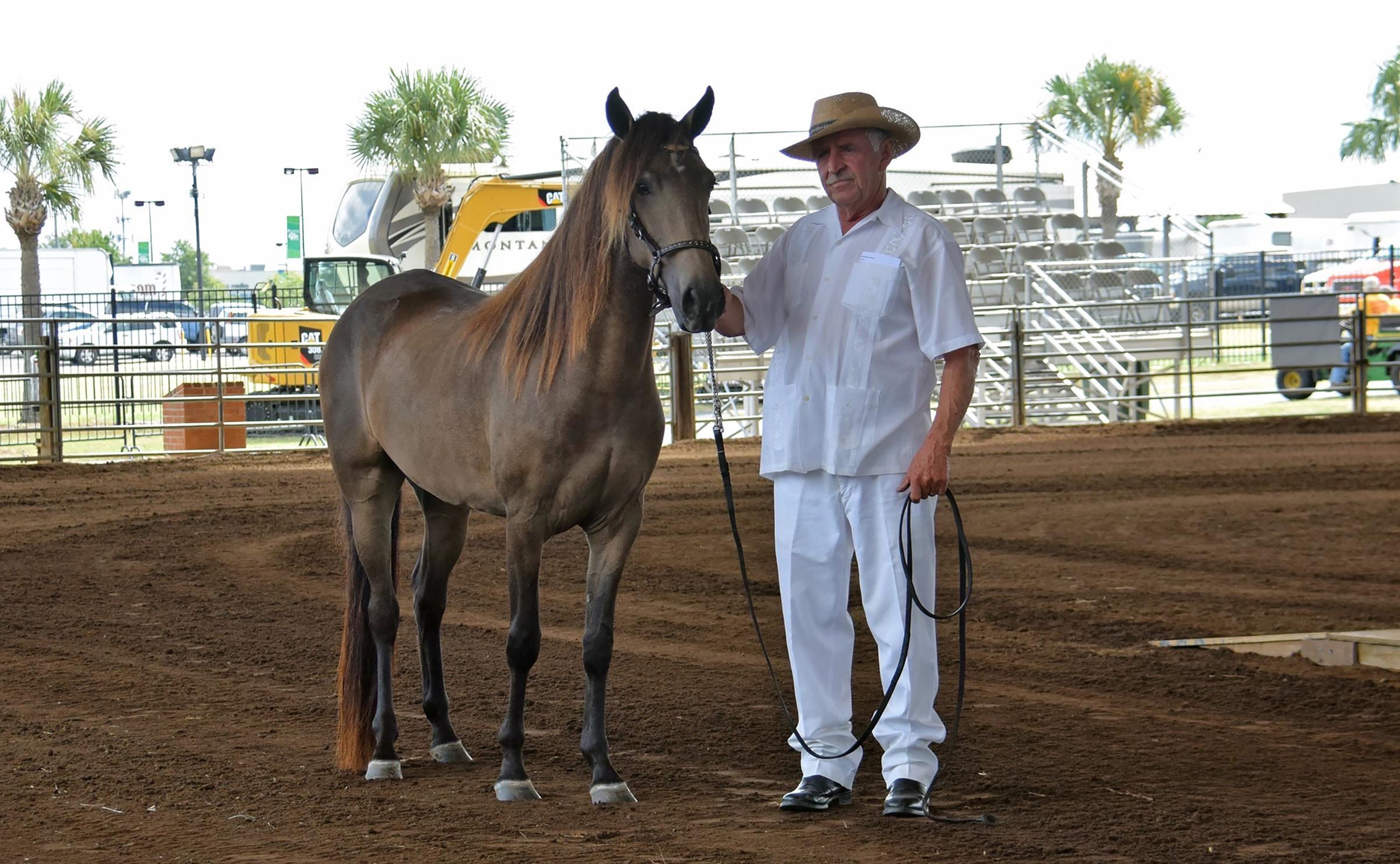
who travel this horse circuit monthly competing for trophies and money. With a multitude of challenging obstacles and about 70 participants, Brisa qualified to participate in the championship round of 4 horses. Craig Cameron had never seen a Paso Fino compete like that! For the championship round, the contestants leave the arena while the obstacles are replaced. Unfortunately, Clifford was a little nervous and messed up Brisa’s chance to emerge as number 1. How many horses of any breed can show up at an event in which they have never participated, against professionals, and emerge as a finalist? Pure Puerto Rican Paso Finos can do it! This link is to the 2018 Extreme Cowboy Association World Championship. No Brisa but it gives you an idea of the competition. https://www.youtube.com/watch?v=AiUVPrJKjWw
Of paramount emphasis for Clifford and of potentially enduring impact for many is the annual production of Jesus is His Name. This is a Broadway quality production where a cast of 103 actors, representing 33 churches, share the Gospel of Jesus through the re-enactment of his birth, life, death, and resurrection. In production since 2016, the free show is scheduled for multiple performances each December at the South Congaree Arena in West Columbia
16 BORN TO GAIT • FALL 2023
SC. For one scene, Brisa, at a walk with Clifford mounted and dressed as a Roman soldier, travels on a platform that is 4 feet high and 8 feet wide in the middle of a screaming crucifixion scene, and an audience of 2500 people, without flinching! Then she stands silently as the scene unfolds. Horse people will come up after the show in awe that Brisa can do this without hurting herself or anyone else. The ultimate compliments are from our fellow horse folks. This is a link to, This Man called Jesus, an older production of the current show with Brisa in the introduction, then again at 7:40, and finally at 1:29:43: https://www.youtube.com/ watch?v=w25sspAioZc . Clifford can also be seen in the production leading his camel and donkey. He also brings his sheep and Macaws for different scenes. I encourage you to visit the website for Jesus is His Name at https://www.jesusishisname.com. The home page will greet you with Clifford and his donkey.
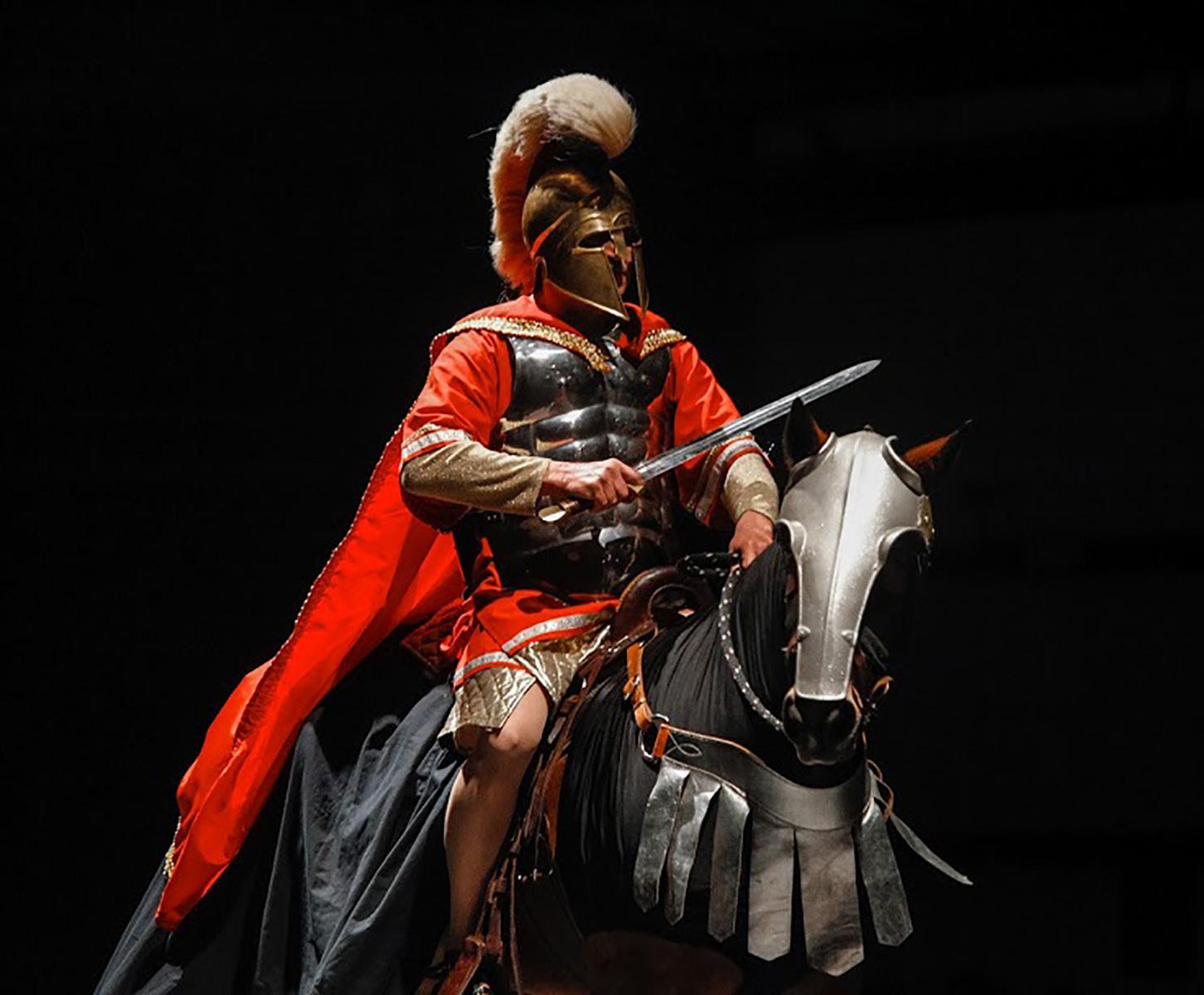
Clifford is winding down on his horse and animal activities. His wife, children, nor grandchildren share the animal passion. His wife, Margaret, has a nursing degree and worked for about 5 years for the police before being elected the Lexington County Coroner. With her second job of keeping Clifford in line she doesn’t have time for horses. The children, 1 girl and 3 boys, all work with the family business of Owens Fisher Construction. The 5 grandchildren (the oldest being 7 years old) are already in so many other activities leaving little time for horses.
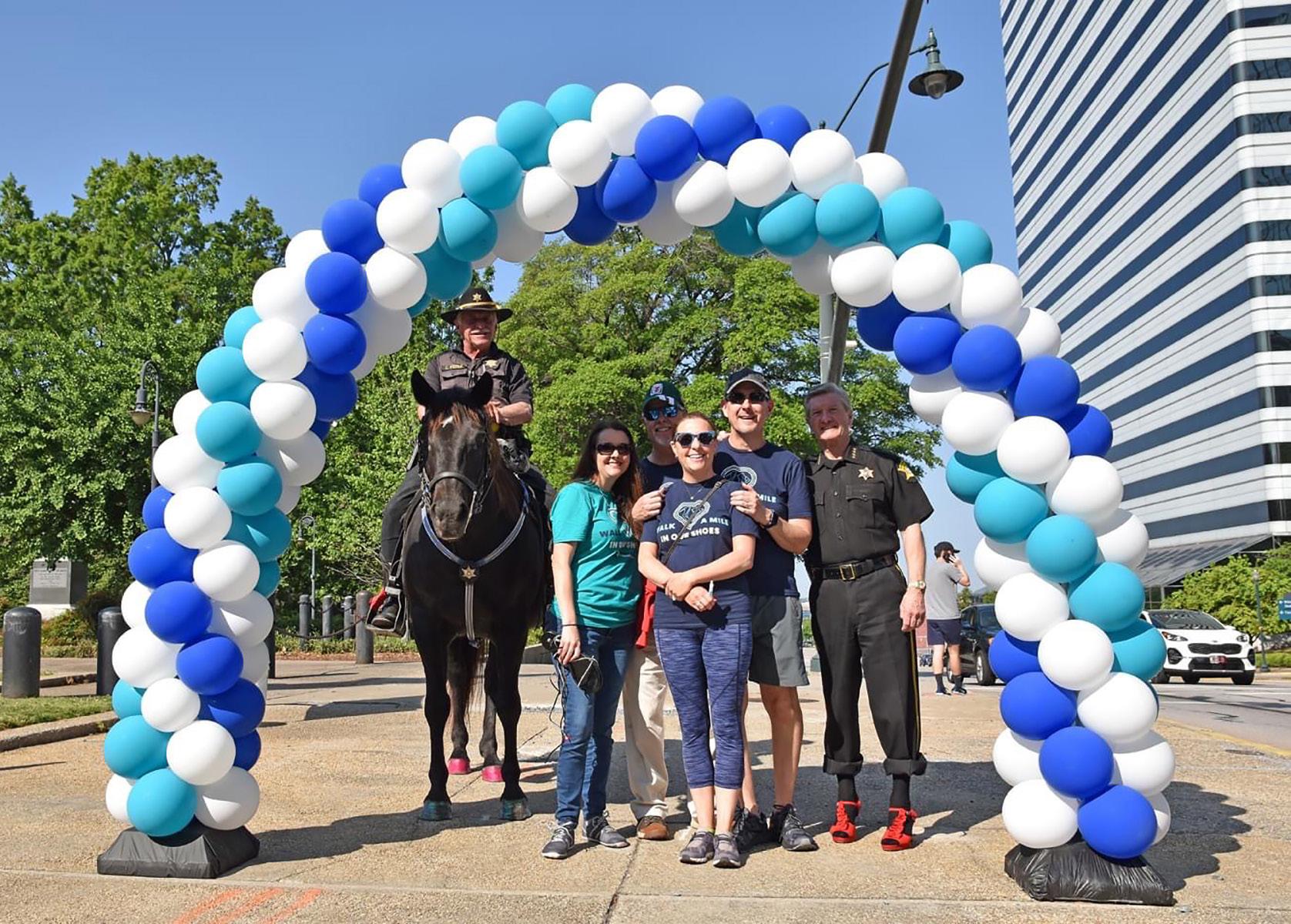
Throughout the years Clifford has owned many different animals. He has trained them for multiple activities. His Paso Finos, in addition to what has already been detailed, have also pulled wagons and carts. As a registered exotic animal owner he has also owned zebras and llamas. He has used these animals in many public and private events including his favorite ministries of live nativity scenes, This Man called Jesus, and Jesus is His Name. Clifford credits his success with animals to his training method of irritating the animal until they just give up and do what’s asked just to get him to stop. In wisdom, he encourages all horse lovers to ignore the established stereotypes of the dainty pony and try the Puerto Rican Paso Fino horse because they can and will do anything!
Endnotes:
1. Trucks And SUVs Are Now Over 80 Percent Of New Car Sales In The U.S.
Shilling, Kurt, published: January 27, 2022, accessed: January 8, 2023. https://jalopnik.com/trucks-and-suvs-are-now-over-80-percent-of-newcar-sale-1848427797
2. All information and quotes unless separately attributed are from interview conducted with Clifford Fisher on November 30, 2022.
17 BORN TO GAIT • FALL 2023
About the Pinto Patterns in the Puerto Rican Paso Fino
Stefanie Schermerhorn Trademark Farms Pinto Pasos and Pinto Paso Fino Horses
The origins of the Paso Fino have been written and rewritten for hundreds of years. From the landing of ships to the selective breeding and development of a breed. The breed we now know as the Paso Fino started with available stock and were animals of necessity. It would be hundreds of years before selective breeding would evolve into the modern breed for modern uses. Selective breeding would take many directions; varied purposes and preferences of people. Records and historical stories were passed down from breeders and family members. Farm to farm, region by region. Later farm and family records were written and shared. Eventually, breed associations were developed to maintain pedigrees. Simply the details which would become history were in the hands of people who were developing the breed in the direction they desired. At times, information was lost, omitted or altered and the narrative changed. This is common in many breeds, human intervention is frequently responsible for dramatic changes in a breed.
The near loss of “pinto” genetics in the modern Paso Fino is an example of human intervention. Over time, Paso Finos with pinto patterns, excessive markings and “high white” were eliminated from competition, then eliminated from registration within some associations. We often hear that pinto markings were signs of impurity, but history provides documentation that horses of color arrived as early as the Cortez ships. Museum archives of ships’ logs describe
what was loaded on the ships, and included color and markings of livestock. On one ship alone, three horses are described to have spotted body markings, and another 2 with excessive face and leg markings. We now know scientifically that excessive white and pintos’ patterns are controlled by a number of genetic markers, not a single “gene” from limited breeds that would prove impurity. Some of the spotting genes are dominant, others recessive but each is passed generation after generation, making the argument that these colorful horses are very likely descendants from the original “spotted” stock that landed and would become part of the gene pool that influenced the contemporary Paso Fino.
There are decades of photos and paintings of colorful Paso Finos. Paso Fino Registries have recorded horses with tobiano and sabino markings as far back as the 1920s, champions with pinto markings are recorded in the 1940s. These animals often had both solid and pinto offspring who continued to be included in registries and were used for breeding and competition.
At some point, the “traditional” Paso Fino description and preference became a solid-colored horse with no excessive white. At first, this preference was seen in the show ring, not much later some associations refused registration to pintos.
By the mid-1940s American servicemen stationed in Puerto Rico discovered the smooth-riding Paso Fino. They
18 BORN TO GAIT • FALL 2023 FEATURED ARTICLE
grew to not only admire the breed for its smooth ride and versatility, but for some discovering pinto-marked horses in the breed was an additional quality. There is no doubt of the fascination for loud color that North Americans have when it comes to their horses. Servicemen recognized that the Paso Fino was unlike any other riding horse that existed back home, so upon returning home to the States after WWII, several servicemen began to export Paso Finos from Puerto Rico. Horses of all colors including tobiano and sabino pintos were sent stateside, and from that, eventually, a group of owners banded together to form the first Paso Fino association in the USA in 1964. Pinto Paso Finos originating from Puerto Rico were among those that were registered in the early years. Some had been registered in Puerto Rico, others were offspring of horses that were from registered stock. And some were from stock that had been denied registration during the rule excluding excessive white.
More recently in Puerto Rico there was a resurgence of acceptance of horses that displayed loud white speckling markings (belly spots, tall stockings over knees and hock extending into frothy patterns towards hips). These markings are indicative of the sabino pinto pattern. For a period of time, this resulted in increased breeding and more sabino pintos being produced. In reviewing registrations and information on these horses, not one was described as a “pinto”. Science had already advanced with genetic testing, it would not be long until the sabino gene (sb1) would be identified
and testable, but color testing is not something many Paso Fino breeders utilized at the time, or even today. Unfortunately, a number of horses from this line have been lost and very few descendants are producing colorful offspring.

While there are associations that now allow registration of tobianos, the number of years disallowing registration means that previous modern generations were not registered, or genetically tested so their offspring do not qualify for registration now. Horses with sabino or other white spotting patterns are registerable, but are not indicated as pinto.
If the bloodlines and the pinto patterns that exist in the breed are to be preserved there needs to be a concerted effort by those interested to work together, genetics tells us that having only one pedigree of specific attributes will not create a wide enough gene pool to lead to conservation. Owners and breeders will have to get involved with genetic testing and associations must work diligently to improve accurate descriptions based on genetic results.
To date, genetic testing has identified the tobiano, sabino and W20 genes within the Paso Fino breed. W20 which is considered a booster and can be responsible for expressions of typical markings. There are currently two horses identified with sabino-like patterns that have been tested for all patterns and are thought to be carrying a currently unidentified W pattern. With the discovery of more patterns, the breeders will test these horses again.

19 BORN TO GAIT • FALL 2023
Pincel Rey (Pincel x Boca Chica) was one of the first pintos who made the journey stateside from Puerto Rico and began spreading color.
Marisol Sin Par (Pincel Rey x Apache) was born in 1964.
Pinto definition – Alternating patches of white and any other equine coat color appearing in random shapes and sizes. It is a generic term, not a singular gene.

Tobiano (TO)
Tobiano is a dominant gene, which means that it requires only one tobiano gene from one parent to express itself - this would be the heterozygous form of tobiano. A heterozygous tobiano has a 50% chance of passing the tobiano pattern to any of its offspring. The homozygous form of tobiano (requiring one tobiano gene from EACH parent) means that the probability of a horse passing on the tobiano pattern to all of its offspring is 100%. There is no lethal homozygous form of tobiano. Breeding of two tobiano horses can produce tobiano (Tt) (heterozygous - one parent passed
tobiano gene) 50% of the time, tobiano (TT) (homozygous - both parents passed the tobiano gene) 25% of the time, and SOLID (no tobiano pattern from either parent) 25% of the time.


Sabino (SB1)
Sabino is an incomplete dominant gene. This means that only one copy from one parent is needed to express itself, but two copies will result in a different phenotype (appearance). The homozygous form of sabino will result in a horse that is white or nearly white from birth. Unlike Overo (a gene not found in the Paso Fino breed) and some White spotting genes, there is no lethal form of sabino.
Dominant White 20 (W20)
W20 is a dominant gene. This mutation is thought to have a more minor effect on protein function as well as a subtler effect on the amount of white expressed unless in combination with other dominant white alleles (and perhaps other white spotting genes). In combination with other white pattern alleles, W20 has been shown to increase the amount of white patterning, producing an all-white or nearly all-white phenotype.
20 BORN TO GAIT • FALL 2023
Siete Potencias del Brujo (Brujo de Kofresí x Josefina Carissa), bred by Carmen Barreras and owned by Robert and Marcia Carrico.
Left, pic of a pinto mare and her filly, from North Atlantic Pure Puerto Rican Paso Fino website. Above, Classic Fino mare La Doña is an example of the sabino pinto pattern (photo by Jo-Ann Ferré Crossley and Arsdelicata).
Photos by Denisse Cancel and Paso Fino PPR Facebook group.
PASO FINO (Puerto Rico)
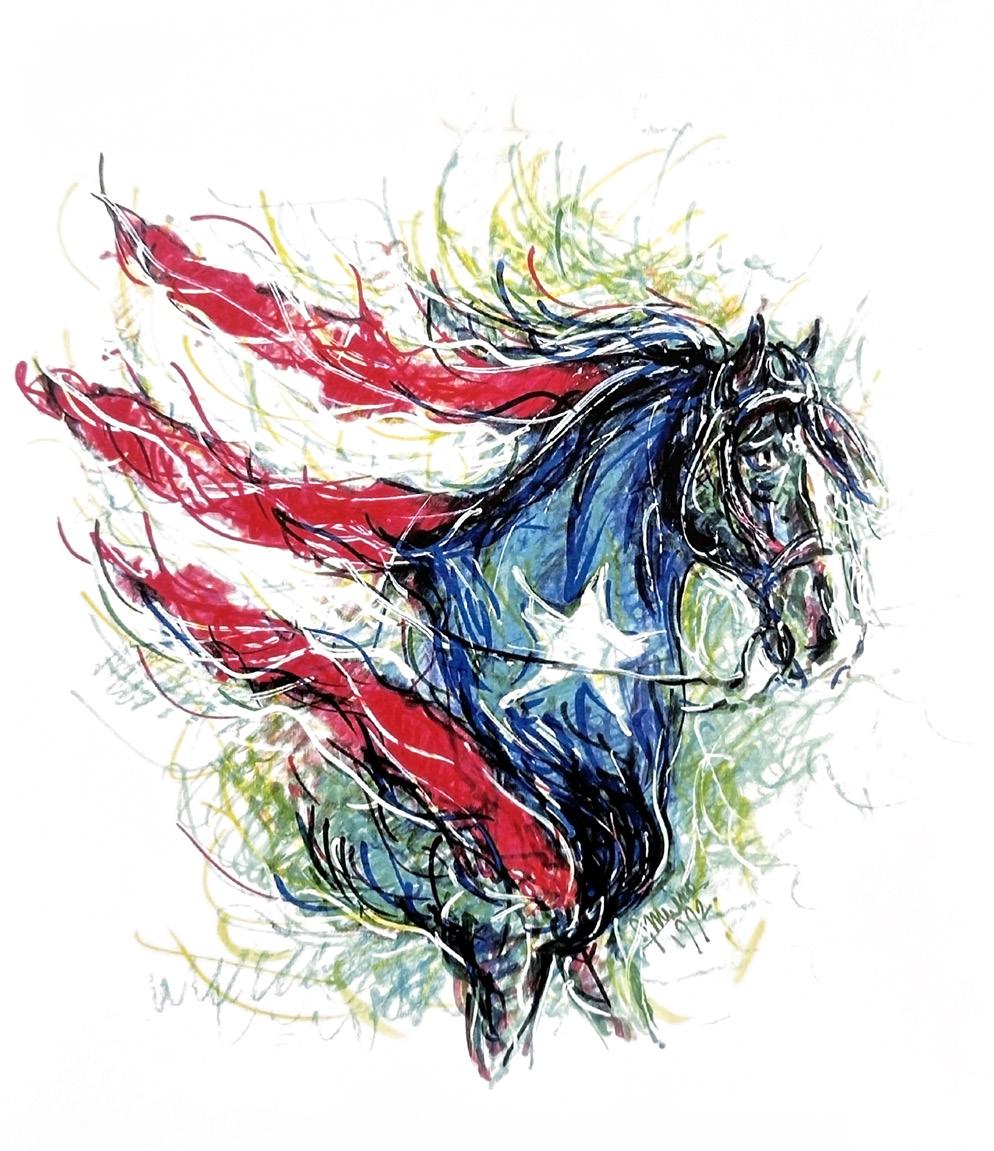
The Paso Fino is famously known for its spectacular gaits—the fino, corto and largo—which are smooth, effortless and comfortable for the rider.
Origins: The foundation of the Paso Fino is old Spanish or Iberian stock. They have the same bloodlines, inherited from horses brought to the Americas by the Spanish conquistadors in the 16th century; however, different environments have caused slight variations in terms of character and conformation.
The Paso Fino is a naturally gaited horse, like the Peruvian Paso or Peruvian Stepping Horse and another lesser known breed from Colombia, and although it is predominantly a working horse on the coffee plantations of Puerto Rico, these gaits make it remarkable. They are spectacular to watch, the main ones being the fino, the classic gait of the showring, performed with the horse balanced and collected, the corto, executed with only medium collection and light contact in the bit, and the largo, the speed form of the gait.
There are other two variations, the sobre paso, a much more natural gait in which the horse is allowed a loose rein and is relaxed, and which is used in general riding rather than the showring, the other is the andadura, which is a fast pacing gait. However, this is uncomfortable and is only performed for short periods. The rest of the time the
horse’s effortless gait makes it extremely comfortable and smooth to ride, its gliding action making it popular for trail riding. Paso Finos are also in great demand for showing and displays.
Appearance: The head is fine, almost Arab-like, with a straight nose and flaring nostrils, longish well-shaped ears and intelligent eyes. The body is very Spanish, similar to Andalusian’s, with a medium-length back with slightly sloping quarters and a low-set tail. The legs are sturdy with large hocks.
Characteristics: The Paso Fino has an excellent temperament. It has great enthusiasm and is obedient and easy to ride, seemingly enjoying the company of human beings. Despite its small stature is very strong, in fact, even the smallest will easily carry a man over hills and rough terrain.
Colors: All colors.
Height: 14-15 hh.
21 BORN TO GAIT • FALL 2023
“The Ultimate Guide to Horse Breeds,” Andrea Fitzpatrick, 2021. Illustration by Arq. José Vivó, 1992 (from Romualdo Olazábal collection).
The Genetics of the Color Spectrum in Our Puerto Rican Paso Finos
Paola Matos Ruiz & Xiomara R. Arias
The genetics article in the previous magazine issue focused on the genetics of tiger eyes, which is a unique trait of the Pure Puerto Rican Paso Finos. In this article, we plan to continue promoting the genetic diversity of the Pure Puerto Rican Paso Fino breed by exploring the genetics of coat colors and blue eyes. We also plan to illustrate the genetics of coat and eye color through a case-based learning series using a Pure Puerto Rican Paso Fino cremello horse as an example.

Mutations. We hear this word and may have vastly different impressions of what it means. Do you think of ugly mutants, abominable creatures that come from the depth of toxic waste? When we are children, this is what may have come first to our minds. Despite being perceived as atrocious by some, mutations allow the world to be filled with diverse beauty and benefits for species’ survival. Divergent biological aspects create a planet with many new and appealing sights. Our world would not be nearly as beautiful or diverse without the possibility of mutations. Due to mutations, we have the diversity of coats and eye colors we appreciate nowadays in horses.
Red and black are the primary pigments in horses’ base coat colors. The interaction of the genes Melanocortin Receptor 1 (MC1R, abbreviated as E) and Agouti-signaling protein (abbreviated as A) determines the base coat color in horses1-2. How these genes are co-inherited dictates the final base coat color product.
The MC1R gene plays a role in determining the black and red pigments and is known as “extension” or the red factor locus. Three alleles are known for the base coat color dictated by the MC1R gene: E, e, and ea. Two copies of the recessive alleles (e/e, e/ea or ea/ea) alleles would produce only horses with a red base coat color (e.g, chestnuts, palominos, red duns) because this genotype masks the expression of

22 BORN TO GAIT • FALL 2023 GENETICS
other genotypes that could be co-inherited through a genetic mechanism known as epistasis. The Agouti gene determines the distribution of black pigmentation in horses and acts as a modifier to determine bay versus black. From the absence of the Agouti dominant copy (A/a or A/A) and recessive red factor alleles (e/e, e/ea or ea/ea), we can get black horses if the horse genotype at the MC1R gene is E/E or E/e. In the presence of one or two copies of Agouti (A/a or A/A) and one or two for the MC1R gene (E/e or E/E), the horse may have a bay color phenotype with black pigmentation restricted to the mane, tail, lower legs and ear rims. These areas of black pigmentation are referred to as “points”. In other words, Agouti modifies the black pigmentation on
the horse’s body, except for the points mentioned above.
While black and red (also known as eumelanin and pheomelanin, respectively) are the only pigment types present in horses, mutations can cause a different distribution of pigments, resulting in our diverse color wheel of horse hair. For example, the cremello, smoky black, smoky cream, and perlino colors are the results of a mutation, primarily affecting the Cream locus9-10.
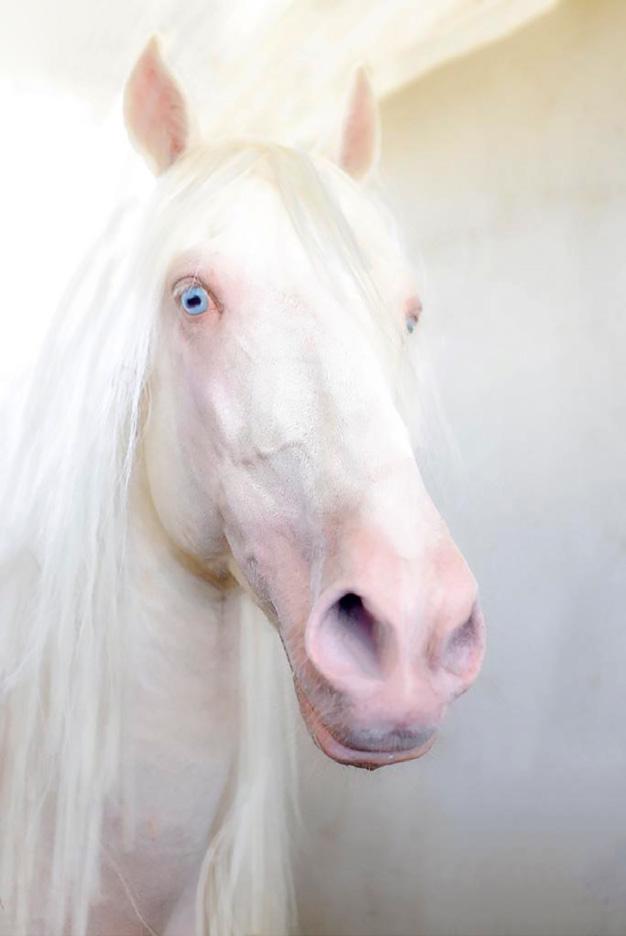
The Cream (C) locus located in chromosome 21 is where the Cr and N alleles are found9-10. Cr refers to an allele with a variant in the MATP gene that produces color dilution, whereas N refers to an allele without the variant9-10 Since horses are diploid, they will inherit an allele from each

23 BORN TO GAIT • FALL 2023
Sueño de Paz (Ensueño Dorado x Platanera Dorada) is an example of a cremello stallion with blue eyes.
of their parents. The Cream locus can present a different phenotype for homozygotes (e.g., Cr/Cr) and heterozygotes (Cr/N). For example, if a horse is homozygous for the Cream allele (e.g., Cr/Cr), it means it has two copies of the Cream dilution variant. Depending on the base coat color (e.g., chestnut, bay, or black) the homozygous (Cr/Cr) horse would be expected to be cremello (chestnut base), perlino (bay base), or smoky cream (black base). If the horse is heterozygous, Cr/N, it has one copy of the Cream dilution allele, it would be expected to be either palomino (chestnut base), buckskin (bay base), or smoky black (black base). If the horse is recessive for the absence of the variant at the Cream dilution locus, N/N, its phenotype should show its base coat color.
The presence of two copies of the Cream dilution allele at the C gene locus does not render a horse an albino. Albinism refers to the inability to produce pigment and, therefore, a complete lack of color, which presents itself as white. The presence of Cream does not result in the absence of color; rather, it changes the distribution of pigment. Albinism is currently not a phenomenon that has been described for horses. Although from manifestations in other species, albinism often causes reddish/pink eyes11. Cremello and perlino horses have blue eyes, therefore demonstrating that they are not albinos.
Pintos, similarly, are a result of a variety of genetic mutations. The patterns of pintos that have been observed in the Puerto Rican Paso Finos are: Tobiano pintos (TO), Sabino pintos (SB1) and Dominant White 20 (DW20). Tobiano pintos are a result of a chromosomal inversion in chromosome #38. The specific genetic mutation observed in our breed’s Sabino pintos has not been identified, but it might involve the KIT gene. The Sabino mutations tend to vary among horse breeds; the specific mutation for the Pure Puerto Rican Paso Finos has not been identified scientifically, but we predict it might involve the KIT gene4 The DW20 results from a point mutation at the KIT gene (c.2045G>A) and results in prominent white markings in the leg and face, more in its homozygous form than its heterozygous form3. From talking to breeders in Puerto Rico who own offspring of the Grand Sire of the Breed, Linaje D’ La Excelencia, the DW20 mutation has been confirmed genetically through genetics panels ordered by the breeders themselves. Based on pedigree analysis, most likely, Linaje is a carrier of this mutation because of his paternal grandmother, Jackeline.

So far, research has not found evidence about the Tobiano, Sabino, and DW20 mutations resulting in adverse health effects. In contrast, gray horses, which have also been
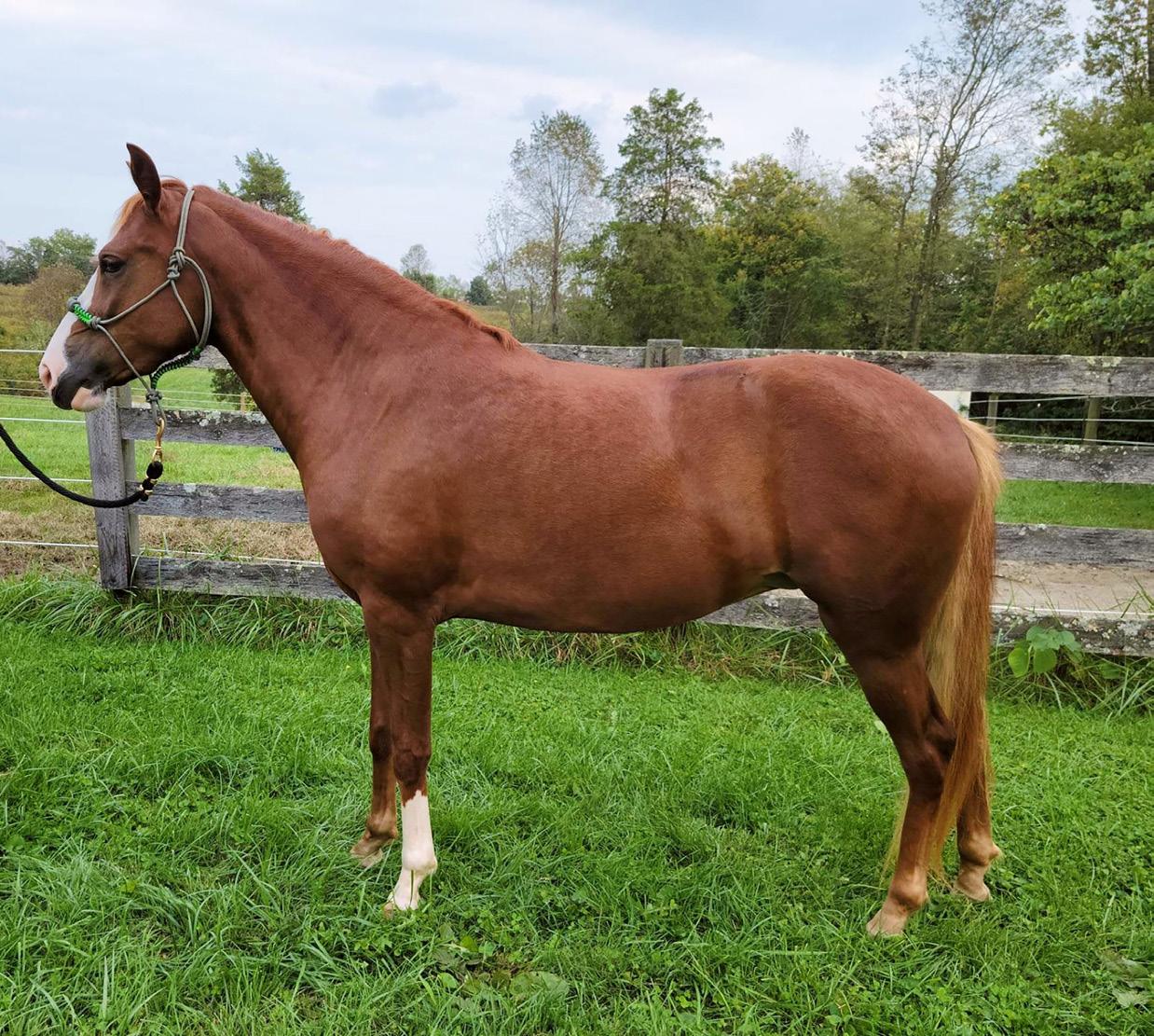
24 BORN TO GAIT • FALL 2023
Embajadora de Krysia (Doble Réplica del Caribe x Lombardia de Krysia) is an example of a chestnut mare.
Magnum de Heart of Gold (Ser Externo Esperanza x Ilusionista) is an example of a black stallion.
observed in our breed, do experience adverse effects by being at a higher risk of developing melanomas in their lifetime due to depigmentation of their skin. Gray horses are a result of a mutation (i.e. duplication of intron 6) in the gene syntaxin 17 (STX17) that results in progressive depigmentation of the skin by inhibiting the production of melanocytes5-6. They are born gray and progressively their hair color transforms to white. The pattern of inheritance is autosomal dominant, which implies you only need one copy of the mutated allele of gene STX17 to develop this pattern. In other words, they lose their hair pigmentation which serves as an armor to protect their bodies against the dangerous sun UV light and are prone to develop skin cancer. According to most recent research, 70-80% of gray horses will develop melanoma (skin cancer) by the time they are 15 years old5-6 It is important to clarify that some of the skin tumors gray horses develop are benign; about 66% become malignant7
To current knowledge, there are only two Pure Puerto Rican Paso Fino double cream diluted stallions worldwide. They are both cremellos, with Sueño de Paz residing in Puerto Rico and Rayito de Oro residing in the mainland United States. Sueño de Paz sire is the palomino stallion Ensueño Dorado and palomino dam Platanera Dorada. Rayito de Oro is the son of the palomino stallion Cale’s Helado Oro and buckskin dam Tostada Hidalgo.
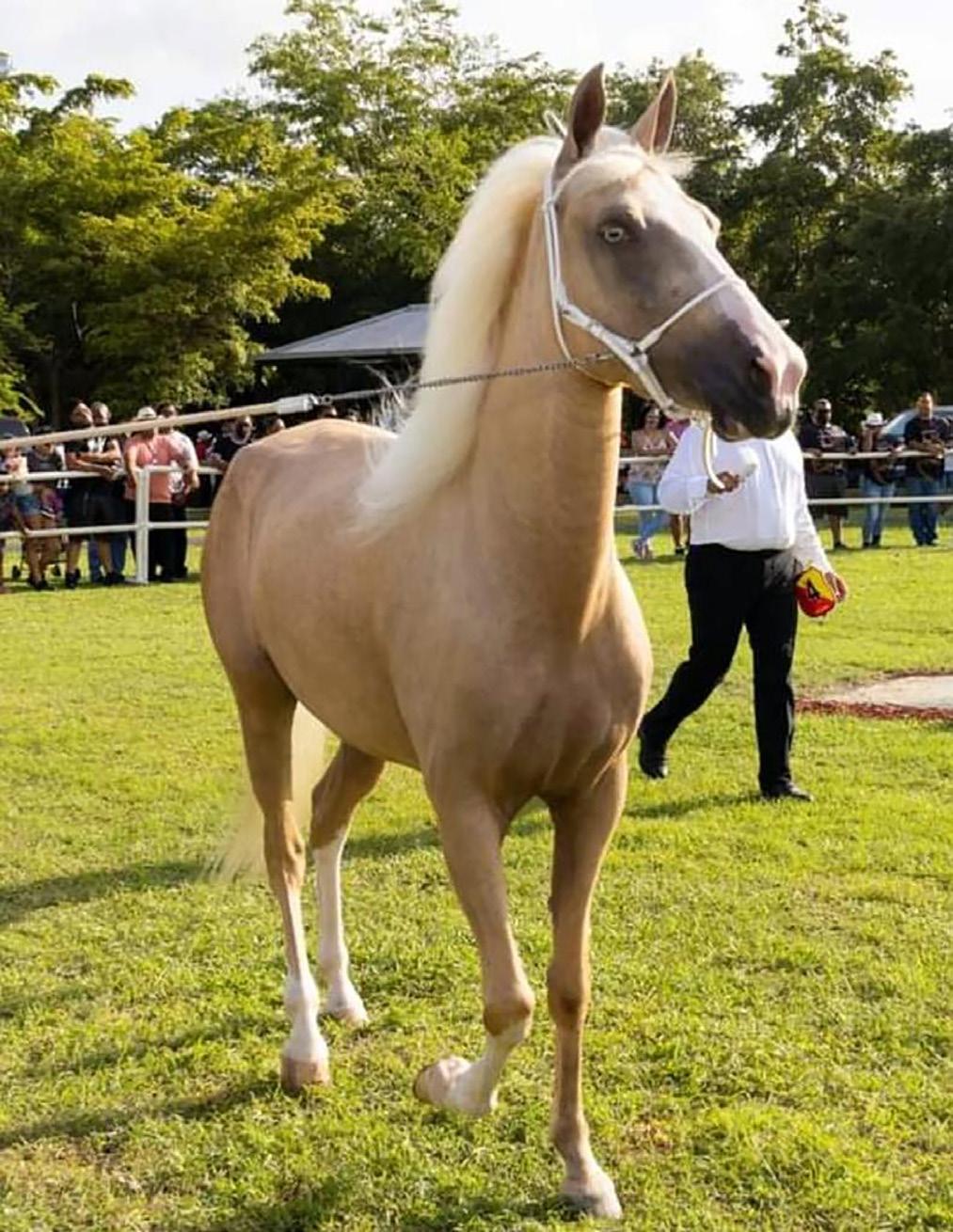
These stallions will always pass on one of their Cream alleles to their offspring. This means that if you mate them to a bay mare, you will (mostly) get buckskins. We say ‘mostly’ because if the bay horse base coat color genotype is heterozygous for the MC1R gene (e.g., E/e), there is a 50% chance the offspring will be a palomino, and if you mate them to a chestnut (e/e), you will get a palomino.
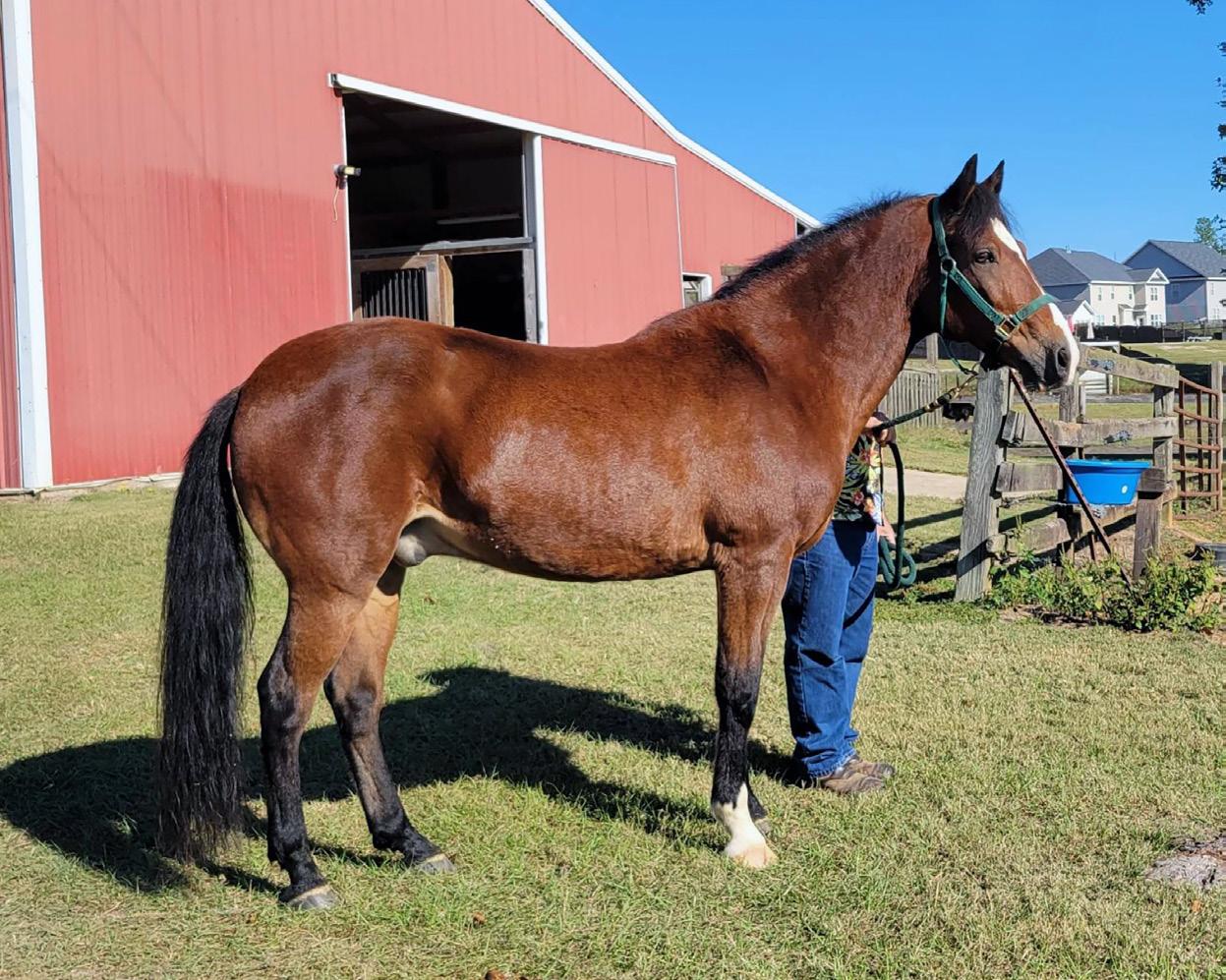
The cremellos of our breed not only contribute to the maintenance and boost of the Pure Puerto Rican Paso Fino coat color spectrum but also eye color diversity. These cremellos have blue eyes primarily due to their genotype at the Cream locus. It is important to highlight that blue eyes have been observed on horses of all coat colors but are more prevalent and more likely to be inherited from double-dilute horses, such as cremellos, and genes that cause white, such as pintos. In our beloved Pure Puerto Rican Paso Finos, blue eyes have been observed in pintos, cremellos, and even bay horses. Interestingly, some of the bay horses with blue eyes have one of the two eyes affected. This phenomenon is called heterochromia.
Sueño de Paz (Ensueño Dorado x Platanera Dorada) is a cremello with blue eyes - Sueño de Paz sire and dam were both palominos. Therefore, he inherited one copy of the Cr from each parent to have a cremello phenotype. Sueño
Omega de Pride (San Mateo Mako x Herencia de Kofregrama) is an example of a bay gelding.
Compositora de Sueños (Sueño de Paz x Sara de Plebeyo), palomino mare.
de Paz’s owner, Ms. Viveca Venegas Vilaró, kindly accepted our request for the genetic panels of her stallion and some of his offspring. His genetic panel confirms he is red-based (e/e) and homozygous for the Cream locus (Cr/Cr). He is also homozygous for the Agouti trait, but this trait is masked by the presence of two copies of the red factor (e/e). Given his homozygosity on the Cream locus, he can only produce buckskins or palominos when bred to a bay mare or palominos when bred to a chestnut mare. When bred to a palomino, Sueño de Paz offers a 50% chance of producing a cremello. When bred to a chestnut mare, he produces 100% palominos.
Interestingly, Sueño de Paz is a carrier of the tiger eye allele 2. Therefore, this outstanding cremello Pure Puerto Rican Paso Fino stallion not only can produce palominos and buckskins, but can also help increase the number of Pure Puerto Rican Paso Finos with tiger eyes if bred to a car-

rier or tiger-eye mare. From the data shared by Ms. Venegas Vilaró, Sueño de Paz has already produced offspring with tiger eyes. Here are some examples of his offspring (genetic panel information was confirmed):
1- Compositora de Sueños (Sueño de Paz x Sara de Plebeyo*) - Palomino mare with tiger eyes.
2- Cantares de Nan (Sueño de Paz x Sara de Plebeyo*)Buckskin mare with tiger eyes.
*Sara de Plebeyo (Plebeyo x Sarita M.) - Is a bay mare heterozygous for the red factor (Ee). Therefore, she has a chance of producing 50% palominos and 50% buckskins when bred to Sueño de Paz.
The versatility of the Puerto Rican Paso Fino is one of the key features of the breed. While we often focus on what they can do in terms of riding and intelligence, we must
26 BORN TO GAIT • FALL 2023
Casta Diva (Abayarde Puro x Cantares de Nan) is an example of a roan filly.
not neglect to recognize the brilliant diversity of color that also contributes to the uniqueness of the breed. Preserving color while maintaining the important aspects of the Puerto Rican Paso Fino—gait, conformation, intelligence—is an important task to take accountability for and continue. We must not forget that the tiger eye is one of the defining features of the breed that can genetically show the Puerto Rican Paso Fino is different from other similarly gaited breeds. The tiger eye indicates that our breed has been bred separately from other populations, creating a unique breed in need of conservation.
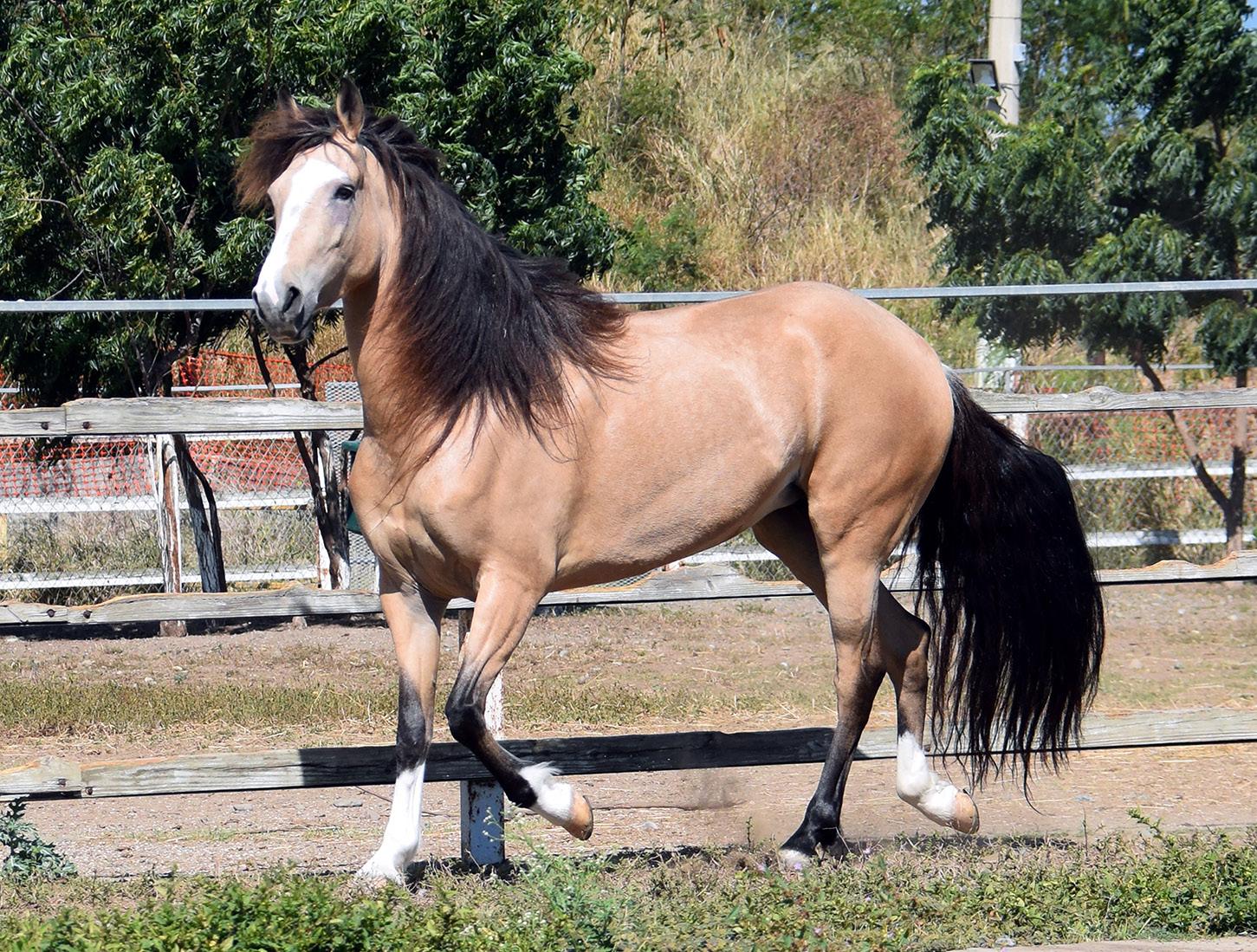
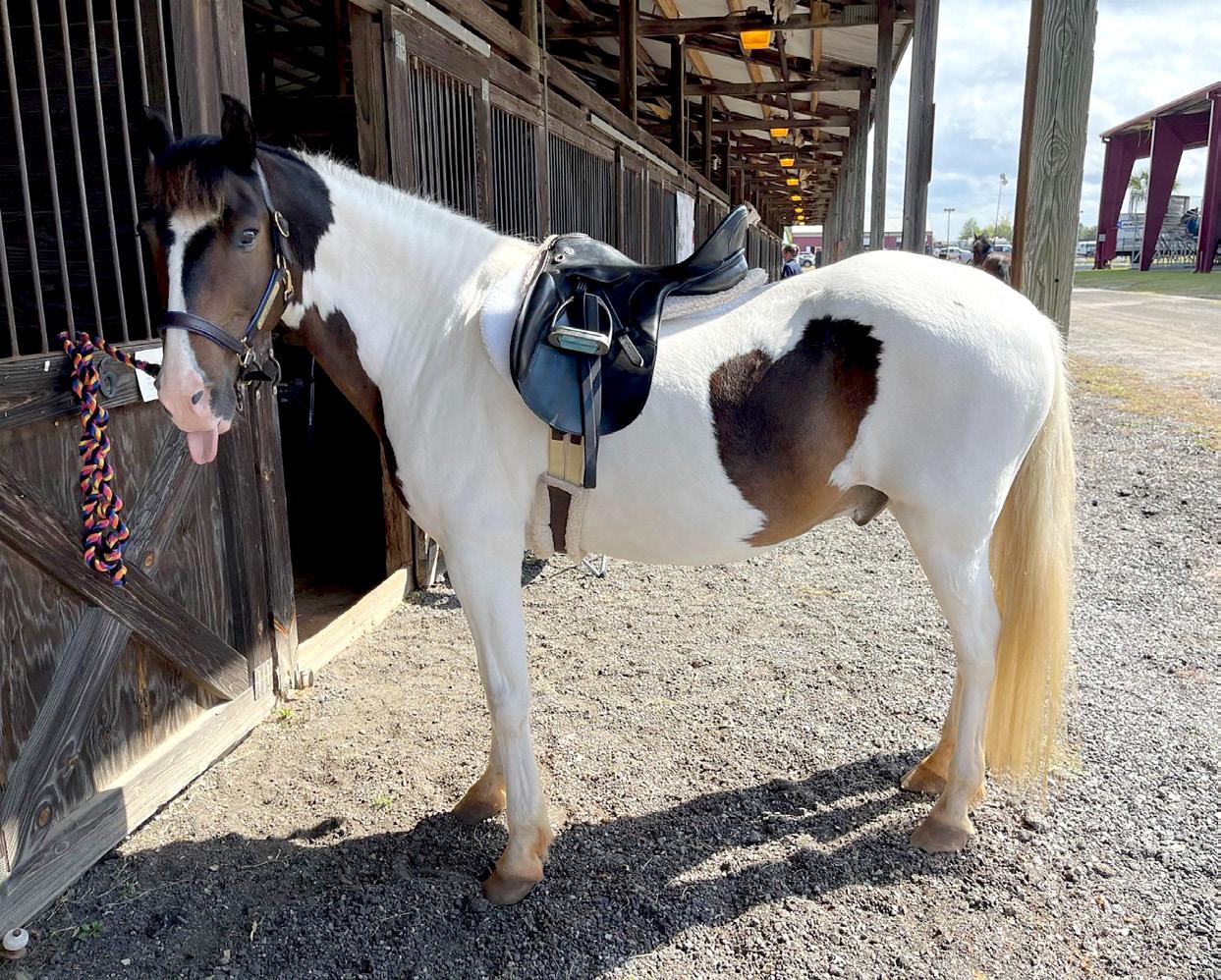
27 BORN TO GAIT • FALL 2023
Padre de Margarita (Brillador de Pisgah x Reina de Margarita) is an example of a tobiano pinto.
Cantares de Nan (Sueño de Paz x Sara de Plebeyo), buckskin mare.
Genotype Phenotype Example of Puerto Rican Paso Fino Horses
One or two dominant copies of the red factor gene (MC1R), in the absence of the Agouti dominant allele, annotated as E/E or E/e
A single dilute horse with a black base, in the absence of Agouti. Possible genotypes: E/E, Cr/N, a/a or E/e, Cr/N, a/a
A double dilute horse with a black base, in the absence of Agouti. Possible genotypes: E/E, Cr/Cr, a/a or E/e, Cr/Cr, a/a
Presence of at least one copy of the Agouti allele and one copy of MC1R. Example: E/-, A/-
Two recessive alleles for the red factor gene. (MC1R), annotated as e/e
Two recessive copies of the Cream dilution allele, annotated as (Cr/Cr)
One Cream dilution allele in a chestnut base, annotated as (Cr/N, e/e)
One Cream dilution allele in a bay base (at least one copy of the Agouti variant), annotated as (Cr/N, A/a or Cr/N, A/A)
Genetics is still under investigation
Autosomal dominant (at least one copy of the allele carrying the variant at the STX17 gene locus) G/G or G/N
Chromosomal inversion in chromosome #3
Black1-2
Smoky Black (usually confused with black, but genetically not black)9-10
Smoky Cream9
Magnum de Heart of Gold (Ser Externo Esperanza x Ilusionista)
Autosomal dominant mutation at the KIT gene (SB-1/SB-1 or SB-1/N)
Autosomal dominant mutation at the KIT gene (W20/W20 or W20/N)
Chestnut1-2
Omega de Pride (San Mateo Mako x Herencia de Kofregrama)
Embajadora de Krysia (Doble Réplica del Caribe x Lombardia de Krysia)
Cremello9-10
Sueño de Paz (Ensueño Dorado x Platanera Dorada) and Rayito de Oro (Cale’s He lado Oro x Tostada de Hidalgo) (Photos of Rayito in the News section.)
Palomino9-10 Compositora de Sueños (Sueño de Paz x Sara de Plebeyo)
Buckskins9-10 Cantares de Nan (Sueño de Paz x Sara de Plebeyo)
Roan
Casta Diva (Abayarde Puro x Cantares de Nan)
Grey6
Onasis (Boricua x Coqueta) and Nevado Royal (Don Carlos x La Beba de Ana Livier )
Tobiano pintos8
Padre de Margarita (Brillador de Pisgah x Reina de Margarita)
Sabino pintos3
Dominant White 20 (DW20) pintos4
Photos of Siete Potencias del Brujo and La Doña in the Pintos’ featured article.
28 BORN TO GAIT • FALL 2023
Acknowledgments:
We want to thank Viveca Venegas Vilaró, who collaborated with us to make this article possible.
References:
1- Rieder, S., Taourit, S., Mariat, D. et al. Mutations in the agouti (ASIP), the extension (MC1R), and the brown (TYRP1) loci and their association to coat color phenotypes in horses. Equus caballus. 12, 450–455 (2001).
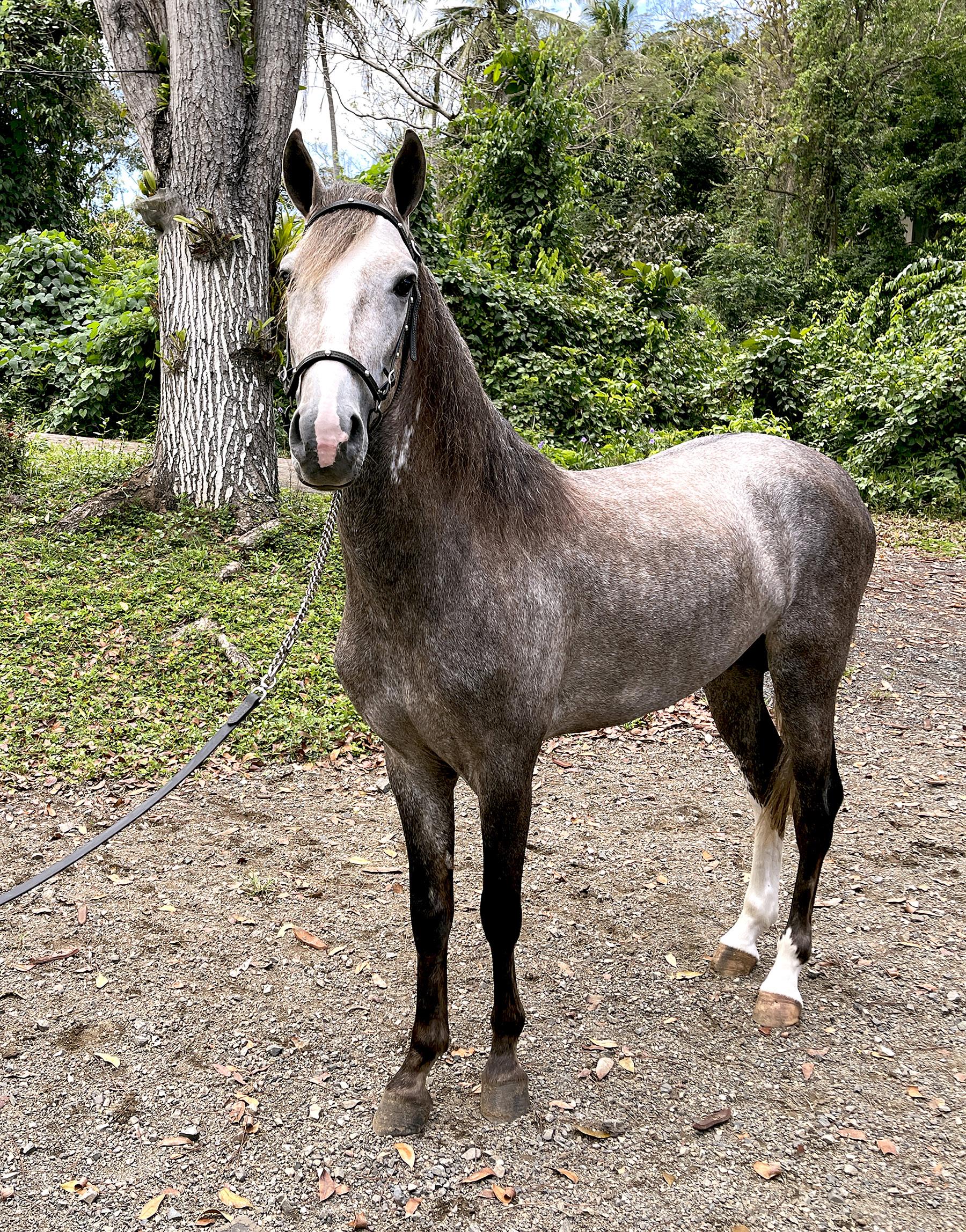
2- UC Davis website (Bay, black and chestnut horses): https://vgl.ucdavis. edu/test/agouti-horse, https://vgl.ucdavis.edu/test/red-factor-horse
3- Book- Horse Genetics, 3rd edition | Drs. Ernest Bailey and Samantha Brooks | Wallingford, Oxfordshire, UK; Boston; CABI [2020].
4- Hauswirth R, Jude R, Haase B, Bellone RR, Archer S, Holl H, Brooks SA, Tozaki T, Penedo MC, Rieder S, Leeb T. Novel variants in the KIT and PAX3 genes in horses with white-spotted coat color phenotypes. Anim Genet. 44(6):763-5 (2013).
5- Curik I, Druml T, Seltenhammer M, Sundström E, Pielberg GR, Andersson L, Sölkner J. Complex inheritance of melanoma and pigmentation of coat and skin in Grey horses. PLoS Genet. 9(2):e1003248 (2013).
6- UC Davis website (Grey Horses): https://vgl.ucdavis.edu/test/gray
7- Yi Z, Gao Y, Yu F, Zhu Y, Liu H, Li J, Murua Escobar H. Interventions for treatment of cutaneous melanoma in horses: a structured literature review. Vet Res Commun. (2022).
8- Brooks SA, Lear TL, Adelson DL, Bailey E. A chromosome inversion near the KIT gene and the Tobiano spotting pattern in horses. Cytogenet Genome Res. 119(3-4):225-30 (2007).
9- Mariat D, Taourit S, Guérin G. A mutation in the MATP gene causes the cream coat color in the horse. Genet Sel Evol. 35(1):119-33 (2003).
10- Locke MM, Ruth LS, Millon LV, Penedo MC, Murray JD, Bowling AT. The cream dilution gene, responsible for the palomino and buckskin coat colors, maps to horse chromosome 21. Anim Genet. 32(6):340-3 (2001).

11- White, D., Rabago-Smith, M. Genotype–phenotype associations and human eye color. J Hum Genet 56, 5–7 (2011).
Table 1. Summary of the genotype and corresponding phenotype for some of the colors observed in the Puerto Rican Paso Fino.
Disclaimer: This table is not comprehensive and does not include the different color subtypes described in horses of our breed.
*N= normal/wild-type allele
29 BORN TO GAIT • FALL 2023
Above, Onasis (Boricua x Coqueta). Below is his great-grandson Nevado Royal (Don Carlos x La Bebé de Ana Livier). Both are examples of the grey color.
Photos by Viveca Venegas, Xiomara Arias and Romualdo Olazábal.

Versatility and Diversity: Rationale for Breed Preservation
Xiomara Arias
Xiomara Arias is an undergraduate student at The University of Kentucky majoring in Agricultural and Medical Biotechnology. Along with her parents, she cares for three Puerto Rican Paso Finos at their farm Hacienda Borikén in the rolling hills of Kentucky. She enjoys showing and promoting the Puerto Rican Paso Fino breed.

Versatility – what comes to mind when you think of this word? If you like movies, perhaps a Transformer comes to mind, transforming from car to robot! Perhaps you are on the more practical end of things, and a Swiss Army Knife comes to mind, knife, toothpick, file, screwdriver, and all. Maybe your mind (much like mine) never deviates from thinking about horses and you immediately think of 3-day events – dressage, cross-country, and show jumping. Despite the word “versatile” applying to a plethora of concepts, its meaning is never diminished. Versatility is the ability to adapt to new events and be flexible in skills. This definition applies well to the Puerto Rican Paso Fino. Versatility is greatly prized among horse breeders and associations. Versatile horses must demonstrate the ability to be flexible in mind and body. The best versatile horses, to modify an old quote, are jacks of all trades and masters of some! The Puerto Rican Paso Fino is my favorite horse to ride, whether I am competing at a gallop, playing around at a canter, or reflecting at a calming 4-beat gait. Perhaps one of the only events they cannot do is race —but I’m happy to leave that to the Thoroughbreds! Let’s take a look at some examples of demonstrated versatility in our breed.
Mr. Clifford Fischer has trained Puerto Rican Paso
Finos to be police horses. Their size may be an impediment to field work (most police horses have draft blood), but the Puerto Rican Paso Finos can be trained to pass the police horse test. One of Mr. Fischer’s horses even broke a state record in completion time for the obstacle test. I have heard repeated time and again that not every horse can be trained to be a police horse. Despite the size limitations, it is important to note that the Puerto Rican Paso Fino has the ability and intelligence to be trained as a police horse. Mr. Clifford has also shown Puerto Rican Paso Finos to be well-adapted to endurance races. I am thankful that Mr. Fischer has taken the time to train his horses well and demonstrate their versatility.
The versatility of the Puerto Rican Paso Fino is being demonstrated in Puerto Rico by Nicole Aviles, her students, and Nora Marrero. These women are pioneering the way for Puerto Rican Paso Finos in competitions such as dressage, jumping, and barrel racing. The elegant, precise, and fluid gait of the Paso Fino is perfect for such events.
Puerto Rican Paso Finos have also been trained to compete in rodeo events. Randee Randall in Oregon has trained her Puerto Rican Paso Fino to barrel race, pole bend, run keyhole, and cut cattle. Randee has used the same
31 BORN TO GAIT • FALL 2023 REFLECTIONS AT 4-BEATS
rodeo horses with search and rescue operations. Being able to show up and run a rodeo event and then be a calm and level-headed search and rescue companion demonstrates an amazing amount of versatility for a single horse.

Would you believe that Puerto Rican Paso Finos are often naturally cowy? I have heard on two different occasions of completely different Paso Fino bloodlines that Quarter Horse trainers were impressed by a specific Paso Fino’s “cowiness”. Randee proudly shows her horse’s aptitude for working with cattle on Facebook. Paso Finos were developed as family AND work horses, with cattle handling being an important part to the work aspect.
Let’s talk about one of my favorite pastimes. Many trail riders self-deprecate by indicating that they “just” trail ride, and their horses are “just” trail horses. In reality, most trail horses are extremely well trained. Many hours go into training a horse to focus on the rider and be desensitized to stimuli. Some aspects of a trail horse are by blood, such as good-footedness and a predisposition to endurance – both
of which Puerto Rican Paso Finos naturally have! Other aspects are purely developed by training, and require a moldable mind. The Puerto Rican Paso Fino is an excellent choice for a smooth, intelligent trail partner. Just sit back and enjoy the scenery!
Humans often mistake intelligence for willingness to obey our will. I would argue the exact opposite. Intelligence in animals is the ability to demonstrate thinking for themselves. Truly intelligent animals are the most rewarding for which to develop a relationship. You know that they are not blindly following commands, but have thought and decided that they will put their trust in their rider. I’ve heard some ascribe pig-headedness to the Puerto Rican Paso Fino, not willing to ride a breed that is naturally intelligent and deserves more than being forced to complete tasks mechanically. You are more than welcome to ride an animal that has given up their will, but I would rather have a discussion with my horse and be companions. The Puerto Rican Paso Fino is an intelligent partner.
I apologize, but I can’t get through an article without talking about my partner in crime, Omega! Omega is by no means the perfect horse (though he is in my heart!) but I believe he is still a good example of versatility. I can throw him into any class and know he will work his heart out for me. At the Celebration Show in South Carolina, he has won Horse of the Show for two years, and won the 2022 Horse of the Show at the local Pioneer Saddle Club show. Being eligible to win these awards demonstrates that he can compete in a wide range of events. During the Celebration Show Omega went from winning Bellas Formas to winning the Panty Race (my personal favorite class), to competing in Excellence of Gait, to winning Egg and Spoon, and to the Gelding’s Pleasure Championship. Conformation and ground manners, gait ability, speed, and smoothness of gait are tested in these classes, and Omega did not disappoint! Upon returning home, he nobly allowed my young nieces to ride him. He goes from champion to child’s horse! I know there are plenty of Pasos that can demonstrate the same ability, if not better. Come beat Omega for Horse of the Show! Let’s show off the Paso Fino’s versatility and make each other better with friendly competition.
Within the Puerto Rican Paso Fino there is a wide range of diversity. I believe it would be rather monotonous to have a completely homogeneous breed. The diversity
32 BORN TO GAIT • FALL 2023
within our breed is complex, interesting, and worth conserving. The variations in phenotype make it possible for breeders to develop their ideal horse. I feel fortunate to live in an age where genotype can inform decisions made for a specific phenotype, though just the topsoil of horse genetics has been uncovered. Within our breed we have variations in size, temperament, conformation, gait, and color. The differences between the three main Puerto Rican Paso Fino populations (Eastern mainland U.S., Western mainland U.S., and Puerto Rico) allows breeders to maintain old bloodlines and refresh linebreeding with new blood. While variations exist, the Puerto Rican Paso Fino breed has it fixed within their blood to be intelligent, adaptable, and beautiful (though I may be biased on the last characterization). You, the owner, can mold the horse to your ambitions. We won’t know the extent of the breed’s versatility without trying new events and pushing the limits of what is deemed possible for the Paso Fino.
Now, if you are reading this you may already fully
understand the magnificent versatility of the Puerto Rican Paso Fino. However, there are those who have not discovered our fascinating breed. In my opinion, it is unfortunate that not everyone has had the opportunity to explore the Puerto Rican Paso Fino. As owners, it is our job to display the breed and help others gain awareness of the Paso Fino’s unique qualities. How can we do this? Breed promotion is a crucial part to conservation. In the mainland United States, owners can show their horses in parades during events such as Christmas and 4th of July celebrations. In Puerto Rico, cabalgatas (horse parades) can be held to show camaraderie among Paso Fino owners. The main idea is to promote the breed by using your horses in the public eye – the horse’s versatility will speak for itself.
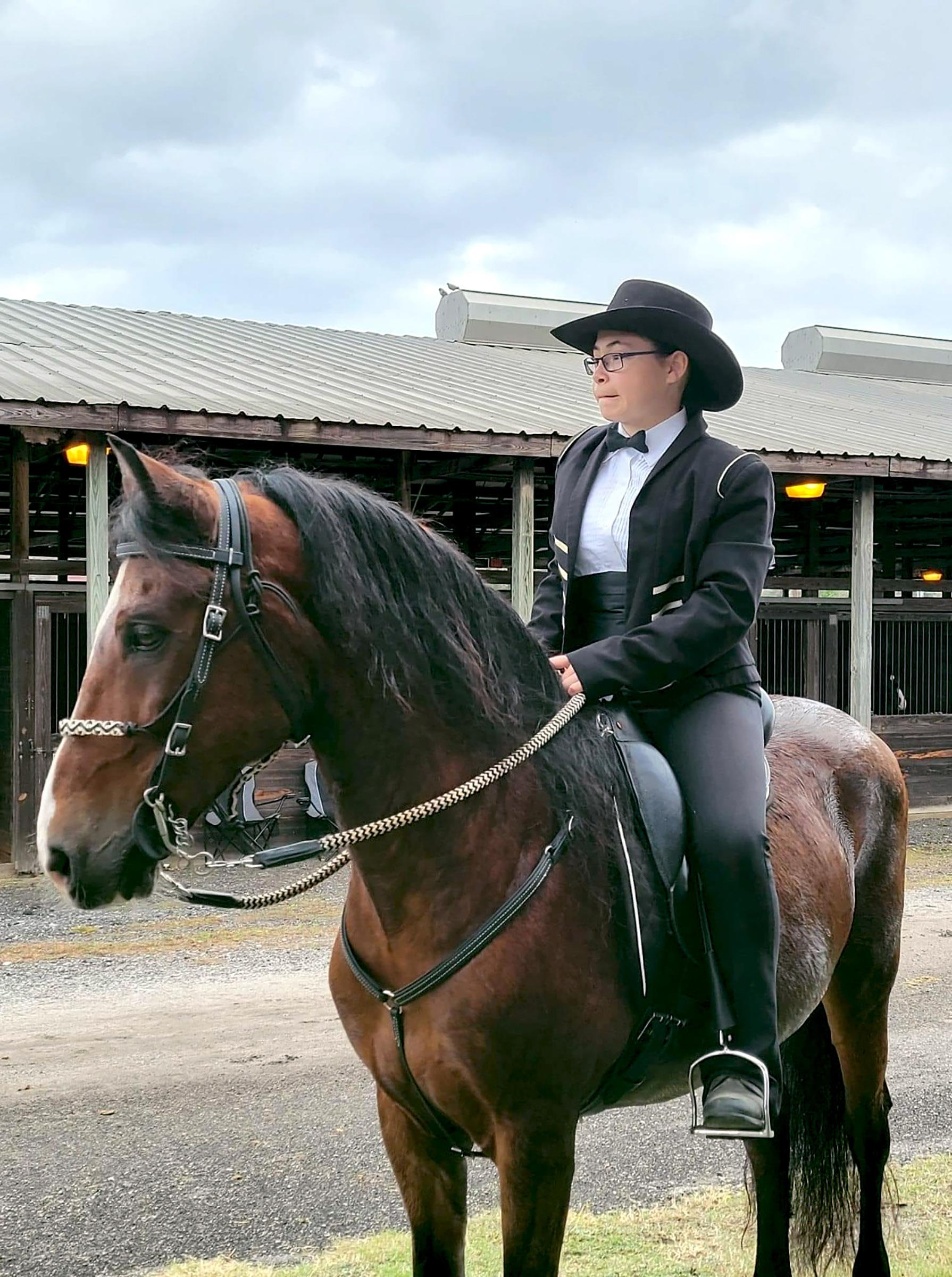
The origin of the Paso Fino and its development as a breed is attached directly to the 4-beat lateral gait. This gait adds an extra level to the breed’s versatility. The Paso Fino can be an excellent trail horse, surefooted and brave. They can show, jump, run speed events, and even be police horses. But, the most special part is that they can do all these tasks with comfort for the rider. The Puerto Rican Paso Fino was bred to be a versatile family horse. When I ride my horse, work in the barn with my dad, or go to shows, I am filled with proud fervor towards this breed of horse. It is my responsibility to preserve my culture and heritage, and for me that starts with the Puerto Rican Paso Fino. The versatility of the Puerto Rican Paso Fino knows no bounds, provided you have a conversation and teach them how to execute their job. Join the Puerto Rican Paso Fino family and let your Paso take you to new horizons!
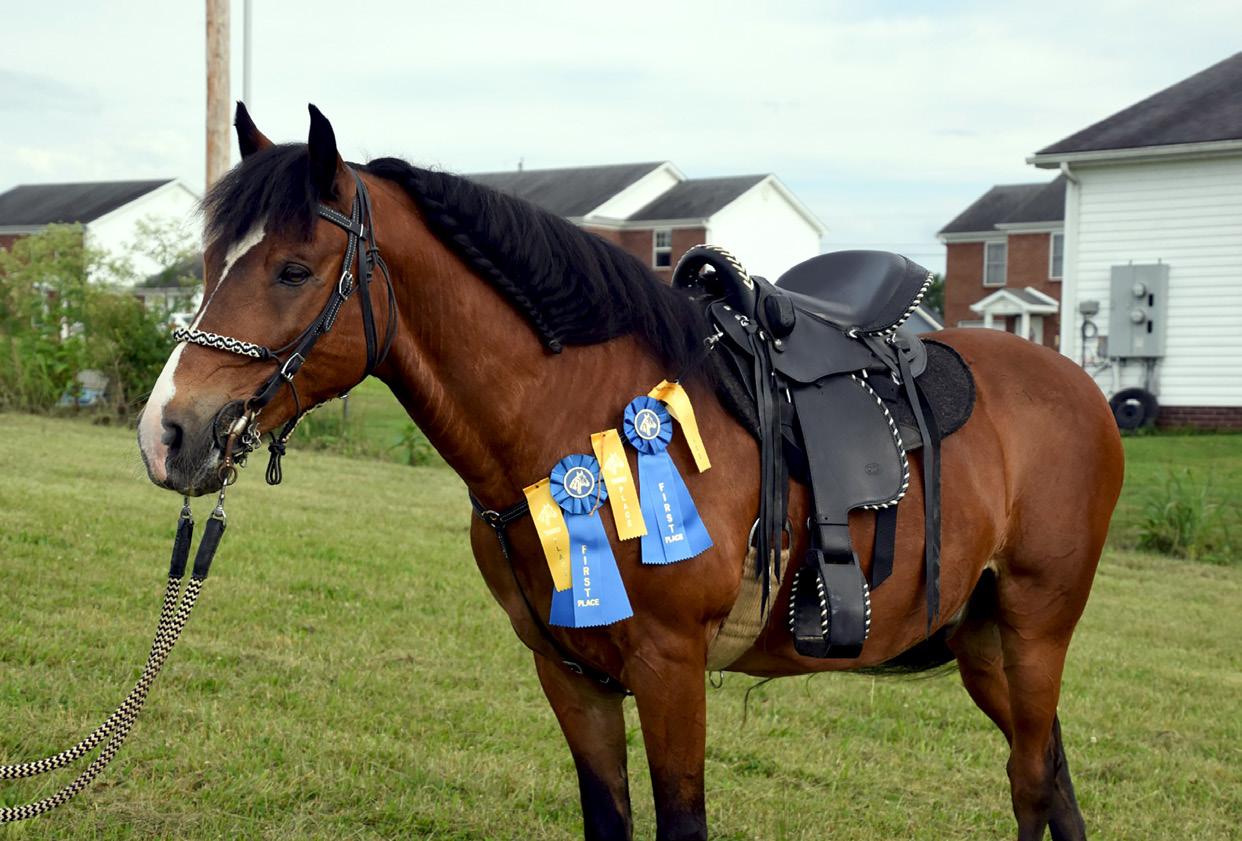
33 BORN TO GAIT • FALL 2023
News from Kentucky
Hello from Kentucky! We had a nice cold spell, but everyone is doing well with their heated water buckets and blankets when needed (though Omega doesn’t need one – he is like a wooly mammoth!).
Embajadora is continuing training at Hacienda Radiante. She will be coming to the Celebration Show in October!

We are pleased to announce a new member to our herd. Rayito de Oro, son of Cale’s Helado Oro and Tostada Hidalgo, has made the move from Texas to Kentucky. We are excited to add him to our herd and include his temperament, gait, conformation, and cremello color to our breeding program. He is a pleasurable stallion and will be offered for A.I. to serve mares. Look for his information in the Stallions Directory at the end of this magazine.

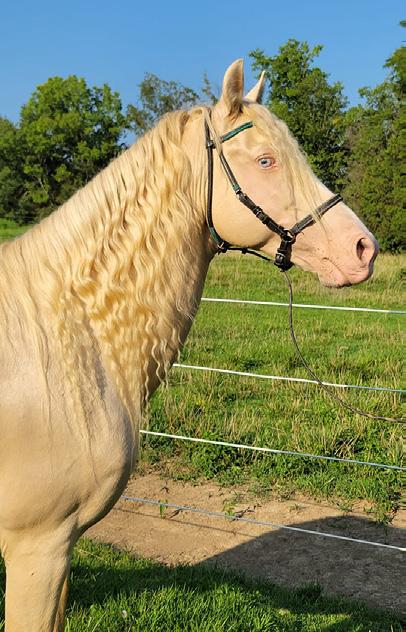
This section is yours! Send one or two high-resolution photos to editor.borntogait@gmail.com with a short paragraph. Please, PPR Paso Fino horses living in the continental United States and Canada only.
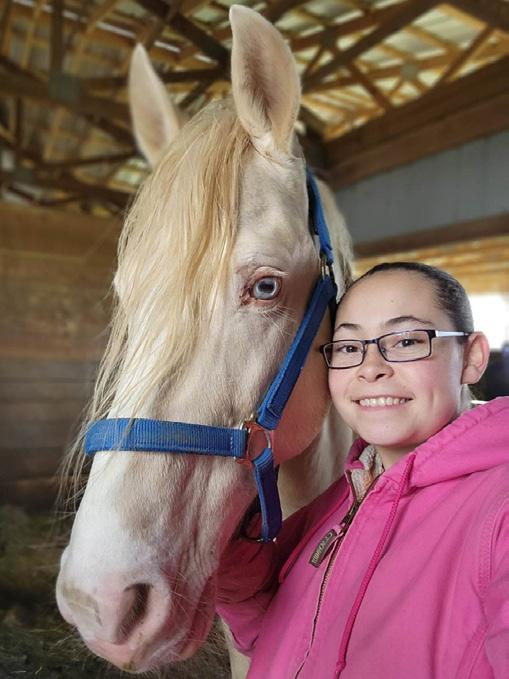
34 BORN TO GAIT • FALL 2023
News from Oregon
2023 has been a great year in the Pacific Northwest region. Six new foals to continue their effort is the conservation of the breed. All foals are by Armani del Sol, the Puerto Rican Bellas Formas Champion standing at stud in Oregon.
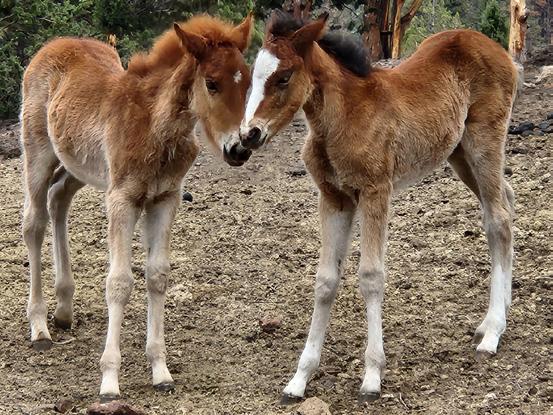

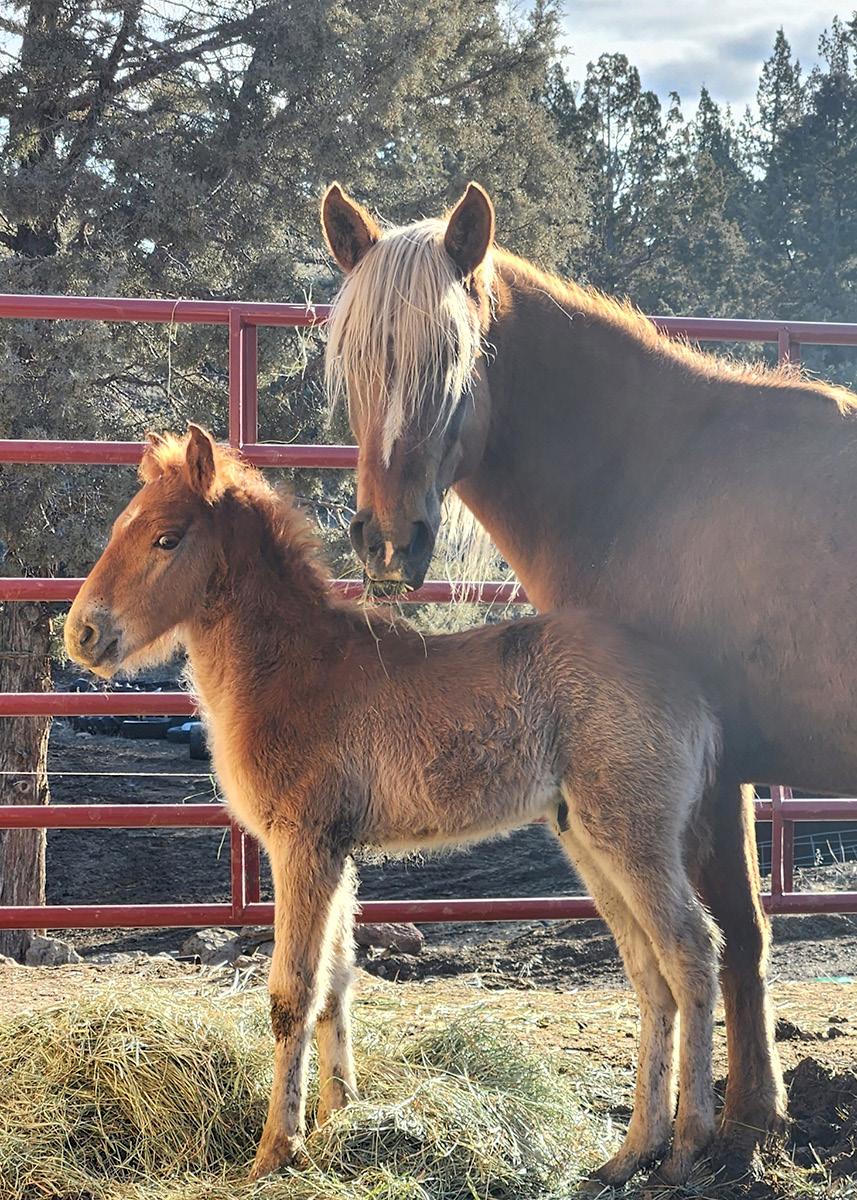



But that’s not all. The region also has a new stallion, Don Tata (aka Tater), a Puerto Rican import sired by Poema de Altura out of Sombra del Brujo. With this new stallion, genetic diversity in the PNW herd continues to increase.

35 BORN TO GAIT • FALL 2023
News from Florida
James Zeno and Finca La Charca new filly is a beauty! Cleopatra de la Charca is by Mago de Pride out of Melodía del Caribe, Jaime’s foundation mare. Melodía was bred to Romeo de Pride for a 2024 foal.
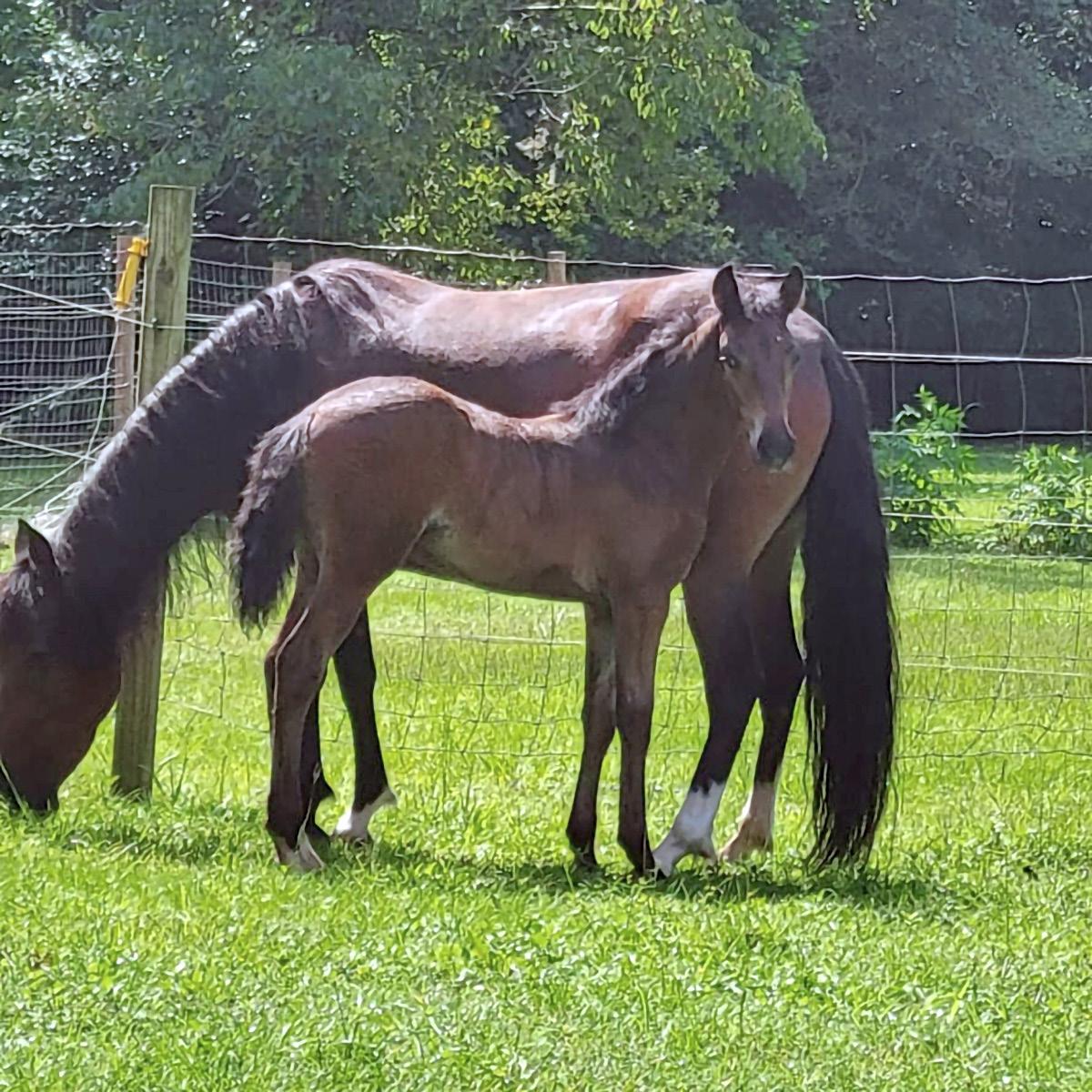
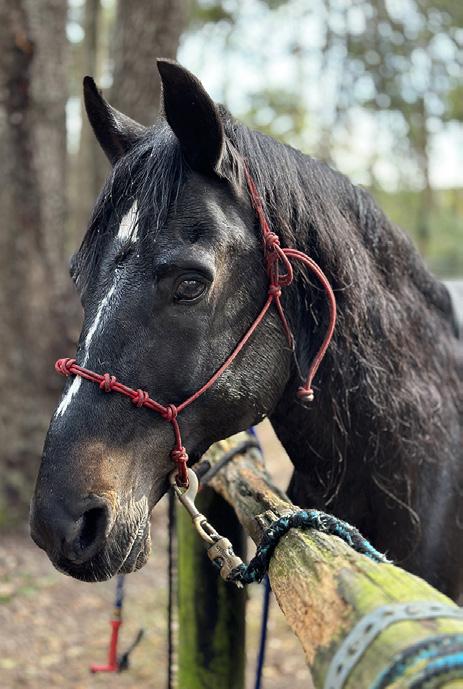


Pedro Burgos and Criadero Villa Burgos are celebrating with the birth of Romeo de Pride’s first foal. Pascua is the proud mom of this wonderful colt that carries the blood of the best PPR Paso Fino horses in the United States.

The Pure Puerto Rican Paso Fino Federation of America 2022 Classic Grand Champion Pleasure and Performance colt is back home in Florida. Diseño Taino D’Mi
Borinquen (Mago de Pride x Aroma de Las Magnolias) is proudly owned and deeply loved by his owner Denisse Cancel.
36 BORN TO GAIT • FALL 2023
News from South Carolina
Born to Gait would like to congratulate Shaw Laney and Cedar Lane Stable on the acquisition of the Pure Puerto Rican filly by Plebeyo de Pride out of Reina de Pride.
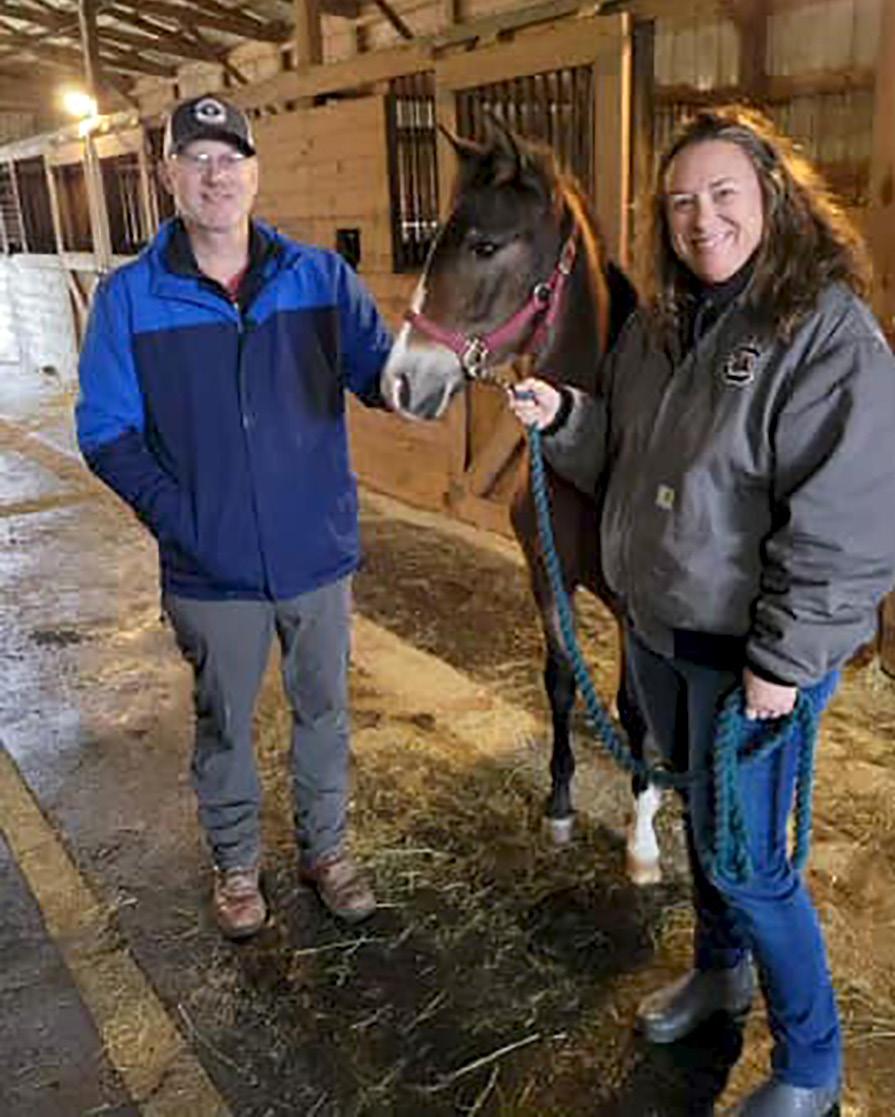
Palmetto Pride Farm, home of Mago de Pride, Plebeyo de Pride and other amazing horses, has been very busy with last year’s crop and the arrival of the new 2023 foals. It is good to see that the breeders are active and the number of horses is increasing.
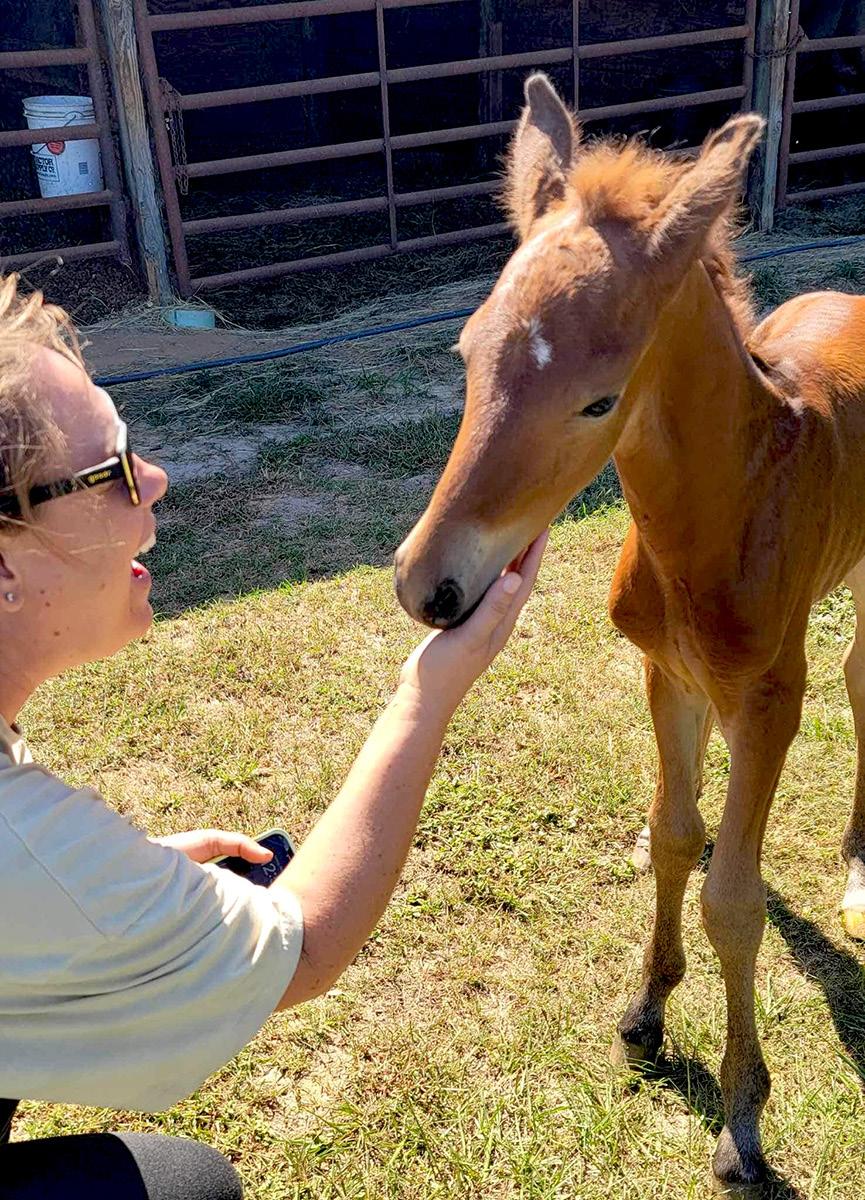
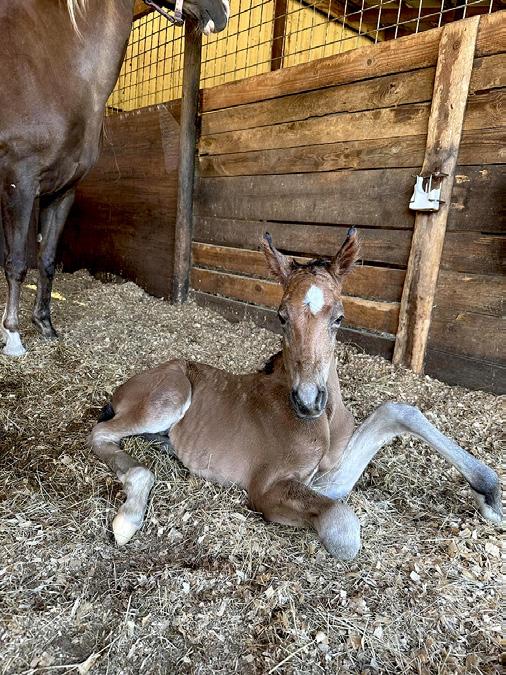
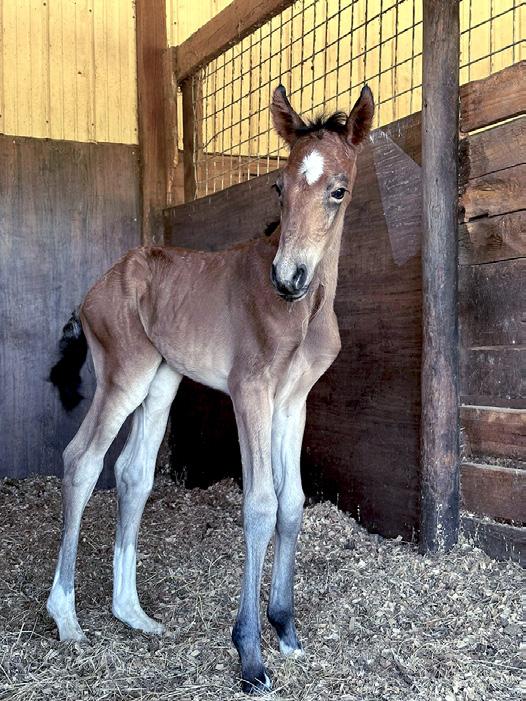

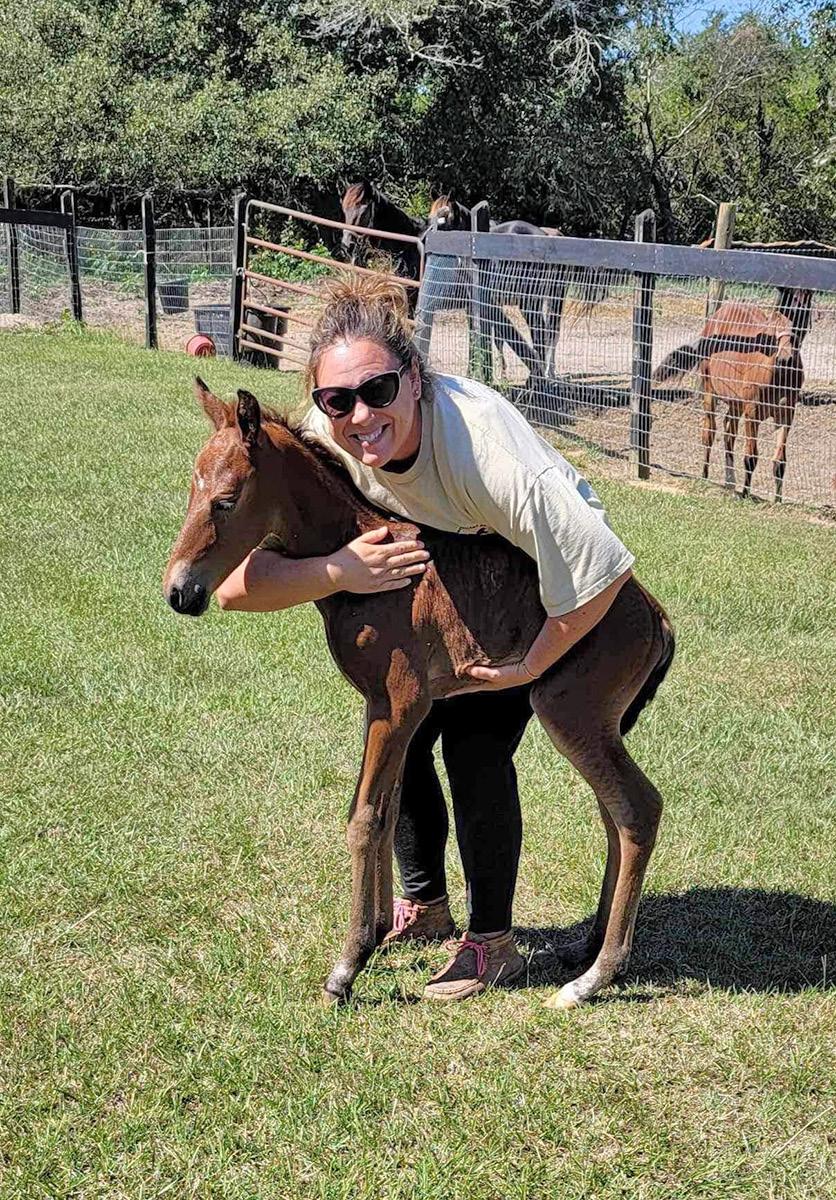
37 BORN TO GAIT • FALL 2023
News from Texas
Promoting the breed is as important as breeding, and that is one of the many things Dr. Ramón Bodón and Kofresi Royal Farm are doing throughout the schools in Killeen, Texas. During his visits, Dr. Bodón tells the students about the training of the Puerto Rican Paso Fino, its history, and its endangered status. “It is important to create experiences where students have the opportunity to learn firsthand about our breed,” told Dr. Bodón. Two thumbs up to Kofresi Royal Farm for this initiative.

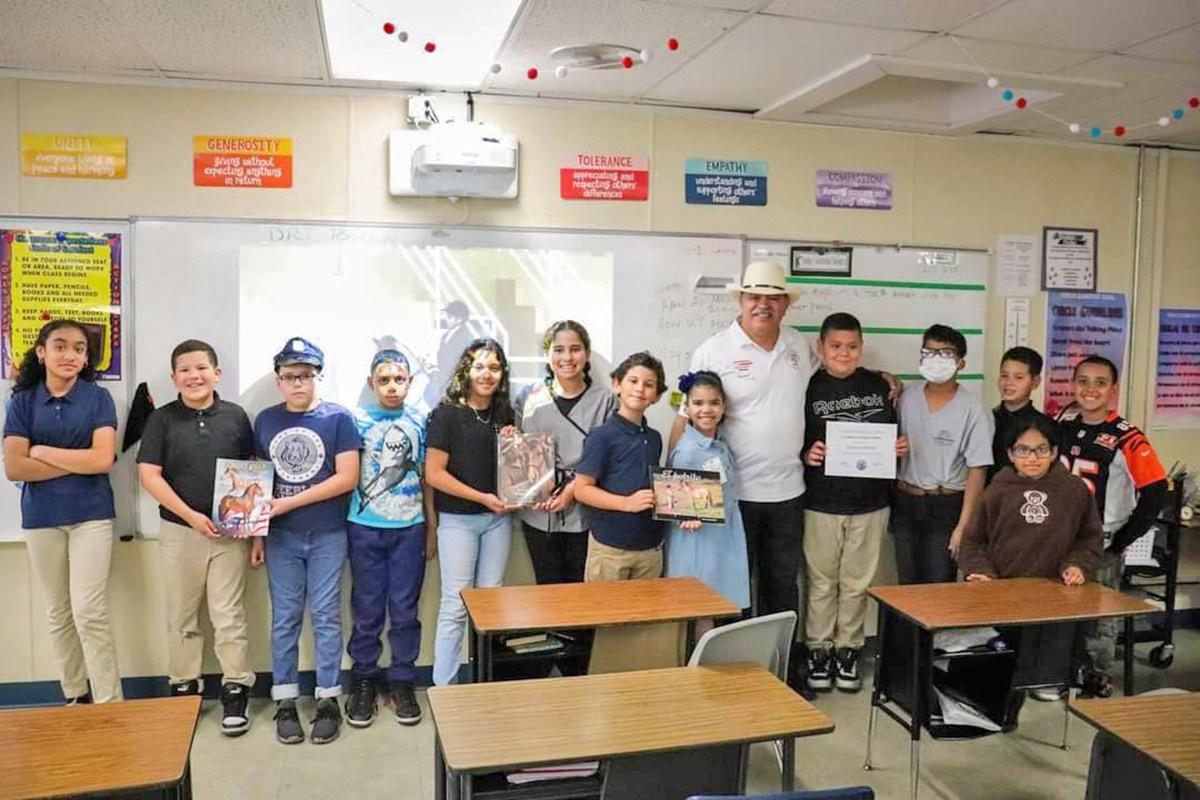
News from Missouri
A new match made in heaven for Tracy Hernández and Buckeye Ridge Paso Finos! A 2024 foal is expected by Imperio Royal, the great Classic Fino and Bellas Formas champion, out of the great mare Camelia de Pride. Congratulations on such a wonderful cross!
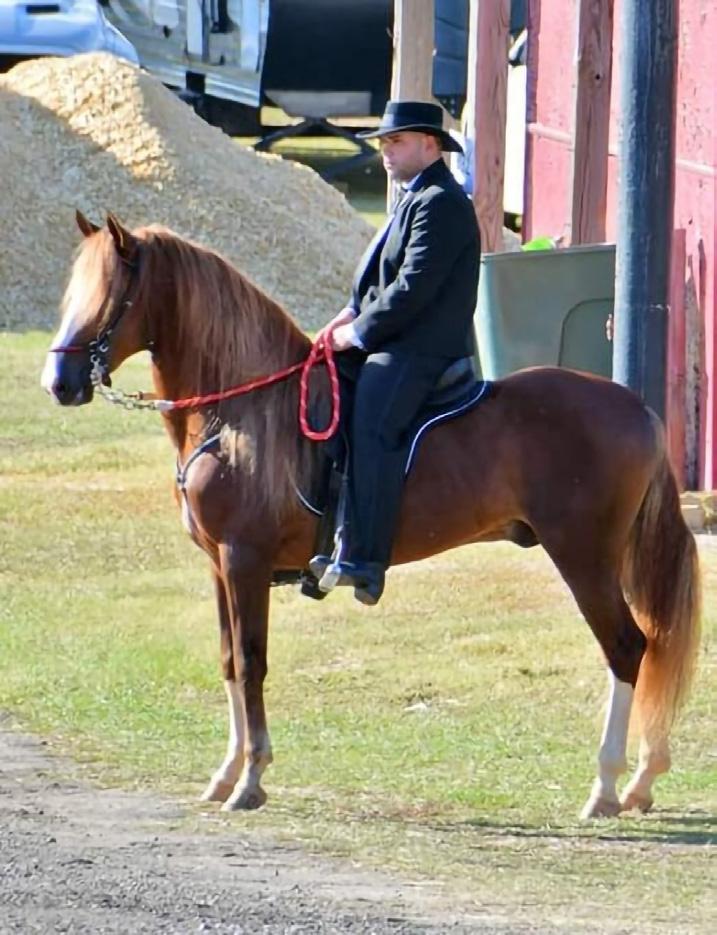
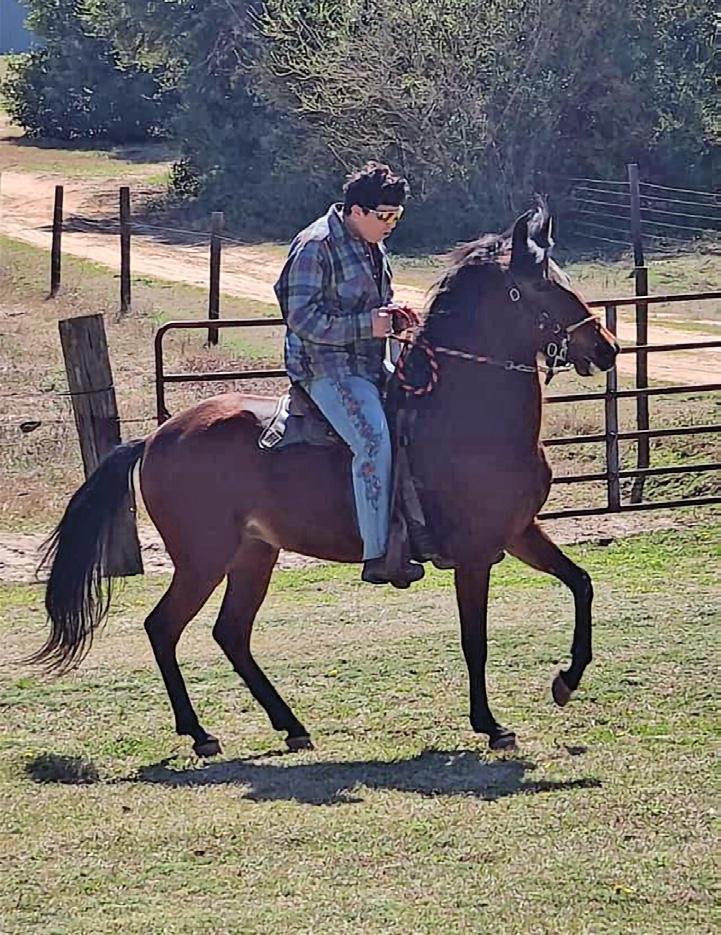
38 BORN TO GAIT • FALL 2023
In Memory of Eduardo Figueroa
This year we received the sad news of the passing of Eduardo Figueroa Conde. The Pure Puerto Rican Paso Fino breed will always be indebted to him and he will be remembered as one of the greatest of the Figueroa dynasty.
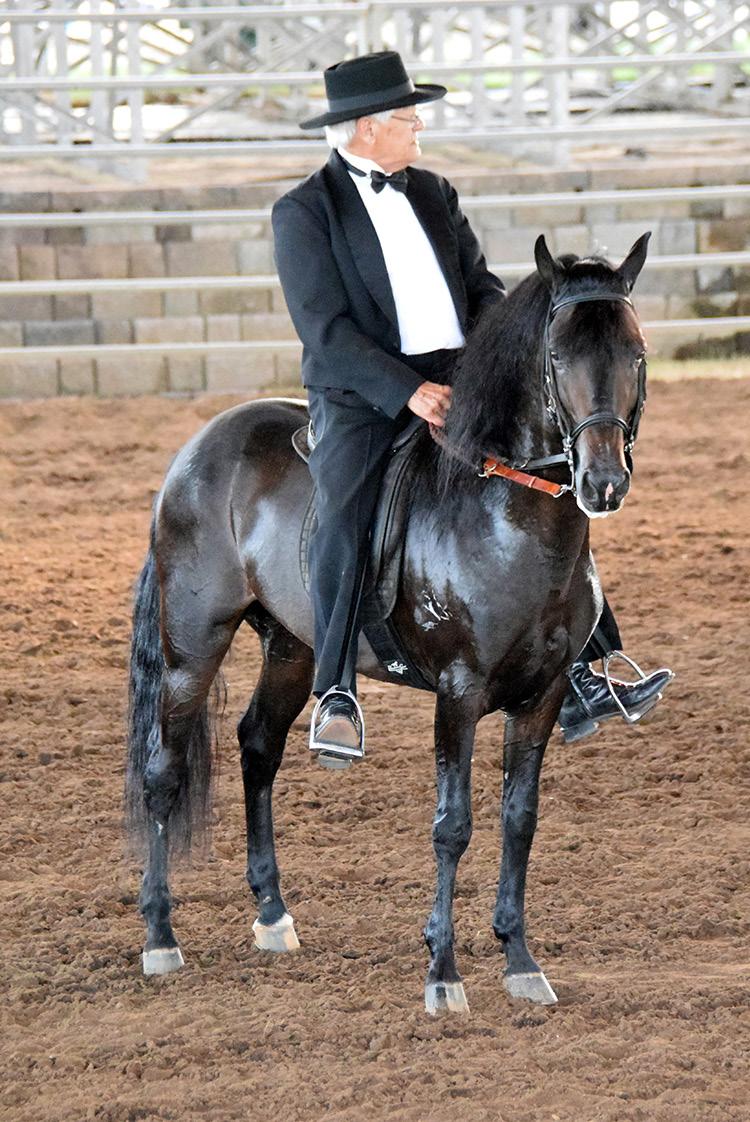
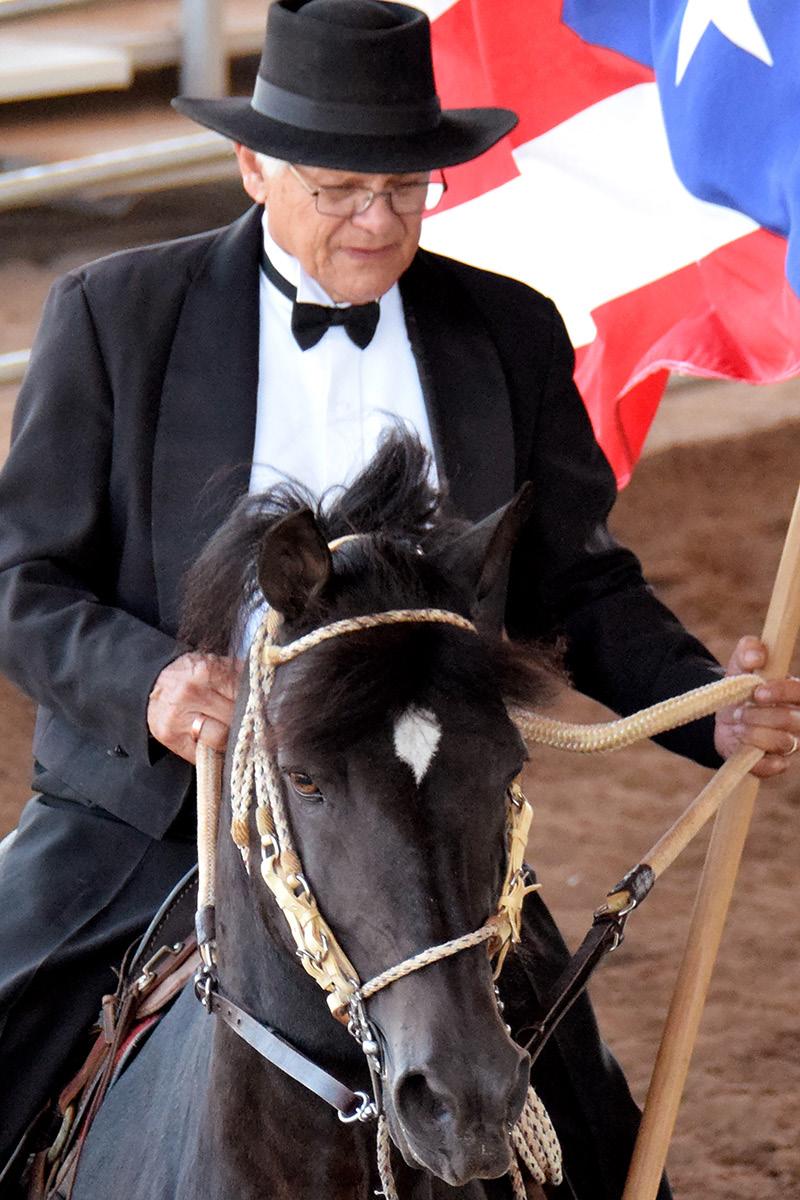

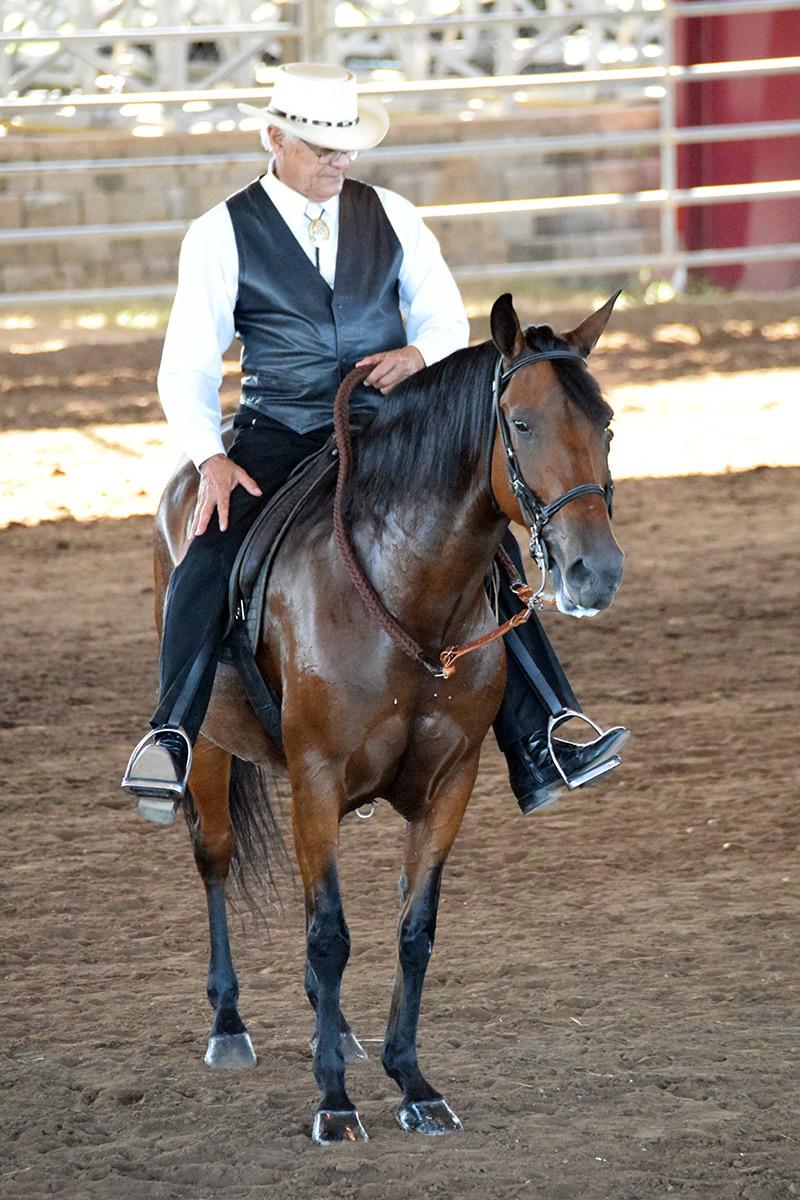
39 BORN TO GAIT • FALL 2023

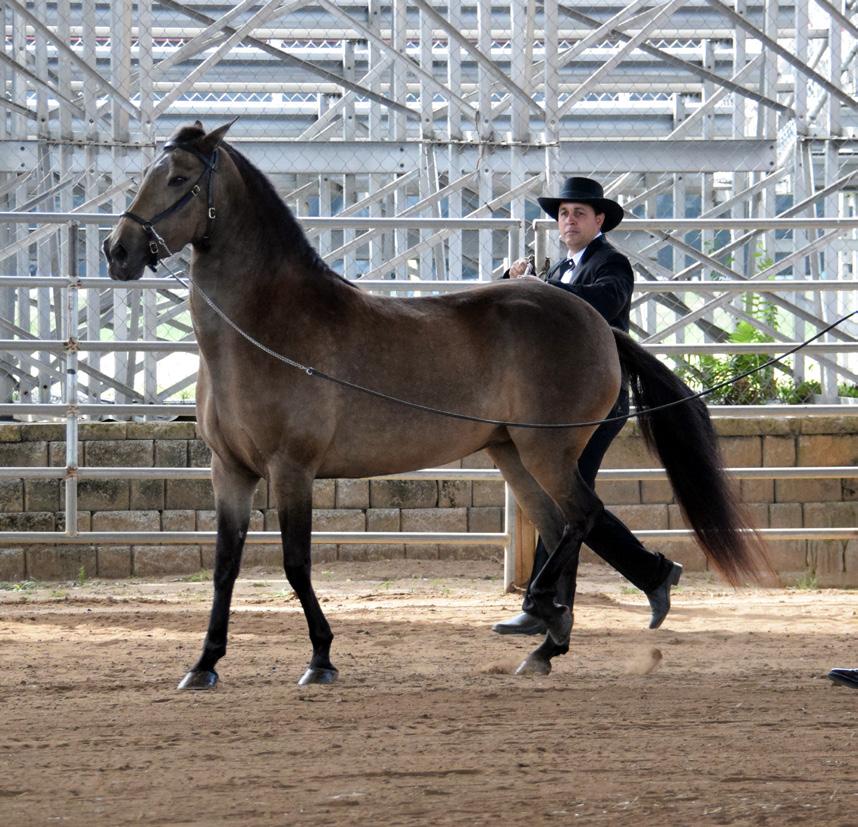
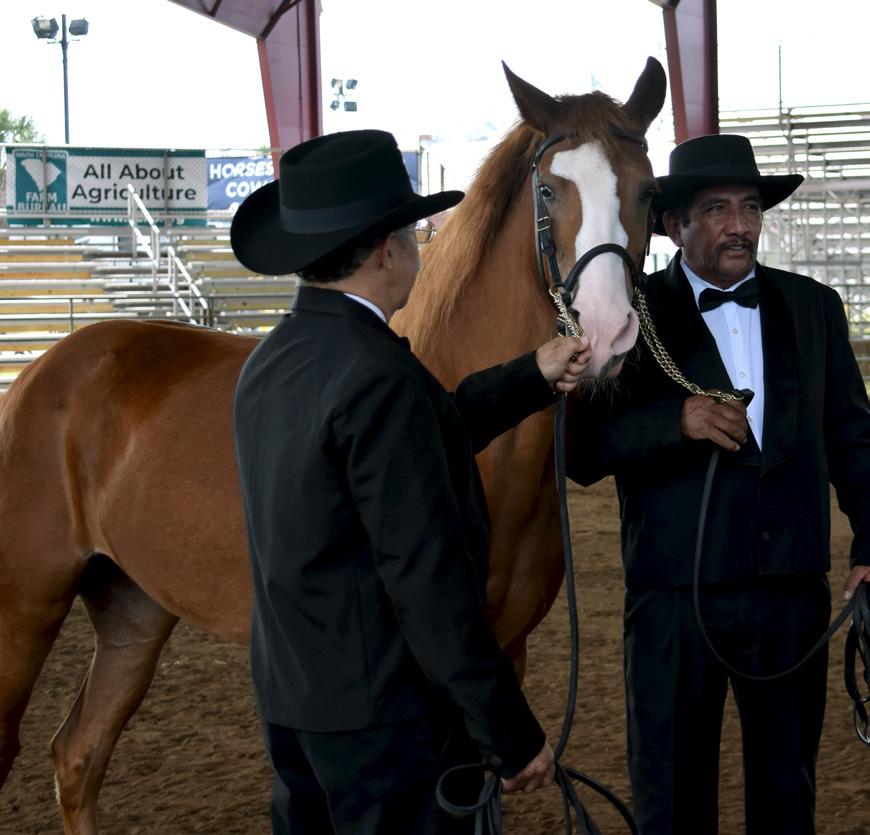

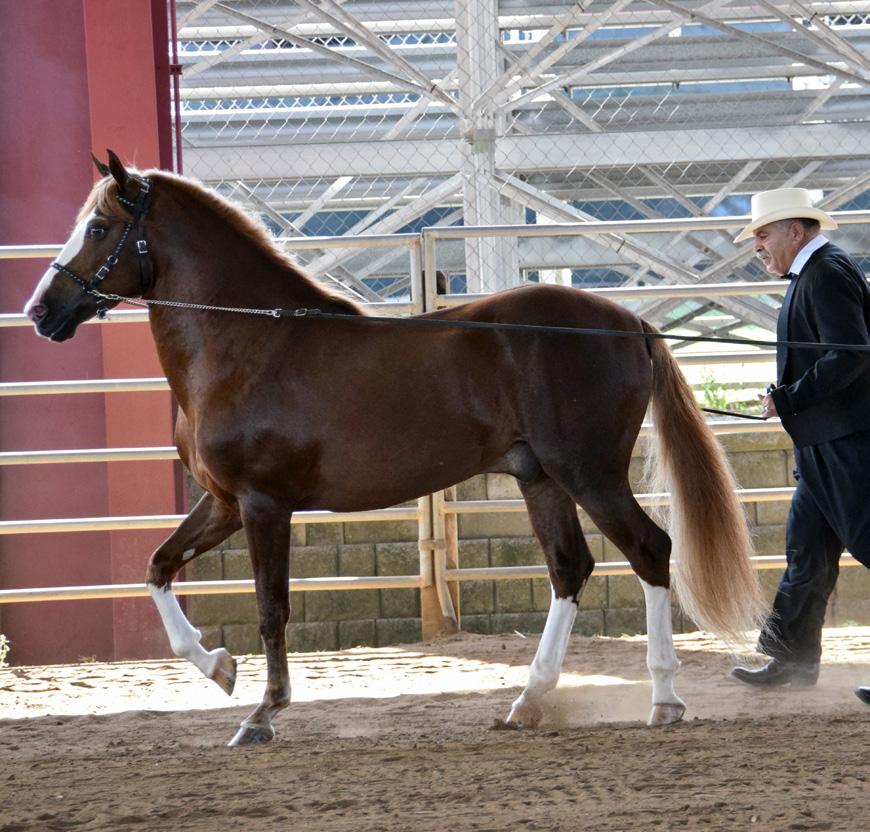
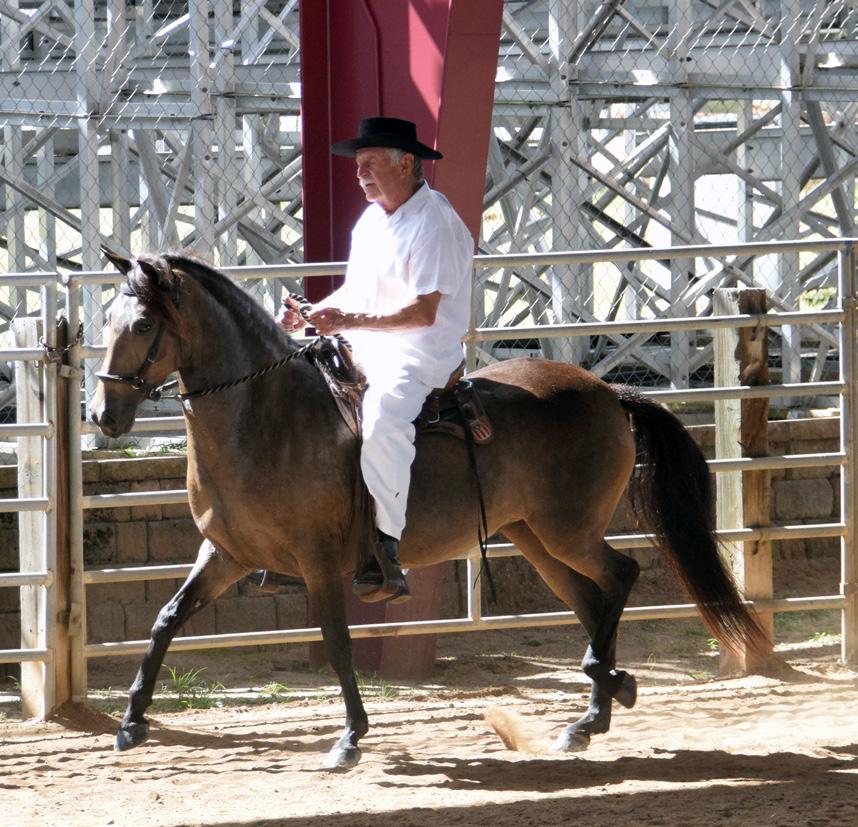
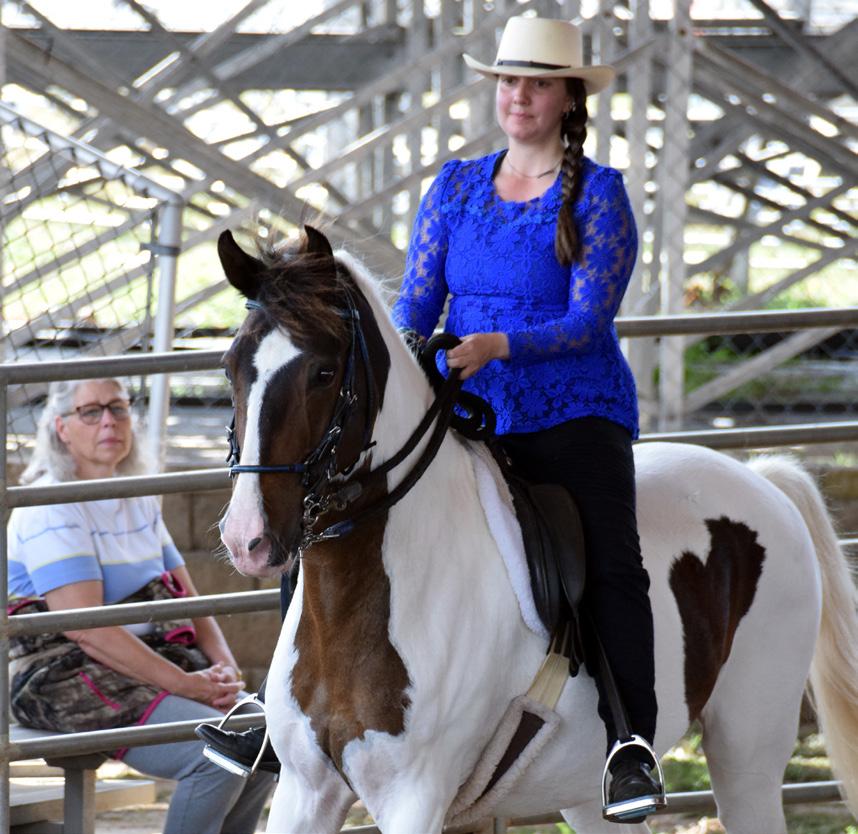
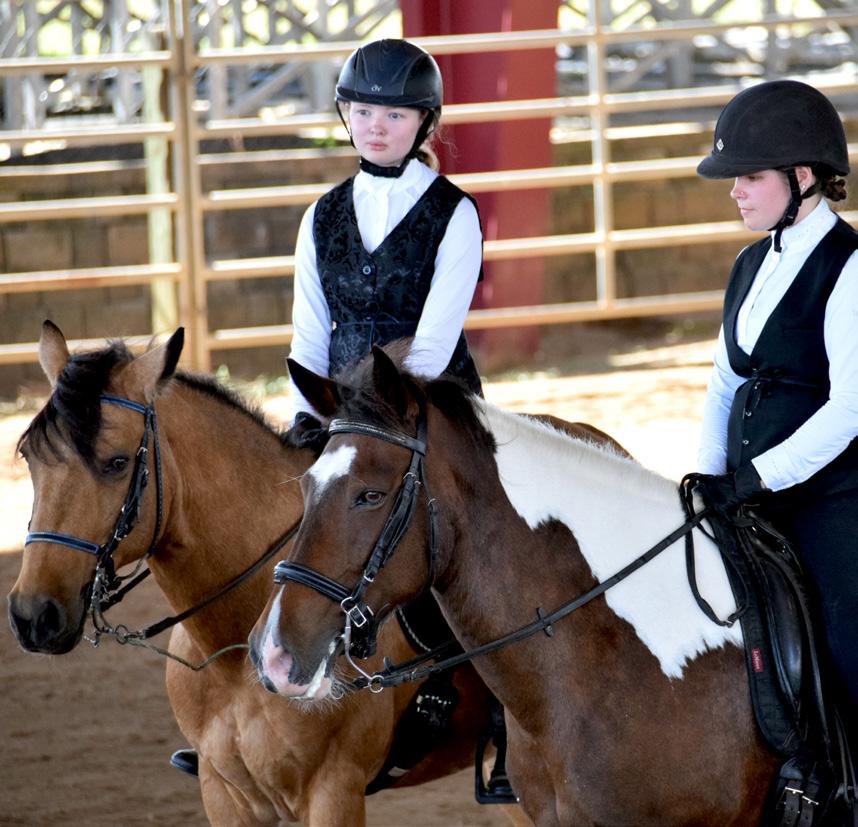
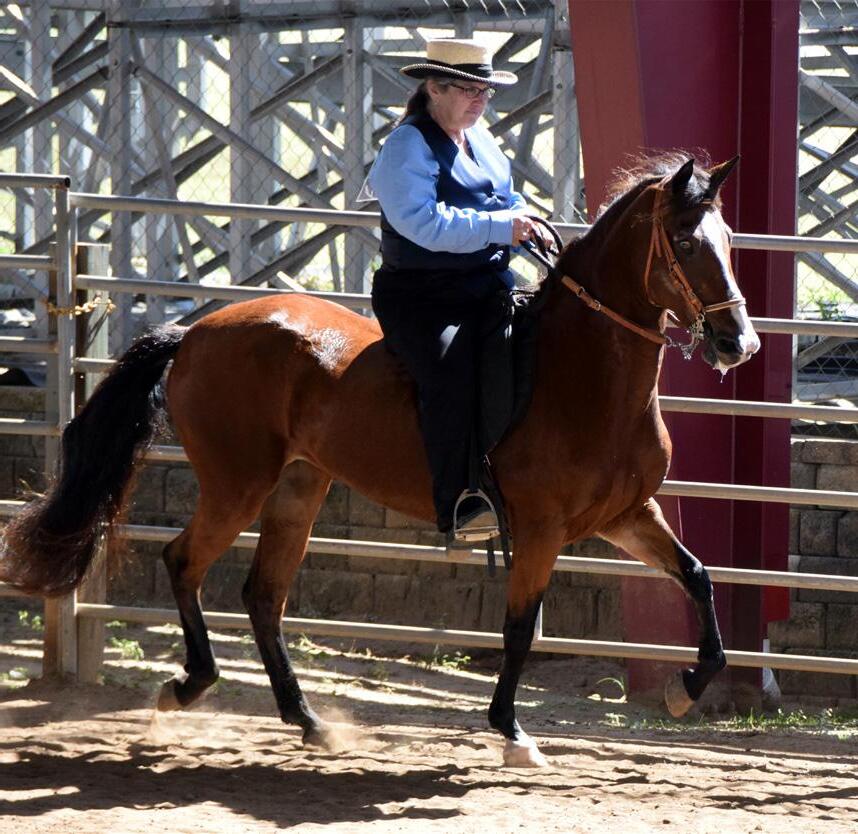
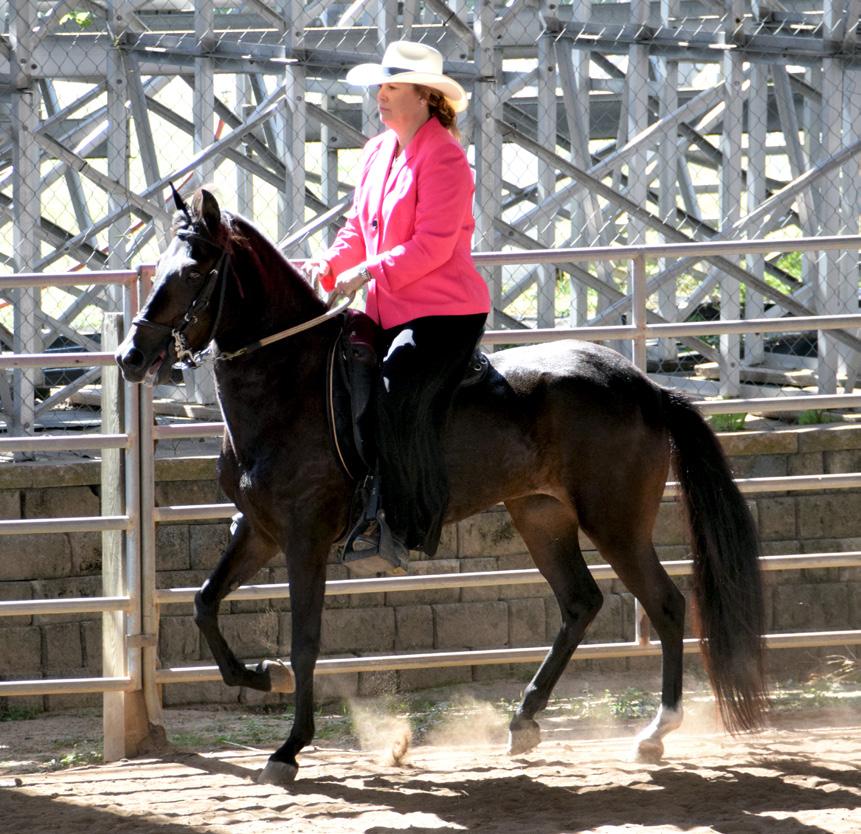
ANNUAL CELEBRATION SHOW OCTOBER 2022
ANNUAL CELEBRATION SHOW OCTOBER 2022

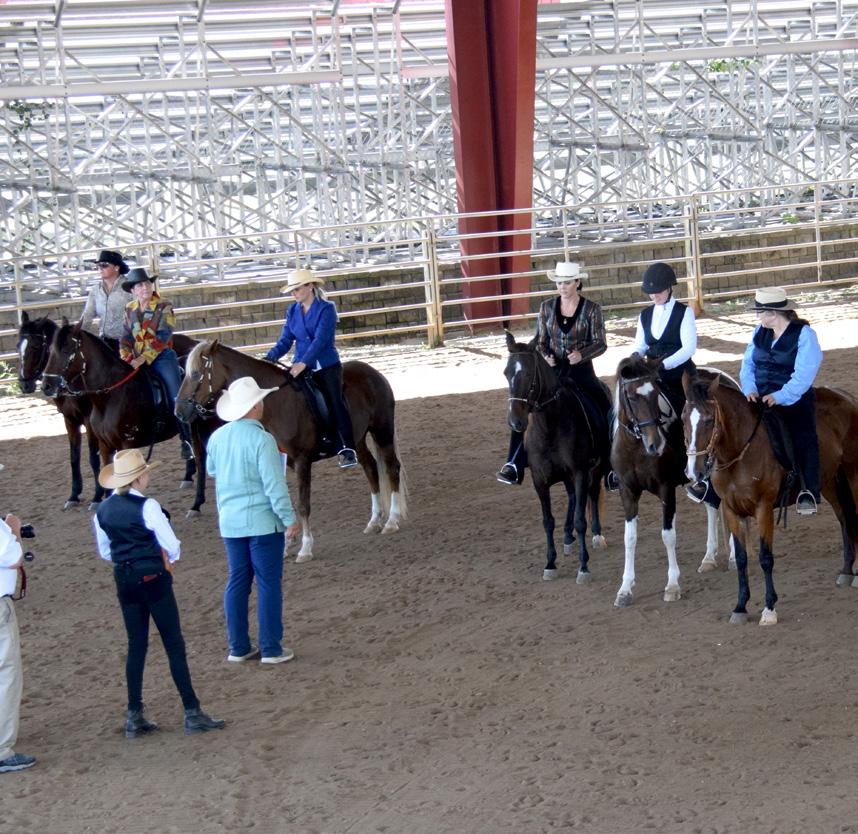
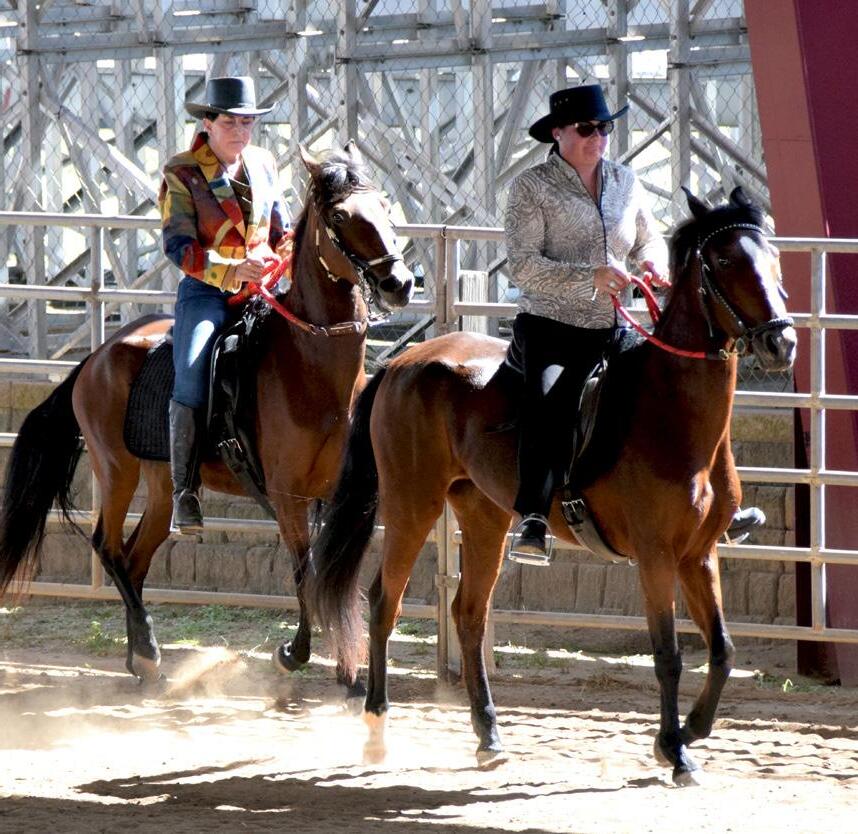
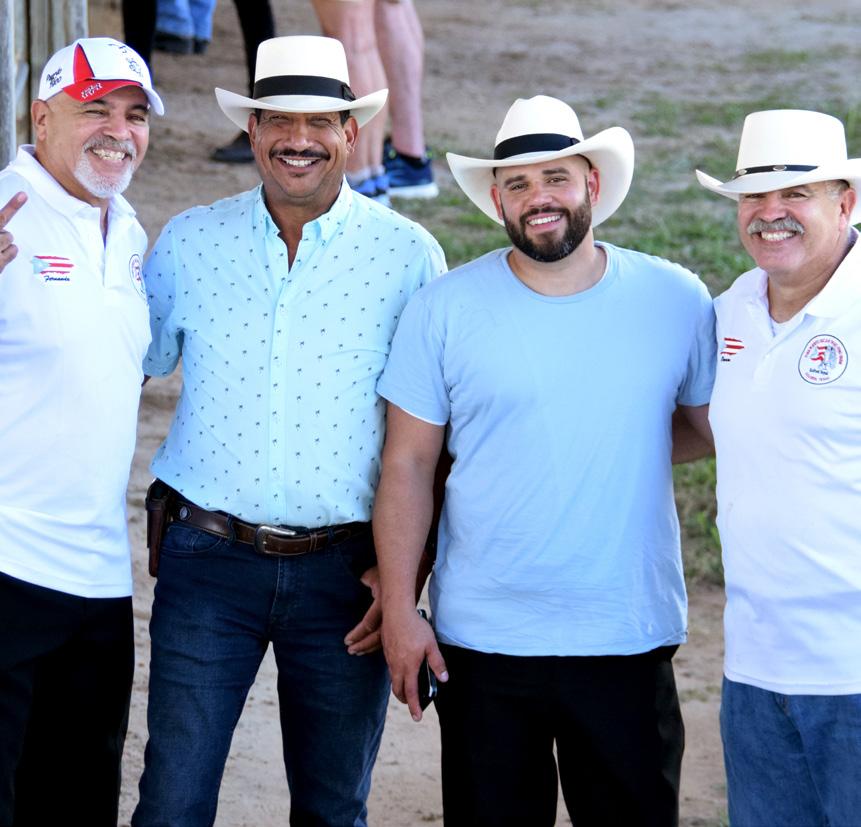
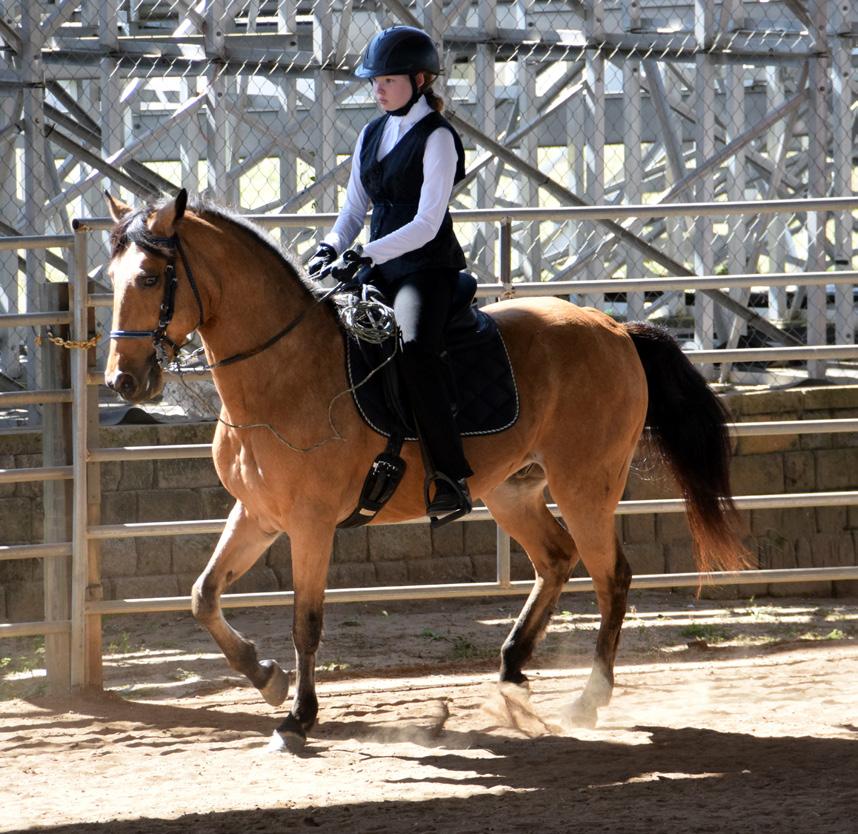
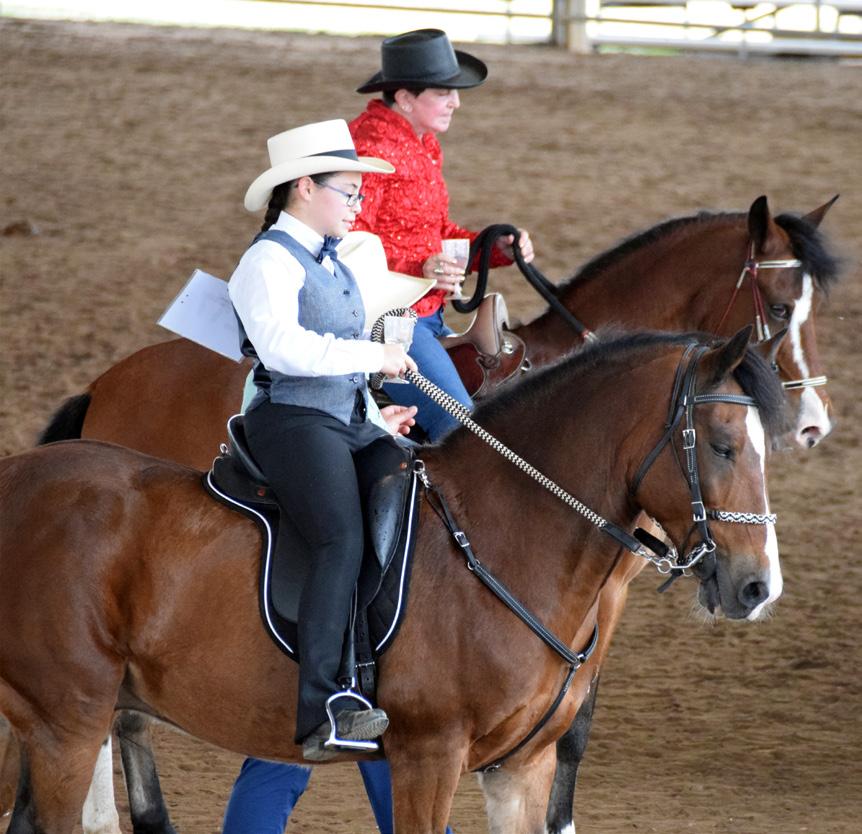
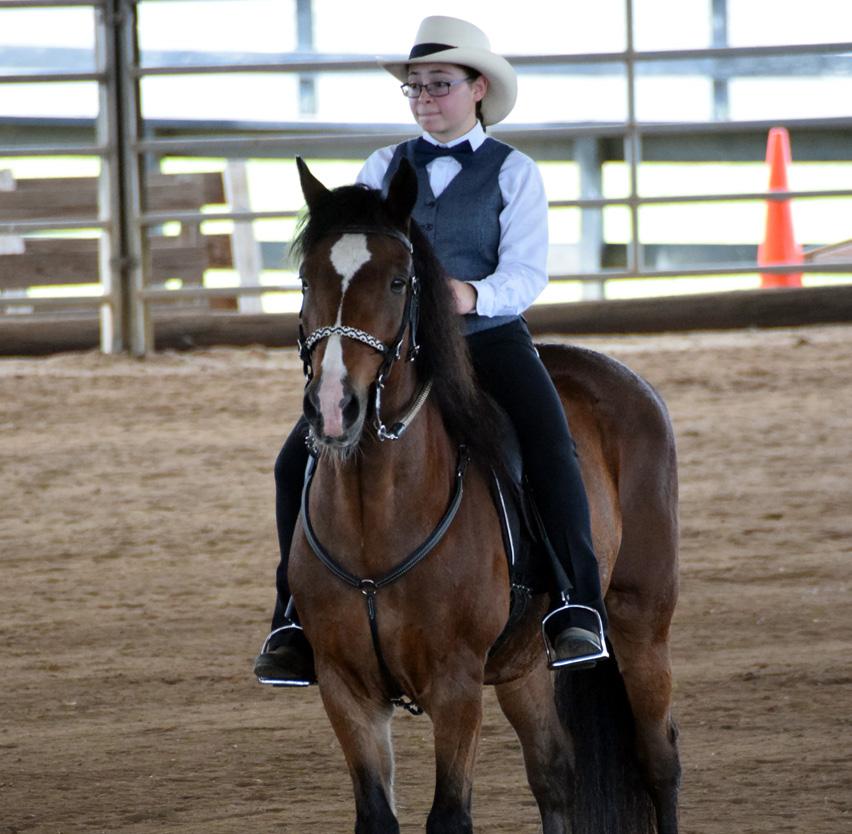
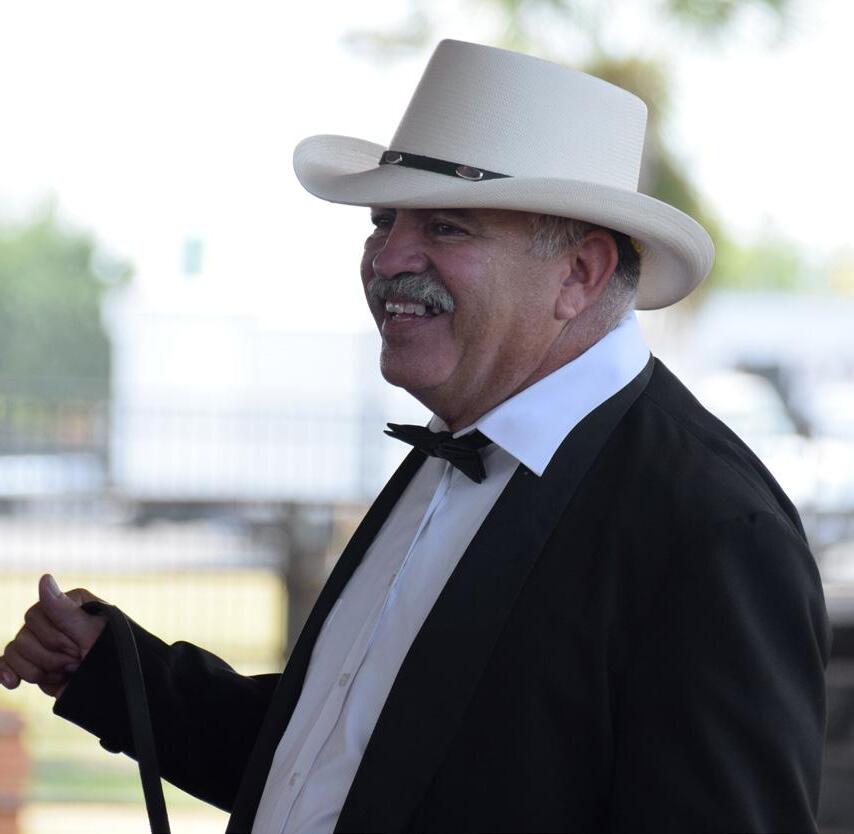


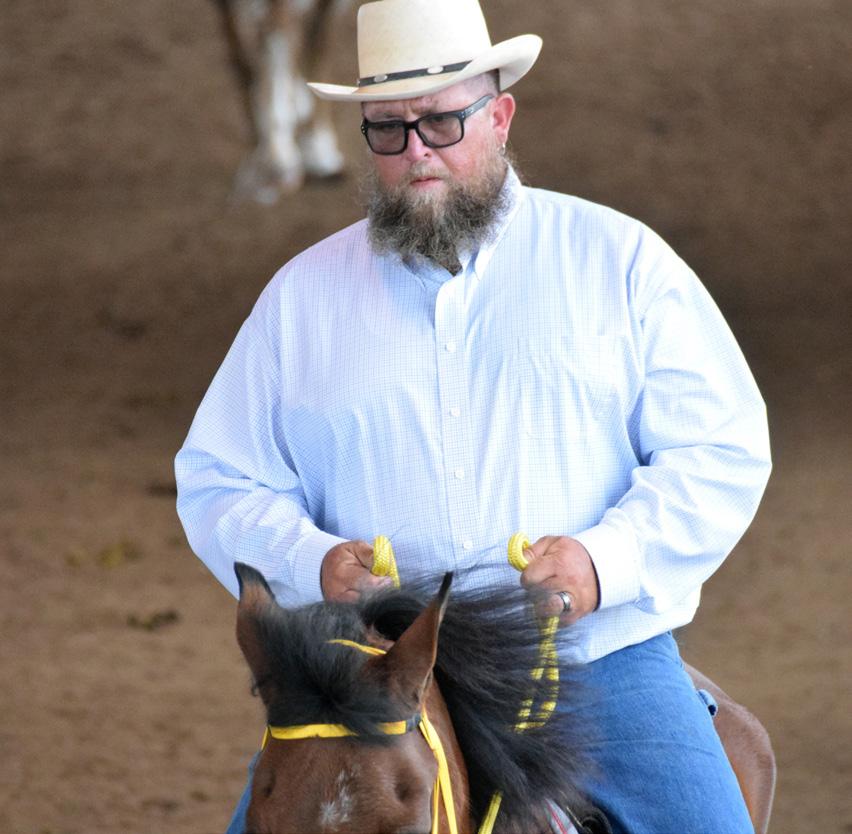
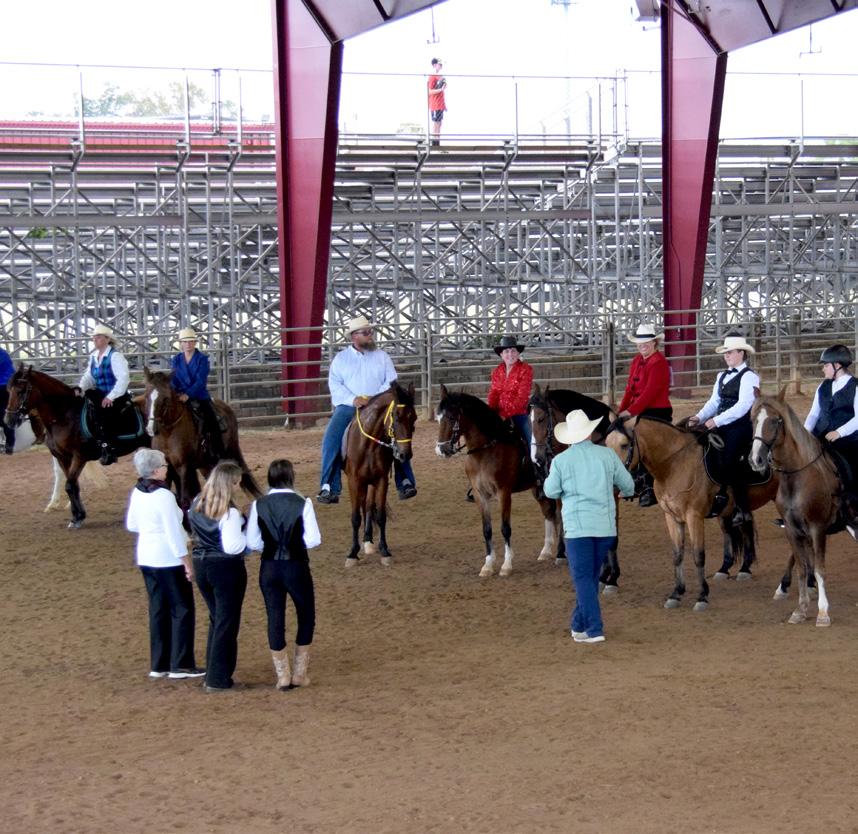

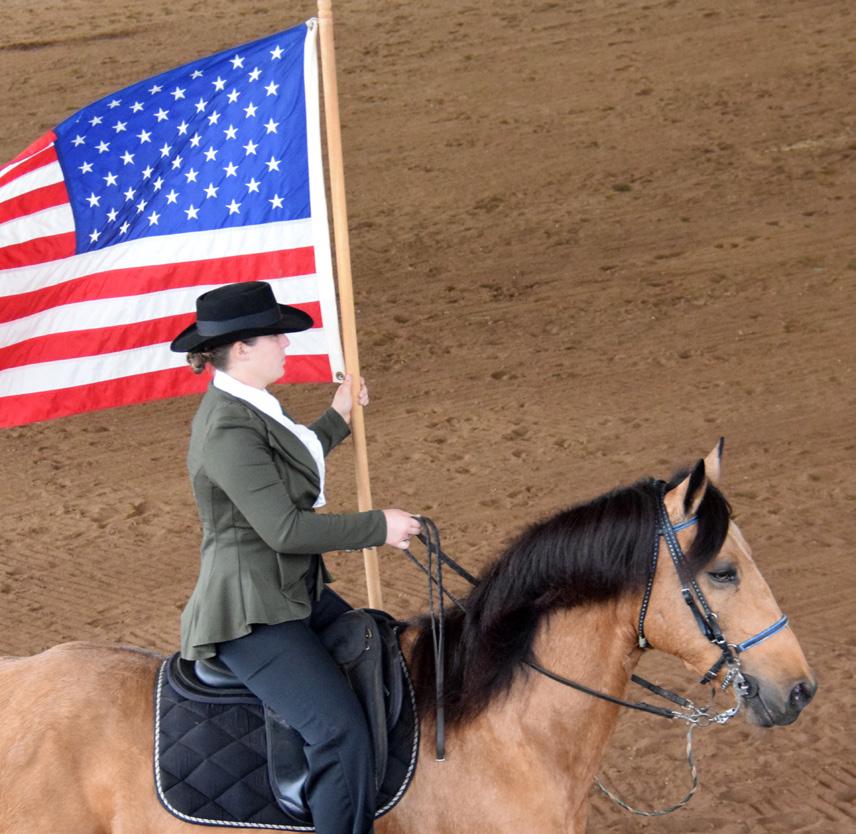

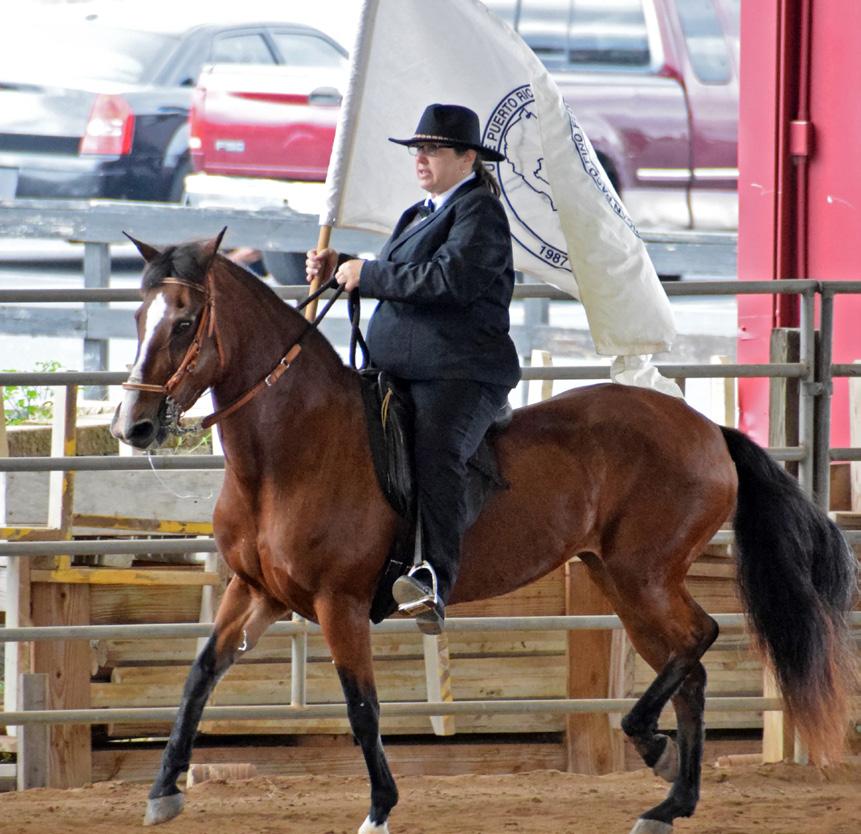
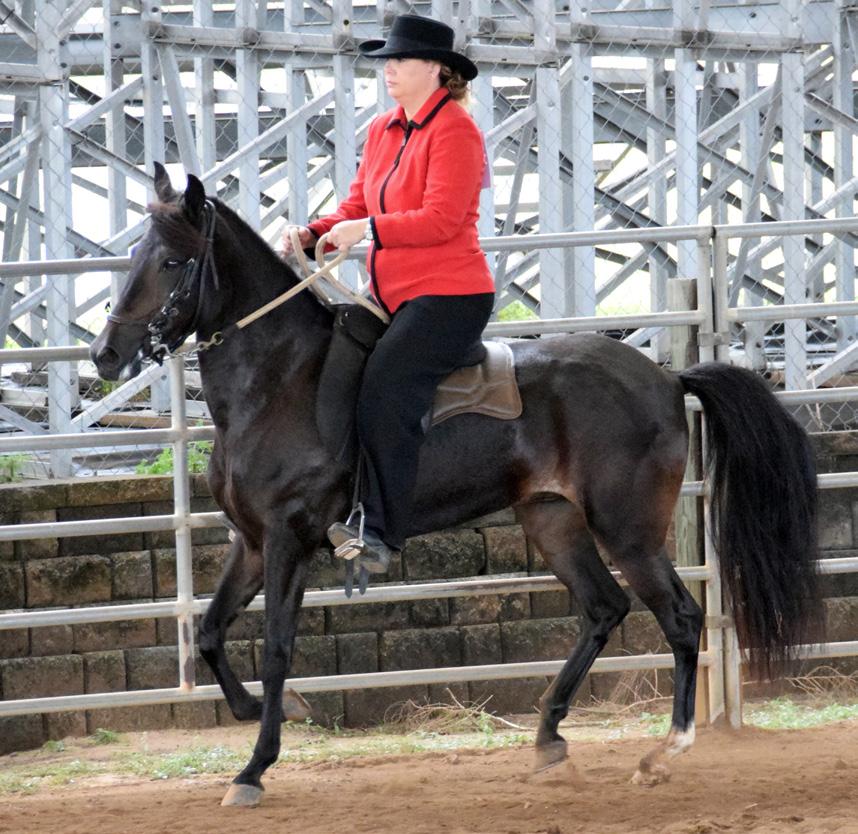

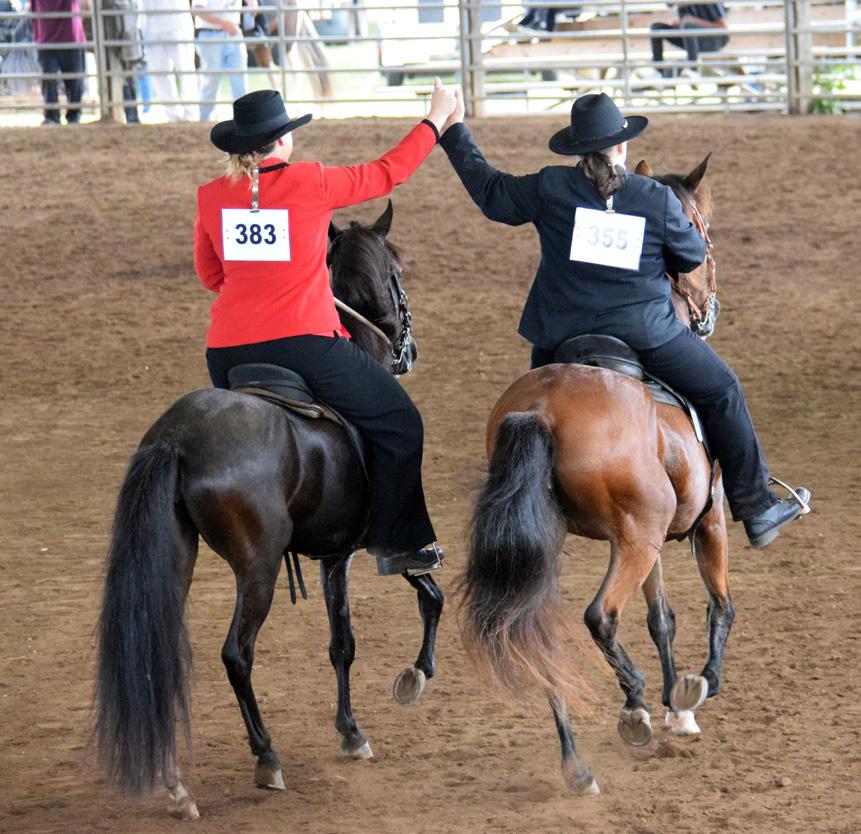


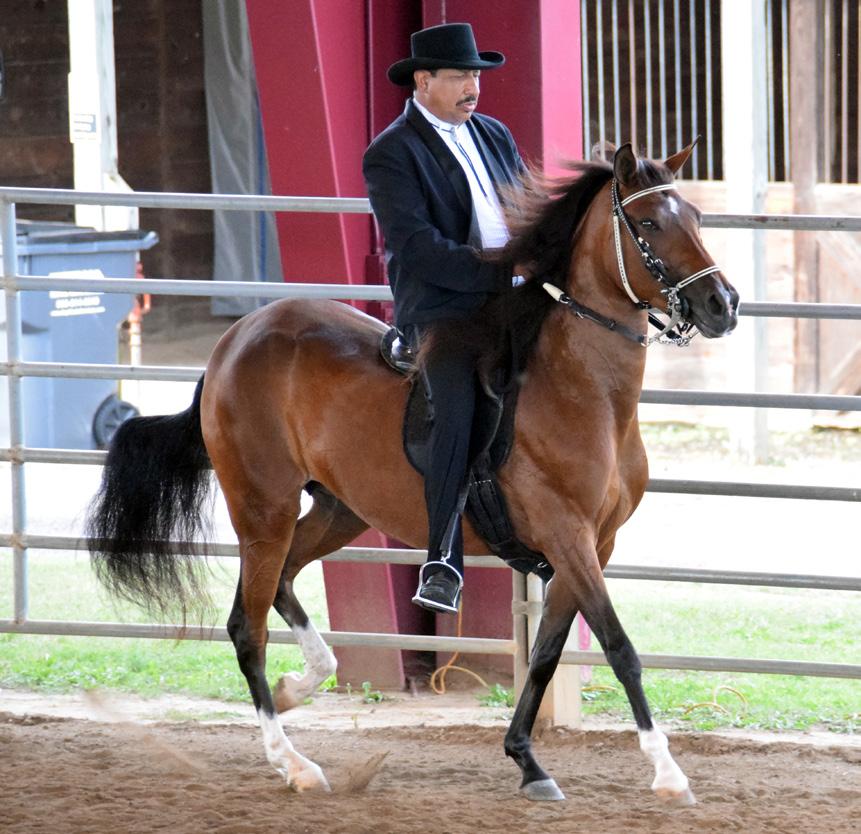

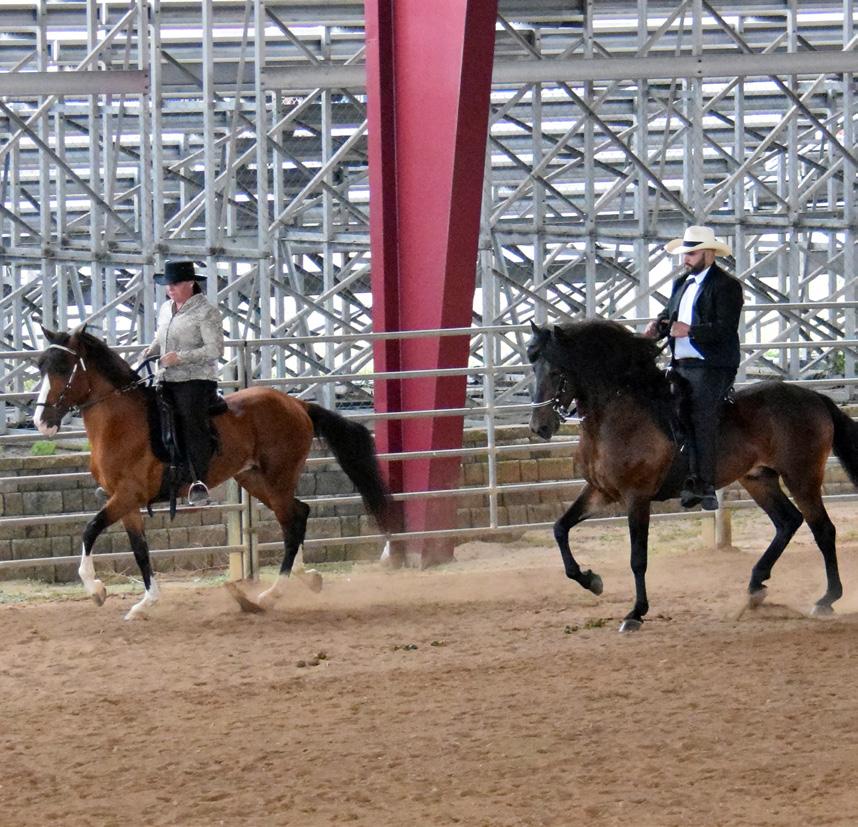




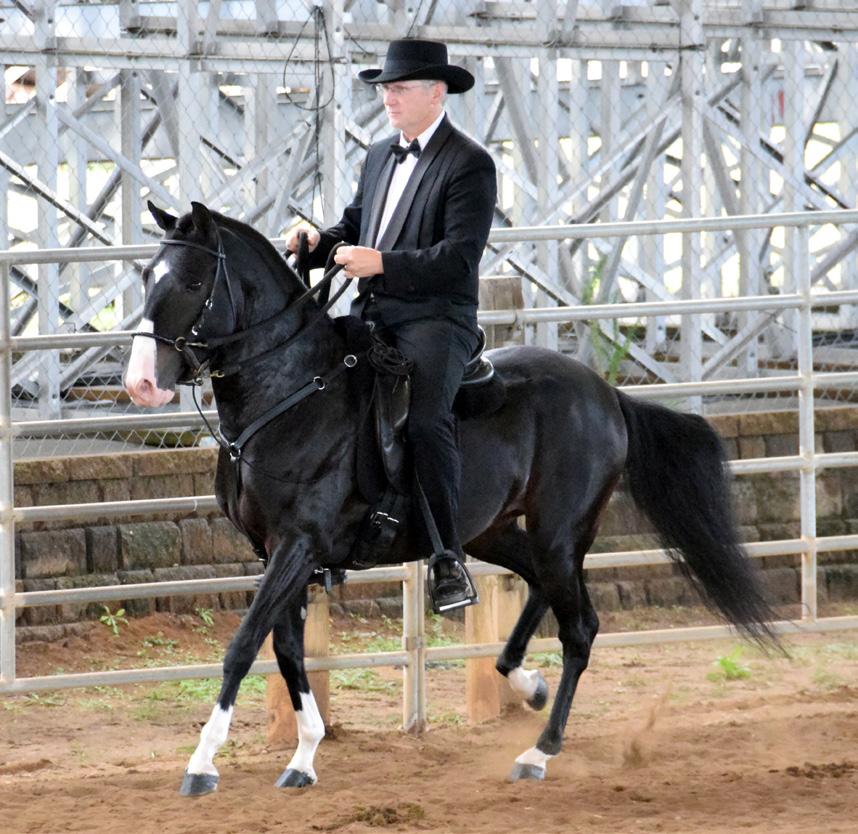

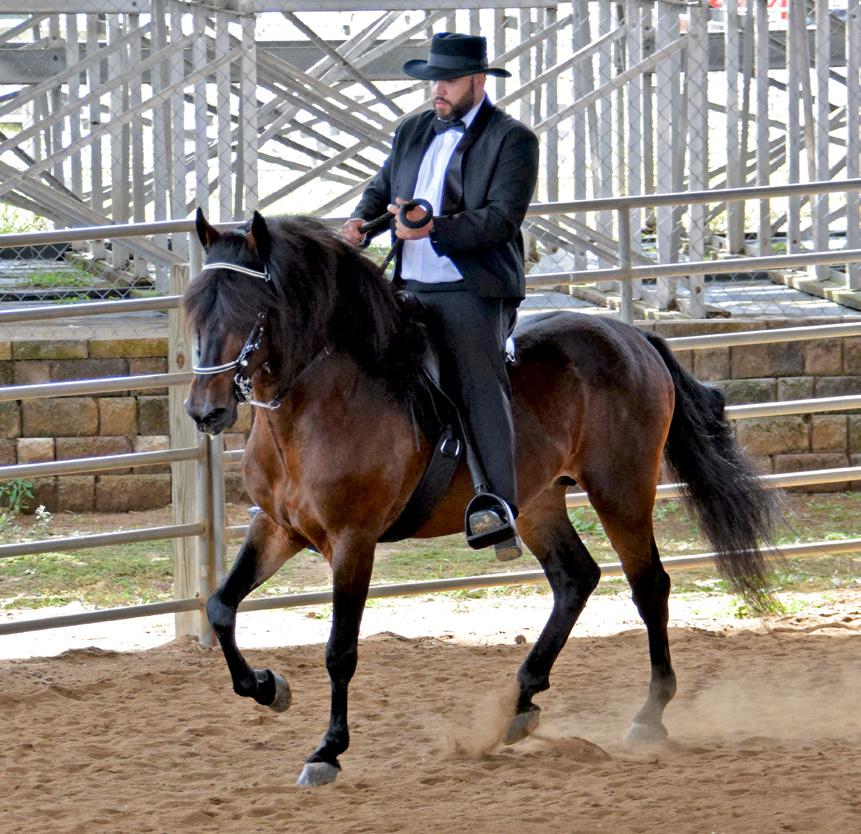
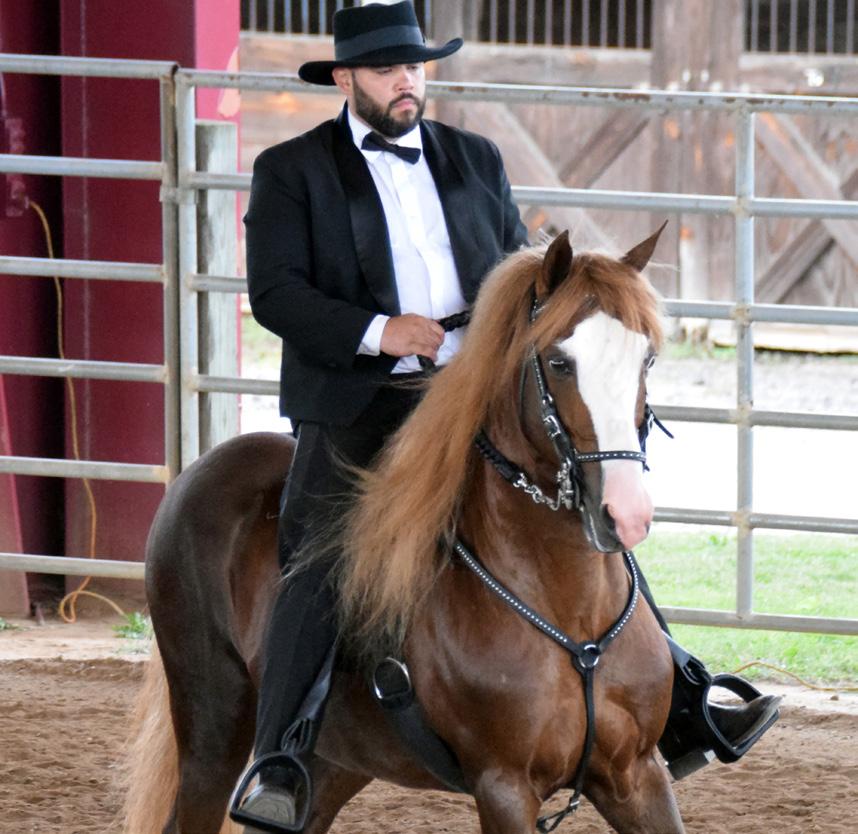
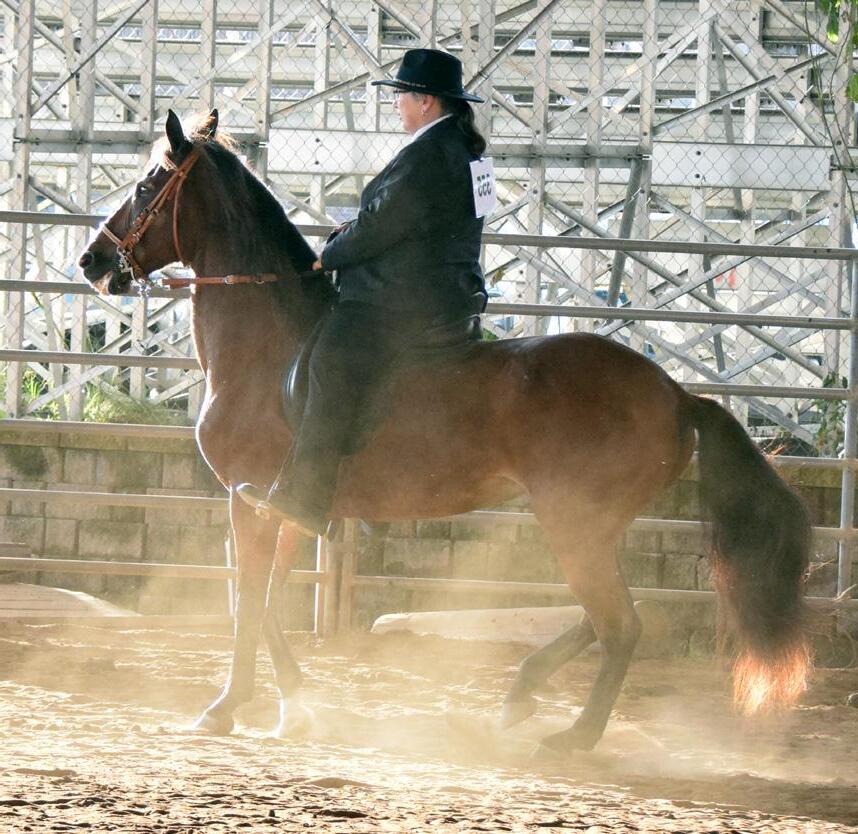



Owners’ directory
ALABAMA
Barbara Thompson Montgomery, AL
T.
E. CALIFORNIA
William Sanders Baroque Dressage __, CA
T.
E. COLORADO
Eric Aurelius Testori Englewood, CO
T.
E. 1_cipo@yahoo.com
FLORIDA
Ann Shirley Ashley Benifay, FL
T. 801-622-3237
E.
Penny Bollhorst Mayo, FL
T. 540-493-6423
E. pennyb@sitstar.net
Pedro Burgos Castadero Villa Burgos Tallahassee, FL
T. 787-244-0832
E. pfg2121@yahoo.com
Denisse Cancel
D’Mi Borinquen Paso Fino
Micanopy, Florida
T. 352-246-9983
E. denissecancel@hotmail.com
Cindy & Brent Forehand Paces Creek Stables
Monticello, FL
T. 850-661-7777
E. bcforehand@gmail.com
Edgardo Fullana
Palm City, Florida
T. 561-797-8052
E. fullanae@hotmail.com
Barbara Preiss Weirsdale, FL
T. 352-821-1300
E. cwpreiss@aol.com
Carlos Rosado Hacienda RB
Ocala Florida
T.
E. wen_bur@yahoo.com
Ruth L. Thompson Raison Dunnellon, FL
T. 740-935-5252
E. ruth@raisongroup.com
James Zeno Finca La Charca Morriston, FL
T. 845-522-3361
E. civillawcasemanagement@gmail.com
GEORGIA
Rufino Figueroa
Toccoa, GA
T. 706-244-1294
E. rufinofigueroa@icloud.com
LuAnn Lackey
Ellijay, GA
T. 706-636-1682
E. llackey@ellijay.com
Rence Slappy Fortson, GA
T. 706-505-5217
E. arslappy@gmail.com
INDIANA
Karl Nussbaum
Dreamalot
Scottsburg, IN
T.
E.
KENTUCKY
William & Teresa Arias
Hacienda Boriken
Salivisa, KY
T. 904-233-0092
E. william@ariasonline.net
Xiomara Arias
Hacienda Boriken
Salivisa, KY
T. 904-233-0092
E. xio@ariasonline.net
MICHIGAN
Rosie Spagnuolo Bickert
Gentle HoofBeats Paso Finos
DeWitt, Michigan
T. 517-490-7712
E. bickertr@msu.edu
www.gentlehoofbeats.com
www.facebook.com/rosiebickert
Debra Sandusky
Adrian, MI
T.
E.
Karen Timberman
Waldron, MI
T.
E. timberidgekb@gmail.com
MINNESOTA
Víctor Rivera
Eden Pairie, MN
T. 952-835-5665
E. cucourivera@hotmail.com
46 BORN TO
• FALL 2023
GAIT
Owners’ directory
MISSISSIPPI
Janet J. Brown Meridian, MS
T. 601-917-4700
E. giddyupgogo11@yahoo.com
Bonnie Cannon
Shannonwood Farm Wiggins, MS
T. 601-928-9777
E. luvselah@gmail.com
MISSOURI
Jesse & Tabitha Dillanhay
Lockwood, MO
T. 417-861-4523
E.
Tracy Hernández
Buckeye Ridge
Lockwood, MO
T. 417-861-0303
E. pfrider@earthlink.net
Lauren Hill
Sarcoxie, MO
T. 417-338-9374
E.
John & Cassandra Kline
Kissee Mills, MO
T. 417-335-1428
E. jckline123@gmail.com
Ronald Palmer
Wentzville, MO
T.
E. ron501@swbell.net
NEW HAMPSHIRE
Cheryl Watson
Wilmot, NH
T.
E.
NEW JERSEY
William & Mildred López Criadero López Paso Finos Vineland, NJ
T. 856-794-8843
E.
NEW YORK
Louie Giorgi Mt. Pisgah Paso Finos
New Kingston, NY
T. 845-532-3535
E. mtnxtreme@gmail.com
OKLAHOMA
Tonia Colburn Cuatro Beat Pasos
Muskogee, Oklahoma
T. 918-441-9902
T. 918-781-9901
E. cuatrobeat@yahoo.com
www.facebook.com/Cuatro-Beat-PasoFino-Horses-1508319659481832
OREGON
Janice Chipman Aurora, OR
T. 503-983-8702
E.
Peg Cornell Corvallis, OR
T. 541-754-3984
E. rob.cornell@comcast.net
Joshua Dallman
Eugene, OR
T. 541-953-464
E. joshuadallman@gmail.com
Summer Douglas
Vernonia, OR
T. 970-690-2840
E. moparsummer@gmail.com
Robert & Ann Graham
Terrebonne, OR
T. 503-830-7520
E. vonszel@gmail.com
Turk & Debbie Gravley
Gaston, OR
T. 503-929-7161
E. theoneacrewood@comcast.net
David & Millie Holderread
Blue Bird Paradise Paso Finos
Corvallis, OR
T. 541-929-5338
E. smoothride@bluebirdpasofinos.com
www.bluebirdpasofinos.com
Heather LaBarre Hillsboro, OR
T. 503-708-3985
E. lsbarrefamilyfarm@comcast.net
Josey & Bruce Machado Puerto Rican Paso Fino Heart Throbs Prineville, OR
T. 503-983-8702
E. prpfheartthrobs@yahoo.com
E. 4hoofbeats@gmail.com
Rhonda Marquis Terrebonne, OR
T. 541-420-9398
E. hrsnarnd55@gmail.com
Paula Miller Baker City, OR
T.
E. kurt_pj@q.com
Wanita Miller Philomath, OR
T. 541-929-3507
E. wmillerdgreen@yahoo.com
Dee Myers Golden Sunset Ranch Baker City, OR
T.
E.
47 BORN TO GAIT • FALL 2023
Owners’ directory
Robin Perry
Grants Pass, OR
T. 541-660-6042
E. randarubin@gmail.com
Donna Randall Winds of Freedom Farm
Albany, OR
T. 541-730-0588
T. 541-990-2212
E. donnaparty69@live.com www.facebook.com/windsoffreedomfarm
www.donnaparty69.wixsite.com/ windsoffreedom
Laura J. Sparks
Eagle Creek, OR
T. 503-539-4424
E.
Margie Stevenson
Grants Pass, OR
T. 541-955-8378
E. margies@oigp.net
Randy & Deeanna Marie Wallace Mountaindale, OR
T.
E. 1_cipo@yahoo.com
Mark Watson Portland, OR
T.
E. karlawatson@comcast.net
PENNSYLVANIA
Gail Brennan Indiana, PA
T.
E.
Lorna Gay Campbell
Tionesta, PA
T. 814-755-3768
E. hunterrun@verizon.net
Mandy Orvosh
Heart of Gold Paso Finos
Rochester Mills, PA
T. 412-400-5132
E. 9-orvosh@yahoo.com
SOUTH CAROLINA
Marueen Adkins & Alexis DeMeza
Columbia, SC
T. 803-894-6173
T. 803-466-0029
E. madkins270@pbtcomm.net
Grayson Anthony Lexington, SC
T. 803-356-0875
E. ranthony@sc.rr.com
Regan Anthony Lexington, SC
T. 803-479-5632
E. ranthony0427@gmail.com
John A. Ashley Gilbert, SC
T.
E.
Elizabeth Baerreis Cornwell Farm
Swansea, SC
T. 803-568-2258
E. rubs@pbtcomm.net
Diane Black & Richard Tidwell
Aiken, SC
T. 803-646-3446
T. 803-646-3335
E. dianepaso@gmail.com
E. kf4joi@yahoo.com
Fernando Bodón
Lexington, SC
T. 803-705-9907
E. postiza2000@aol.com
Gail Brown
Palmetto Pride Paso Fino Farm
Batesburg, SC
T. 803-657-5682
E. gailbrown45@hotmail.com
www.facebook.com/ purepuertoricanpasofinohorses
Sam & Glenda Cerezo
Camden, SC
T. 803-432-8306
E.
Jim Davis
Camden, SC
T. 803-432-3611
E.
Staige DeBenedetti
Camden, SC
T. 209-810-7490
E. sprinceh@mindspring.com
Joyce Dickinson
Valley Stream Farms
Leesville, SC
T. 803-718-3347
E. joyce.dickinson@davita.com
Lindsy Dickinson
Valley Stream Farms
Leesville, SC
T. 803-718-5587
E. lcdickinson0117@gmail.com
Gloria C. Douglass
Merrylane Farms
Columbia, SC
T. 803-254-1239
E. gcdouglass@aol.com
Edwardo Figueroa
Batesburg, SC
T.
E. familiamunguia@hotmail.com
Clifford Fisher
Margaritas Paso Fino Farm
Lexington, SC
T. 803-331-0091
E. clifford@owens-fisher.com
48 BORN TO GAIT • FALL 2023
Owners’ directory
Juan García Kershaw, SC
T. 803-475-1136
Ann & Al Gilpatrick Conway, SC
T. 803-645-8837
T. 803-646-1429
E. gilpatrick@yahoo.com
Cindy Griggs Lexington, SC
T. 803-530-5110
E. griggsck@windstream.net
Teresa & Ronnie Grissom Pelion, SC
T. 803-429-1695
E. rtgrissom1@yahoo.com
E. grissomt@rcgov.us
Rosemary Harrell
Eagle’s Rest Johns Island, SC
T. 843-442-7005
E. rosmith26@hotmail.com
Roni Hicks Leesville, SC
T. 803-532-3003
T. 803-318-0102
E. ronilynnhicks@gmail.com
E. wondermybaby@aol.com
Jim Holland Florence, SC
T. 843-665-6615
E.
Maggie & Tom Johnson
West Columbia, SC
T. 803-791-3459
E. maggie1501@sc.rr.com
Joan Kalec Leesville, SC
T. 803-361-4935
E. joankalec.art@gmail.com
Johnny Lanier Kershaw, SC
T. 803-475-1136
E.
Stella Manberg-Wise Great Blazes Farm
Windsor, SC
T. 803-646-3327
E. greatblazesfarm@gmail.com
www.facebook.com/Great-Blazes-FarmPaso-Finos-PLUS-1114680431877243
www.greatblazes.com
Melina Marsh Country Springs Lexington, SC
T. 803-319-4231
E. marshmelina@yahoo.com
Diane & Ronald Maury Foxhill Farm
Wagener, SC
T. 803-351-1589
E.
Clyde & Francis Meares
Columbia, SC
T. 803-772-5945
E.
Beth Postell Ravenel, SC
T. 803-763-9339
E.
Greg & Rita Rice
Elgin, SC
T. 803-206-3909
E. gregr@reborn..com
E. paso5777@gmail.com
Patti Smith
Columbia, SC
T. 803-422-1817
E. montage@sc.rr.com
Donald F. Smith
Cayce, SC
T. 803-794-0770
E. vasmith@sc.rr.com
Kayla & Brandon Sturkey Aiken, SC
T. 803-295-1723
T. 803-508-1383
E. bsturkie07@gmail.com
E. kaylapaso803@gmail.com
Bill & Lori Sutton Carolina Brio Paso Fino Farm Irmo, SC
T. 803-606-9537
E. dzineforu@aol.com
Katelin Swygert Wagener, SC
T. 803-600-3767
E. mercerdeshull@aol.com
Lynn & Kevin Swygert Wagener, SC
T. 803-600-3767
E. klkswy@aol.com
Cathy Tack Leesville, SC
T. 803-381-5992
E. tackat@yahoo.com
Michelle Thomas Macree Cameron, SC
T. 803-823-2792
E.
Jennifer Watkins
Palmetto Pride Paso Fino Farm Batesburg, SC
T. 803-657-6967
E. jenniferwatkins100@gmail.com
www.facebook.com/ purepuertoricanpasofinohorses
Robbyn Young
Ravenel, SC
T. 704-778-2777
E. robbyncita@yahoo.com
49 BORN TO GAIT • FALL 2023
Owners’ directory
TEXAS
Mary Berg
Sonriente Paso Finos
Taylor, TX
T. 512-998-9719
E. mary@k9element.com
www.facebook.com/sonrientepasofinos
Ramón and Mildred Bodón
Kofresí Royal Farm
Killeen, TX
T. 254-462-7982
E. salsabodon@aol.com
www.facebook.com/Kofresi-RoyalFarm-550812661692030
Marj Douglas Rancho Mi Estrella
Dale, TX
T. 512-787-3019
E. marj_douglas@yahoo.com
www.facebook.com/ pasofinosofranchomiestrella
Rafael and Margarita García
Velarama Royal Farm
Killeen, TX
T. 808-778-8164 (Rafael)
T. 808-779-0094 (Margarita)
E. boricuakendo@gmail.com
E. margaretgarcia109@gmail.com
VIRGINIA
Patricia & James Muncy
Bentonville, VA
T. 540-635-9568
E.
John & Trish Novaro
Zuni, VA
T. 757-859-6449
E.

WASHINGTON
Sharon DeLaney Enumclaw, WA
T. 206-321-5087
E. delasl@aol.com
CANADA
César A. Romero
Saskatoon, Canada
T. 306-242-9309
E. cesar.alejandro.romero@gmail.com
www.facebook.com/PA50F1N0
Stefanie Schermerhorn
Trademark Farms
Saskatchewan, Canada
T. 306-500-1746 (Sask)
T. 731-845-3718 (Tennessee)
E. info@pintopaso.com
www.facebook.com/pintopasofino
www.pintopaso.com
To a rider (Author unknown)
To a rider, a horse is not a pet and not a friend. Your horse is a best friend, a listener, a partner, and a teammate. Horses do not care about how many times you may come off, or how covered in dirt you are, and at the end of the day: It doesn’t matter what color ribbon you got. Because it’s your horse who will be there for you, to love you, and cherish every moment with you, to talk to you, and to listen to you.
This section is a work in progress, if you want to be included in this directory or want to add more information to your listing, please send your information to editor.borntogait@ gmail.com or contact us through our Facebook page www.facebook.com/ BornToGait .
50 BORN TO GAIT • FALL 2023
Stallions’ directory
FLORIDA
Borinquen de Mi Orgullo
Mago de Pride x Belinda de Réplica
Pedro Burgos
Castadero Villa Burgos
Tallahassee, Florida
T. 787-244-0832
Diseño Taino D’Mi Borinquen
Mago de Pride x Aroma de Las Magnolias
Denisse Cancel
D’Mi Borinquen Paso Fino
Micanopy, Florida
T. 352-246-9983
E. denissecancel@hotmail.com
Don Tatá D’Borikén
Poema de Altura x Sombra del Brujo
Edgardo Fullana
Palm City, Florida
T. 561-797-8052
E. fullanae@hotmail.com
Romeo de Pride
Amante de Pride x Yesenia de Toro Negro
Pedro Burgos
Castadero Villa Burgos
Tallahassee, Florida
T. 787-244-0832
KENTUCKY
Rayito de Oro
Color: Cremello
Cale’s Helado Oro x Tostada de Hidalgo
William & Teresa Arias
Hacienda Boriken
Salivisa, KY
T. 904-233-0092
E. william@ariasonline.net
MICHIGAN
Curioso
Milagro de Nieve x Farola
Rosie Spagnuolo Bickert
Gentle HoofBeats Paso Finos
DeWitt, Michigan
T. 517-490-7712
E. bickertr@msu.edu
MISSOURI
Don Juan de América
Juan Jesus x Srta. Constitución
Tracy Hernández
Buckeye Ridge
Lockwood, Missouri
T. 417-861-0303
E. pfrider@earthlink.net
NEW YORK
Magnum
Ser Extremo Esperanza x Ilusionista
Louie Giorgi
Mt. Pisgah Paso Finos
New Kingston, New York
T. 845-532-3535
E. mtnxtreme@gmail.com
OKLAHOMA
Cuatro Beat Obsession
Color: Tobiano Pinto
Santo Serrano x Milicirin’s Miracle
Tonia Colburn
Cuatro Beat Pasos
Muskogee, Oklahoma
T. 918-441-9902
T. 918-781-9901
E. cuatrobeat@yahoo.com
Royalty’s Vaho del Cumbre
Vaho de Montana x Carmina B
Tonia Colburn
Cuatro Beat Pasos
Muskogee, Oklahoma
T. 918-441-9902
T. 918-781-9901
E. cuatrobeat@yahoo.com
OREGON
Armani del Sol
Barba Roja de Kofresí II x Alborada del Sol
César Romero
Standing at Puerto Rican Paso Fino Heart Throbs
Prineville, Oregon
Contact Josey Machado
T. 503-983-8702
E. prpfheartthrobs@yahoo.com
Royalty’s Prince Killian Thorin
Turabo Segundo x Royalty’s Toña La Negra
Summer Douglas
Vernonia, Oregon
Not available for stud services at this time.
Royalty’s Turabo D’Alicante (aka Zorro)
David Holderread
Blue Bird Paradise Paso Finos
Corvallis, Oregon
T.
E. smoothride@bluebirdpasofinos.com
Yuquiyú
Cale’s Helado Oro x Medalla de Pride
Donna Randall
Winds of Freedom Farm
Albany, Oregon
T. 541-730-0588
T. 541-990-2212
E. donnaparty69@live.com
51 BORN TO GAIT • FALL 2023
Stallions’ directory
SOUTH CAROLINA
Boricua
Plebeyo x Suleyka
Gail Brown and Jennifer Watkins
Palmetto Pride Puerto Rican Paso Fino Farm
Batesburg, South Carolina
T. 803-532-8805
E. gailbrown45@hotmail.com
Diamante
Pechudo x Tiffany’s Travesura
Stella Manberg-Wise
Great Blazes Farm
Windsor, South Carolina
T. 803-646-3327
E. greatblazesfarm@gmail.com
Fuego Rápido de Pride
San Mateo Mako x Diamante Negra de Pride
Cathy Tack
Palmetto Pride Puerto Rican Paso Fino Farm
Batesburg, South Carolina
T. 803-687-1565
E. tackcat@yahoo.com
JB Legado de Pride
Boricua x Camelia de Pride
Gail Brown and Jennifer Watkins
Palmetto Pride Puerto Rican Paso Fino
Farm
Batesburg, South Carolina
T. 803-532-8805
E. gailbrown45@hotmail.com
Mago de Pride
Rejonero de Labriego x Magia Negra de Toro Negro
Gail Brown and Jennifer Watkins
Palmetto Pride Puerto Rican Paso Fino
Farm
Batesburg, South Carolina
T. 803-532-8805
E. gailbrown45@hotmail.com
Plebeyo de Pride
Boricua x Magia de Réplica
Gail Brown and Jennifer Watkins
Palmetto Pride Puerto Rican Paso Fino Farm
Batesburg, South Carolina
T. 803-532-8805
E. gailbrown45@hotmail.com
TEXAS
Amaretto Royal
Allegretto Royal x Faraona Royal
Ramón and Mildred Bodón
Kofresí Royal Farm
Killeen, Texas
T. 254-462-7982
E. salsabodon@aol.com
Galante de Pride
San Mateo Mako x Herencia de Kofregrama
Rafael and Margarita García
Velarama Royal Farm
Killeen, Texas
T. 808-778-8164 (Rafael)
T. 808-779-0094 (Margarita)
E. boricuakendo@gmail.com
E. margaretgarcia109@gmail.com
Imperio Royal
Boricua x Candela de Kofresí
Ramón and Mildred Bodón
Kofresí Royal Farm
Killeen, Texas
T. 254-462-7982
E. salsabodon@aol.com
Rojo Rey de Cuerno Grande
Águila de Negro x Azúcar Morena
Mary Berg
Sonriente Paso Finos
Taylor, Texas
T. 512-998-9719
E. mary@k9element.com
CANADA
Cale’s Ayudo de Pintura
San Mateo Mako x Pintura LaCE
Stefanie Schermerhorn
Trademark Farms
Saskatchewan, Canada
T. 306-500-1746 (Sask)
T. 731-845-3718 (Tennessee)
E. info@pintopaso.com
Domingo del Escudero
Color: Tobiano Pinto
Brillador de Pisgah x Reina de Margarita
Stefanie Schermerhorn
Trademark Farms
Saskatchewan, Canada
T. 306-500-1746 (Sask)
T. 731-845-3718 (Tennessee)
E. info@pintopaso.com
This listing includes PPR Paso Fino Stallions properly registered with one of the PPR Paso Fino organizations in the United States or Puerto Rico. The horse must reside in the United State to be included in this list.
If you want to include your stallion in this directory or want to add more information to your listing, please send the information to editor.borntogait@ gmail.com or contact us through our Facebook page www.facebook.com/ BornToGait .
52 BORN TO GAIT • FALL 2023
Organization’s directory
UNITED STATES
Pure Puerto Rican Paso Fino Federation of America
PO Box 2027, Leesville SC 29070-2027
T. 803-532-8805
E. gailbrown45@hotmail.com
www.prpasos.org
www.facebook.com/PPRPFFA
The Livestock Conservancy
PO Box 477, 33 Hillsboro, St. Pittsboro, NC 27312
T. 919-542-5704
E. info@livestockconservancy.org
www.livestockconservancy.org
www.facebook.com/livestockconservancy
Equus Survival Trust
130 Lumber Plant Rd. Lowgap, NC 27024
T. 336-352-5520
E. EquusSurvivalTrust@yahoo.com
www.equus-survival-trust.org
www.facebook.com/ groups/534393013432883
PUERTO RICO
Federación del Deporte de Caballos de Paso Fino de Puerto Rico
PMB 220, #138 Ave. Winston Churchill, San Juan PR 00926-6013
T.
E. federacionpasofino@gmail.com
www.facebook.com/FDCPFPR
Asociación Nacional del Deporte de Caballos de Paso Fino de Puerto Rico
Cond. El Atlántico, Aptdo. L-1, Levittown PR 00949-4223
T.
E. nacionalpasofino@gmail.com
www.facebook.com/ AsociacionNacionaldePasoFino
Asociación Insular Dueños y Criadores
Paso Fino Puro Puertorriqueño
PO Box 1013, Guaynabo PR 00970-1013
T. 787-365-4087
E. insularpasofino.pr@gmail.com
www.facebook.com/ AsociacionInsularPasoFinoPuro

Oficina de Paso Fino Departamento de Agricultura de PR Box 10163, San Juan PR 00908-1163
T. (787) 721-2120
E. info@agricultura.pr.gov www.agricultura.pr
Paso Fino Puerto Rico Horse Breed Foundation – PFBREED
PMB 1736, Calle París #243, San Juan PR 00917
T. 787-403-7545
E. pasofinoprbreedfoundation@gmail.com www.facebook.com/pfbreed
SOCIAL MEDIA
Paso Fino Preservation www.facebook.com/Paso-FinoPreservation-773845989440462
Paso Fino, puro de aquí www.facebook.com/purodeaqui
Paso Fino Raza Puertorriqueña www.facebook.com/ pasofinorazapuertorriquena/ www.pasofinopur.com
PNW Puerto Rican Paso Finos www.facebook.com/ groups/742342929878629
PPR Paso Fino Group www.facebook.com/ groups/1906531239409437
Raza Autóctona TV
Paso Fino, Raza Autóctona de Puerto Rico T. 787-910-2729
E. jhuertasmelendez@yahoo.com www.youtube.com/c/ PasoFinoRazaAutóctonadePuertoRico www.facebook.com/ pasofinorazaautoctonadePR www.facebook.com/ groups/704893746370347
MAGAZINES
Paso Fino, Raza de Puerto Rico Magazine
Rafael Arbelo
T. (863) 838-3932
E. yumac1@hotmail.com www.facebook.com/ PasoFinoaPuertoRicanBreed www.pasofinomagazine.com
Follow us on Facebook @BornToGait




















 Rigoletto ridden by Miss. Simonpietri in the equitation class.
Rigoletto ridden by Miss. Simonpietri in the equitation class.



 William Arias Jr.
William Arias Jr.











































































































